Audited Financial Statements of NLB d.d. and the NLB Group
Notes to the financial statements

Notes to the financial statements
1. GENERAL INFORMATION
Nova Ljubljanska banka d.d. Ljubljana (hereinafter: NLB
or the Bank) is a joint stock entity providing universal
banking services. The NLB Group (hereinafter: the
Group) operates in more than twelve countries.
The Bank is incorporated and domiciled in Slovenia.
The address of its registered office is Trg Republike 2,
Ljubljana. The Bank’s shares are not listed on the stock
exchange.
The Bank’s largest shareholders are the Republic of
Slovenia, owning 33.10% of shares, and KBC Bank
N.V. Brussels (hereinafter: KBC), owning 30.57% of
shares.
All amounts in the financial statements and in the
notes to the financial statements are expressed in
thousands of euros unless otherwise stated.
2. SUMMARY OF SIGNIFICANT ACCOUNTING POLICIES
The principal accounting policies adopted for the preparation of the separate and consolidated financial statements are set out below.
2.1. Statement of compliance
The principal accounting policies applied in the
preparation of the separate and consolidated financial
statements have been prepared in accordance with the
International Financial Accounting Standards
(hereinafter: the IFRS) as adopted by the European
Union (hereinafter: EU). Additional requirements under
the national legislation are included where
appropriate.
The separate and consolidated financial statements
comprise the income statement and statement of
comprehensive income, the statement of financial
position, the statement of changes in equity, the
statement of cash flows, significant accounting policies
and the notes.
2.2. Basis of presentation of financial statements
The financial statements have been prepared under the
historical cost convention as modified by the
revaluation of available for sale financial assets and
financial assets and financial liabilities at fair value
through profit or loss, including all derivative contracts,
and investment property.
The preparation of financial statements pursuant to
the IFRS requires the use of estimates and assumptions
that affect the reported amounts of assets and
liabilities and the disclosure of contingent assets and
liabilities at the date of the financial statements, and
the reported amounts of revenue and expenses during
the reporting period. Although these estimates are
based on management’s best knowledge of current
events and activities, actual results may ultimately
differ from those estimates. Accounting estimates and
underlying assumptions are reviewed on an ongoing
basis. Revisions to accounting estimates are recognized
in the period in which the estimate is revised. Critical
accounting policies and estimates are disclosed in note
2.31.
The principal accounting policies applied in the
preparation of these financial statements are set out
below. These policies have been consistently applied to
all the years presented.
2.3. Comparative amounts
Except when a standard or an interpretation permits or
requires otherwise, all amounts are reported or
disclosed with comparative amounts. Where IAS 8
applies, comparative figures have been adjusted to
conform to changes in presentation in the current year.
In 2009 exchange differences of EUR 6,717 thousand
arising on the translation of foreign operations to the
presentation currency were presented in the
consolidated statement of changes in equity under the
item "other". In the 2010 consolidated financial
statements this amount is now presented in the
statement of comprehensive income for 2009 as the
item "foreign currency translation". There is no
significant impact on other amounts previously
reported in 2009.
In the 2009 consolidated and separate financial
statements the Group and Bank did not classify
obligatory reserves with central banks as cash and cash
equivalents. The amounts as at December 31, 2009
and December 31, 2008 were EUR 454,046 thousand
and EUR 449,614 thousand for the Group respectively
and EUR 151,303 thousand and EUR 141,410
thousand for the Bank respectively. In the 2010
consolidated and separate financial statements
obligatory reserves have been classified as cash and
cash equivalents as they represent the requirement to
maintain an average balance during a monthly period
and accordingly are available to meet the liquidity
needs of the Group and Bank. As a result the increases
in cash and cash equivalents in 2009 for the Group
and Bank presented in the consolidated and separate
financial statements are EUR 320,111 thousand and
EUR 265,661 thousand respectively. The increases
previously reported for 2009 were EUR 315,972
thousand and EUR 255,768 thousand respectively.
2.4. Consolidation
Subsidiary undertakings, which are those entities in
which the Group, directly or indirectly, has an interest of more than one half of the voting rights or otherwise
has the power to exercise control over operations,
have been fully consolidated. Subsidiaries are
consolidated from the date on which effective control
is transferred to the Group and are no longer
consolidated from the date that control ceases. Where
necessary, the accounting policies of subsidiaries have
been amended to ensure consistency with the policies
adopted by the Group. The financial statements of
consolidated subsidiaries were prepared as of the
parent entity’s reporting date. Non-controlling interests
are disclosed in the consolidated statement of changes
in equity. Non-controlling interest is that part of the
net results and of the equity of a subsidiary
attributable to interests which are not owned, directly
or indirectly, by the Bank. The Group measures noncontrolling
interest on a transaction by transaction
basis, either at fair value, or the non-controlling
interest's proportionate share of net assets of the
acquiree.
Inter-company transactions, balances and unrealized
gains on transactions between Group entities are
eliminated. Unrealized losses are also eliminated unless
the transaction provides evidence of impairment of the
asset transferred.
The Group applies a policy of treating transactions
with non-controlling interests as transactions with
equity owners of the Group. For purchases from noncontrolling
interests, the difference between any
consideration paid and the relevant share acquired of
the carrying value of net assets of the subsidiary is
deducted from equity. Gains or losses on sales to noncontrolling
interests are also recorded in equity. For
sales to non-controlling interests, the differences
between any proceeds received and the relevant share
of non-controlling interests are also recorded in equity.
The Group’s subsidiaries are presented in note 6.14.
2.5. Investments in subsidiaries, associates and joint ventures
In the separate financial statements, investments in
subsidiaries, associates and joint ventures are
accounted for at cost. Dividends from a subsidiaries,
joint ventures or associates are recognised in income
statement when the Bank’s right to receive the
dividend is established.
In the consolidated financial statements, investments
in associates are accounted for using the equity
method of accounting. These are undertakings in
which the Group generally holds between 20% and
50% of voting rights, and over which the Group
exercises significant influence, but does not control.
The Group’s share of its associates’ post-acquisition
profits or losses is recognized in the income statement,
its share of post-acquisition movements in other
comprehensive income is recognized in other
comprehensive income. The cumulative postacquisition
movements are adjusted against the
carrying amount of the investment. When the Group’s
share of losses in an associate equals or exceeds its
interest in the associate, including any other unsecured
receivables, the Group does not recognize further
losses, unless it has incurred obligations or made
payments on behalf of the associate.
Joint ventures are those entities over whose activities
the Group has joint control, as established by
contractual agreement. In the consolidated financial
statements investments in joint ventures are accounted
for using the equity method of accounting.
The Group’s principal associates and joint ventures are
presented in note 6.14.
2.6. Goodwill and excess of acquirer’s interest
Goodwill is measured by deducting the net assets of
the acquiree from the aggregate of the consideration
transferred for the acquiree, the amount of noncontrolling
interest in the acquiree and fair value of an
interest in the acquiree held immediately before the
acquisition date. Any negative amount (“negative
goodwill”) is recognised in profit or loss, after
management reassesses whether it identified all the
assets acquired and all liabilities and contingent
liabilities assumed and reviews appropriateness of their
measurement.
The consideration transferred for the acquire is
measured at the fair value of the assets given up,
equity instruments issued and liabilities incurred or
assumed, including fair value of assets or liabilities
from contingent consideration arrangements but
excludes acquisition related costs such as advisory,
legal, valuation and similar professional services.
Transaction costs incurred for issuing equity
instruments are deducted from equity; transaction
costs incurred for issuing debt are deducted from its
carrying amount and all other transaction costs
associated with the acquisition are expensed.
The goodwill of associates and joint ventures is
included in the value of investments.
2.7. Mergers of Group entities
Merger of entities within the Group is a business combination involving entities under common control.
For such mergers the Group applies merger accounting
principles and uses carrying amounts of merged
entities, as reported in the consolidated financial
statements. No goodwill arises on mergers of Group
entities and any difference between net assets merged
and the cost of investment is recorded directly in
equity.
Mergers of entities within the Group do not affect the
consolidated financial statements.
2.8. Foreign currency translation
Functional and presentation currency
Items included in the financial statements of each of
the Group's entities are measured using the currency
of the primary economic environment in which the
entity operates (i.e. the functional currency). The
financial statements are presented in euros, which is
the Group’s presentation currency.
Transactions and balances
Foreign currency transactions are translated into the
functional currency at the exchange rates prevailing at
the dates of the transactions. Foreign exchange gains
and losses resulting from the settlement of such
transactions and from the translation of monetary
assets and liabilities denominated in foreign currencies
are recognized in the income statement, except when
deferred in other comprehensive income as qualifying
cash flow hedges.
Translation differences resulting from changes in the
amortized cost of monetary items denominated in
foreign currency and classified as available for sale
financial assets, are recognized in the income
statement.
Translation differences on non-monetary items, such as
equities at fair value through profit or loss, are
reported as part of the fair value gain or loss in the
income statement. Translation differences on nonmonetary
items, such as equities classified as available
for sale, are included together with valuation reserves
in the valuation (losses)/gains taken to other
comprehensive income and accumulated in revaluation
reserve in equity.
Gains and losses resulting from foreign currency
purchases and sales for trading purposes are included
in the income statement as gains less losses from
financial assets and liabilities held for trading.
Group entities
The financial statements of all the Group entities that
have a functional currency different from the
presentation currency are translated into the
presentation currency as follows:
- assets and liabilities for each statement of financial position presented are translated at the closing rate at the reporting date;
- income and expenses for each income statement are translated at average exchange rates;
- components of equity are translated at the historic rate; and
- all resulting exchange differences are recognized in other comprehensive income.
Goodwill and fair value adjustments arising from the
acquisition of a foreign entity are treated as assets and
liabilities of the foreign entity and translated at the
closing rate.
During consolidation, exchange differences arising
from the translation of the net investment in foreign
operations are transferred to other comprehensive
income. When a foreign operation is partially disposed
of or sold such exchange differences are recognized in
the income statement as part of gains or losses on the
sale.
2.9. Interest income and expenses
Interest income and expenses are recognized in the
income statement for all interest-bearing instruments
on an accrual basis using the effective interest rate
method. The effective interest rate method is a
method used to calculate the amortized cost of a
financial asset or financial liability and to allocate the
interest income or interest expense over the relevant
period. The effective interest rate is the rate that
precisely discounts estimated future cash payments or
receipts over the expected life of the financial
instrument or a shorter period when appropriate, to
the net carrying amount of the financial asset or
financial liability. Interest income includes coupons
earned on fixed-yield investments and trading
securities and accrued discounts and premiums on
securities. The calculation of the effective interest rate
includes all fees and points paid or received between
parties to the contract and all transaction costs, but
excludes future credit risk losses. Once a financial asset
or a group of similar financial assets has been
impaired, interest income is recognized using the rate
of interest used to discount the future cash flows for
the purpose of measuring the impairment loss.
Interest income and expenses from all financial assets
and liabilities are disclosed as part of net interest
inflow and income of economic benefits is probable.
2.10. Fee and commission income
Fees and commissions are generally recognized when the service has been provided. Fees and commissions consist mainly of fees received from payment services and from the managing of funds on behalf of legal entities and individuals, together with commissions from guarantees. Fees and commissions that are integral to the effective interest rate of financial assets and liabilities are presented within interest income or expenses.
2.11. Dividend income
Dividends are recognized in the income statement when the Group’s right to receive payment is established and inflow of economic benefits is probable.
2.12. Financial instruments
a) Classification
The classification of financial instruments on initial
recognition depends on the instruments’ characteristics
and management’s intention. In general, the following
criteria are taken into account:
Financial instruments at fair value through profit
or loss
This category has two sub-categories: financial
instruments held for trading and financial instruments
designated at fair value through profit or loss at
inception. A financial instrument is classified in this
group if acquired principally for the purpose of selling
in the short term or if so designated by management.
Derivatives are also categorized as held for trading
unless they are designated as hedging instruments.
The Group designates financial instruments at fair
value through profit or loss if:
- it eliminates or significantly reduces a measurement or recognition inconsistency that would otherwise arise from measuring assets or liabilities on a different basis;
- a group of financial assets, financial liabilities or both is managed and its performance is evaluated on a fair value basis, in accordance with a documented risk management or investment strategy, and information about the group is provided internally on that basis to the Group’s key management; or
- a financial instrument contains one or more embedded derivatives that could significantly modify the cash flows otherwise required by the contract.
Loans and advances
Loans and advances are non-derivative financial
instruments with fixed or determinable payments that
are not quoted on an active market, other than: (a)
those that the Group intends to sell immediately or in
the short term, which are classified as held for trading,
and those that the Group, upon initial recognition,
classifies at fair value through profit or loss; (b) those
that the Group, upon initial recognition, classifies as
available for sale; or (c) those for which the Group may
not recover substantially all of its initial investment, for
reasons other than deterioration in creditworthiness.
Held to maturity investments
Held to maturity investments are non-derivative
financial instruments with fixed or determinable
payments and a fixed maturity that the Group has the
positive intention and ability to hold to maturity.
Available for sale financial assets
Available for sale financial assets are those intended to
be held for an indefinite period of time, which may be
sold in response to needs for liquidity or changes in
interest rates, exchange rates or equity prices.
b) Measurement and recognition
Financial assets are initially recognized at fair value plus
transaction costs for all financial assets not carried at
fair value through profit or loss.
Financial assets carried at fair value through profit and
loss are initially recognized at fair value, and
transaction costs are expensed in the income
statement.
Regular way purchases and sales of financial
instruments at fair value through profit or loss, and
instruments held to maturity and available for sale, are
recognized on the trading date. Loans and advances
are recognized when cash is advanced to the
borrowers.
Financial assets at fair value through profit or loss and
available for sale financial assets are subsequently
measured at fair value. Gains and losses from changes
in the fair value of financial assets at fair value through
profit or loss are included in the income statement in
the period in which they arise. Gains and losses from
changes in the fair value of available for sale financial
assets are recognized in other comprehensive income
until the financial asset is derecognized or impaired, at
which time the cumulative amount previously included
in other comprehensive income is recycled in the
income statement. However, interest calculated using
the effective interest rate method and foreign currency
gains and losses on monetary assets classified as
available for sale are recognized in the income
statement. Dividends on available for sale equity
instruments are recognized in the income statement
when the Group’s right to receive payment is
established.
Loans and held to maturity investments are carried at
amortized cost.
c) Day one gains or losses
The best evidence of fair value at initial recognition is
the transaction price (i.e. the fair value of the
consideration given or received), unless the fair value
of that instrument is evidenced by comparison with
other observable current market transactions in the
same instrument (i.e. without modification or
repackaging) or based on a valuation technique whose
variables include only data from observable markets.
If the transaction price on a non-active market is
different than the fair value from other observable
current market transactions in the same instrument or
is based on a valuation technique whose variables
include only data from observable markets, the
difference between the transaction price and fair value
is recognized immediately in the income statement
(“day one gains or losses”).
In cases where the data used for valuation is not fully
observable in financial markets, day one gains or losses
are not recognized immediately in the income
statement. The timing of recognition of deferred day
one gains or losses is determined individually. It is
either amortized over the life of the transaction,
deferred until the instrument’s fair value can be
determined using market observable inputs or realized
through settlement.
d) Reclassification
Financial assets that are eligible for classification as loans and advances can be reclassified out of the held for trading category if they are no longer held for the purpose of selling or repurchasing them in the near term. Financial assets that are not eligible for classification as loans and receivables may be transferred from the held for trading category only in rare circumstances. Additionally, instruments designated at fair value through profit and loss and held to maturity instruments cannot be reclassified.
e) Derecognition
A financial asset is derecognized when the contractual rights to the cash flows from the financial asset expire or the financial asset is transferred and transfer qualifies for derecognition. A financial liability is derecognized only when it is extinguished, i.e. when the obligation specified in the contract is discharged, cancelled or expires.
f) Fair value measurement principles
The fair value of financial instruments traded on active
markets is based on the current bid price at the
reporting date, excluding transaction costs. If there is
no active market, the fair value of the instruments is
estimated using discounted cash flow techniques or
pricing models.
If discounted cash flow techniques are used, estimated
future cash flows are based on management’s best estimates and the discount rate is a market based rate
at the reporting date for an instrument with similar
terms and conditions. If pricing models are used,
inputs are based on market based measurements at
the reporting date.
g) Derivative financial instruments and hedge accounting
Derivative financial instruments, including forward and
futures contracts, swaps and options, are initially
recognized in the statement of financial position at fair
value. Derivative financial instruments are subsequently
re-measured at their fair value. Fair values are obtained
from quoted market prices, discounted cash flow
models or pricing models, as appropriate. All
derivatives are carried at their fair value within assets
when the derivative position favorable to the Group,
and within liabilities when the derivative position
unfavorable to the Group. Changes in fair value are
determined on a clean-price basis.
The method of recognizing the resulting fair value gain
or loss depends on whether the derivative is
designated as a hedging instrument, and if so, the
nature of the item being hedged. The Group
designates certain derivatives as either:
- hedges of the fair value of recognized assets or liabilities or firm commitments (fair value hedge); or
- hedges of highly probable future cash flows attributable to a recognized asset or liability, or a highly probable forecasted transaction (cash flow hedge).
Hedge accounting is used for derivatives designated in
this way provided certain criteria are met.
The Group documents, at the inception of the
transaction, the relationship between hedged items
and hedging instruments, as well as its risk
management objective and strategy for undertaking
various hedge transactions. The Group also documents
its assessment, both at hedge inception and on an
ongoing basis, whether the derivatives that are used in
hedging transactions are highly effective in offsetting
changes in fair values or cash flows of hedged items.
The actual results of a hedge must always fall within a
range of 80% to 125%.
Fair value hedge
Changes in the fair value of derivatives that are
designated and qualify as fair value hedges are
recognized in the income statement, together with any
changes in the fair value of the hedged asset or liability
that are attributable to the hedged risk. Effective
changes in the fair value of hedging instruments and
related hedged items are reflected in “fair value
adjustments in hedge accounting” in the income
statement. Any ineffectiveness is recorded in “Gains
less losses on financial assets and liabilities held for
trading”.
If a hedge no longer meets the hedge accounting
criteria, the adjustment to the carrying amount of the
hedged item for which the effective interest rate
method is used is amortized to profit or loss over the
remaining period to maturity. The adjustment to the
carrying amount of a hedged equity security is
included in the income statement upon disposal of the
equity security.
Cash flow hedge
The effective portion of changes in the fair value of
derivatives that are designated and qualify as cash flow
hedges is recognized in other comprehensive income.
The gain or loss relating to the ineffective portion is
recognized immediately in the income statement in
“Gains less losses on financial assets and liabilities held
for trading”.
Amounts accumulated in equity are recycled as a
reclassification from other comprehensive income to
the income statement in the periods when the hedged
item affects profit or loss.
When a hedging instrument expires or is sold, or when
a hedge no longer meets hedge accounting criteria,
any cumulative gain or loss existing in other
comprehensive income and previously accumulated in
equity at that time remains in other comprehensive
income and in equity and is recognized in profit or loss
only when the forecasted transaction is ultimately
recognized in the income statement. When a
forecasted transaction is no longer expected to occur,
the cumulative gain or loss that was reported in other
comprehensive income is immediately transferred to
the income statement.
2.13. Impairment of financial assets
a) Assets carried at amortized cost
The Group assesses impairments of financial assets
individually for all individually significant assets where
there is objective evidence of impairment; all other
financial assets are impaired collectively. According to
the Regulation on credit risk loss assessment of the
Bank of Slovenia financial asset or off-balance sheet
liability is individually significant if total exposure to the
client exceeds 0.5% of bank’s equity. In years 2010
and 2009 all exposures to banks, all exposures to other
legal entities with A and B rating whose exposure
exceeds EUR 6,500 thousand, all legal entities rated C,
whose exposure exceeds EUR 500 thousand and all
exposures to D and E legal entities, whose exposure
exceeds EUR 10 thousand are considered individually
significant assets by the Bank. If the Group determines
that no objective evidence of impairment exists for an
individually assessed financial asset, it includes the
asset in a group of financial assets with similar credit
risk characteristic and collectively assesses them for
impairment.
The Group assesses at each reporting date whether
there is objective evidence that a financial asset or
group of financial assets is impaired. A financial asset
or group of financial assets is impaired and impairment
losses are incurred if, and only if, there is objective
evidence of impairment as a result of one or more
events that occurred after the initial recognition of the
asset and that event has an impact on the future cash
flows of the financial asset or group of financial assets
that can be reliably estimated.
The criteria that the Group uses to determine that
there is objective evidence of an impairment loss
include:
- delinquency in contractual payments of principal or interest;
- cash flow difficulties experienced by the borrower;
- breach of loan covenants or conditions;
- initiation of bankruptcy proceedings;
- deterioration of the borrower’s competitive position;
- deterioration in the value of collateral; and
- downgrading below investment grade level.
The estimated period between the occurrence of
problems, which prevent the client from paying his
obligations to the Group, and identification of these
problems by the Group varies from between three and
six months.
If there is objective evidence that an impairment loss
on loans and advances or held to maturity investment
has been incurred, the amount of the loss is measured
as the difference between the asset’s carrying amount
and the present value of estimated future cash flows.
The carrying amount of the asset is reduced through
an allowance account and the amount of the loss is
recognized in the income statement. The calculation of
the present value of the estimated future cash flows of
collateralized financial assets reflects the cash flows
that may result from foreclosure, less cost of obtaining
and selling the collateral. Off-balance sheet liabilities
are also assessed individually and where necessary
related provision are recognized as liabilities.
For the purpose of collective evaluation of impairment,
the Group uses migration matrices, which illustrate the
expected migration of customers between internal
rating classes. The probability of migration is assessed
on the basis of past years’ experience, i.e. annual
migration matrices for different types of customers.
These data may be adopted for the predicted future
trends since historic experience does not necessarily
reflect the actual economic movements. Exposures to
individuals are additionally analyzed with regard to
type of products. Based on the expected migration of
clients in D and E rating class and assessment of
average repayment rate for D and E rated customers,
the Group recognizes collective impairments.
If the amount of impairment subsequently decreases
due to an event occurring after the write down, the
reversal of the loss is recognized as a reduction in the
allowance for loan impairment.
When a loan is uncollectible, it is written off against
the related allowance for loan impairment. Such loans
are written off after all the necessary procedures have
been completed and the amount of the loss has been
determined. Subsequent recoveries of amounts
previously written off decrease the amount of the
provision for loan impairment in the income statement.
The objective criteria that the Group uses to determine
that a loan should be written off include:
- the debtor no longer performs his regular activities (termination of the legal entity);
- the Group holds no adequate collateral to be used for repayment; and
- judicial recovery proceedings have been concluded.
b) Assets classified as available for sale
The Group assesses at each reporting date whether
there is objective evidence that available for sale
financial assets are impaired. In the case of equity
investments classified as available for sale, a significant
or prolonged decline in the fair value of a security
below its cost is considered in determining whether
the assets are impaired. If any such evidence exists for
available for sale financial assets, the cumulative loss is
reclassified from other comprehensive income and
recognized in the income statement as an impairment
loss. Impairment losses recognized in the income
statement on equity instruments are not reversed
through the income statement; subsequent increases
in their fair value after impairment are recognized in
other comprehensive income.
If, in a subsequent period, the fair value of a debt
instrument classified as available for sale increases and
the increase can be objectively related to an event
occurring after the impairment loss was recognized,
the impairment loss is reversed through the income
statement.
The following factors are considered in determining
impairment losses on debt instruments:
- default or delinquency in interest or principal payments;
- liquidity difficulties of the issuer;
- breach of contract covenants or conditions;
- bankruptcy of the issuer;
- deterioration of economic and market conditions; and
- deterioration in the credit rating of the issuer below the acceptable level.
Impairment losses recognized in the income statement are measured as the difference between the carrying amount of the financial asset and its current fair value. The current fair value of the instrument is its market price or discounted future cash flows, when the market price is not obtainable.
c) Renegotiated loans
Loans that are subject to either collective or individual impairment assessment and whose terms have been renegotiated due to deterioration of the borrower’s financial position are no longer considered to be past due but are treated as new loans. Such loans continue to be discounted using the original effective interest rate. In subsequent years, the asset is disclosed as renegotiated loan only if renegotiated again.
d) Repossessed assets
In certain circumstances, assets are repossessed following the foreclosure on loans that are in default. Repossessed assets are initially recognized in the financial statements at their fair values and are sold as soon as practical in order to reduce exposure (note 7.1.j). After initial recognition, repossessed assets are measured and accounted for in accordance with the policies applicable for the relevant assets categories.
2.14. Offsetting
Financial assets and liabilities are offset and the net amount reported in the statement of financial position when there is a legally enforceable right to offset the recognized amounts and there is an intention to settle on a net basis, or to realize the asset and settle the liability simultaneously.
2.15. Sale and repurchase agreements
Securities sold under sale and repurchase agreements
(repos) are retained in the financial statements and the
counterparty liability is included in financial liabilities
associated with the transferred assets. Securities sold
subject to sale and repurchase agreements are
reclassified in the financial statements as pledged
assets when the transferee has the right by contract or
custom to sell or re-pledge the collateral. Securities
purchased under agreements to resell (reverse repos)
are recorded as loans and advances to other banks or
customers, as appropriate.
The difference between the sale and repurchase price
is treated as interest and accrued over the life of the
repo agreements using the effective interest rate
method.
2.16. Property and equipment
All items of property and equipment are initially
recognized at cost. They are subsequently measured at
cost less accumulated depreciation and any
accumulated impairment loss.
Each year, the Group assesses whether there are
indications that assets may be impaired. If any such
indication exists, the recoverable amounts are
estimated. The recoverable amount is the higher of the
fair value less costs to sell and value in use. If the
recoverable amount exceeds the carrying value, the
assets are not impaired. If the carrying amount exceeds
the recoverable amount, the difference is recognized
as a loss in the income statement.
Items of property and equipment, which do not
generate cash flows that are largely independent, are
included in cash generating unit and later tested for
possible impairment.
Depreciation is calculated on a straight-line basis over
the assets’ estimated useful lives. The following annual
depreciation rates were applied:

Depreciation does not begin until the assets are
available for use.
The assets' residual values and useful lives are
reviewed, and adjusted if appropriate, on each
reporting date.
Gains and losses on the disposal of items of property
and equipment are determined as a difference
between the sale proceeds and their carrying amount,
and are recognized in the income statement.
Maintenance and repairs are charged to the income
statement during the financial period in which they are
incurred. Subsequent costs that increase future
economic benefits are recognized in the carrying
amount of an asset and the replaced part, if any, is
derecognised.
2.17. Intangible assets
Intangible assets include software licenses, goodwill
(note 2.6.) and customer relationships. Intangible
assets are stated at cost, less accumulated amortization
and impairment losses.
Amortization is calculated on a straight-line basis at
rates designed to write down the cost of intangible
asset over its estimated useful life. The core banking
system is amortized over a period of ten years, other
software over a period of three to five years and
customer relationships over a period of twelve to
fifteen years.
Amortization does not begin until the assets are
available for use.
2.18. Investment property
Investment property includes buildings held for leasing and not occupied by the Group. Investment property is stated at fair value determined by a certified appraiser. Fair value is based on current market prices. Any gain or loss arising from a change in fair value is recognized in the income statement. If there is a change in use due to the commencement of owner occupation, investment property is transferred to owner occupied property.
2.19. Non-current assets and disposal group classified as held for sale
Non-current assets and disposal group are classified as
held for sale if their carrying amount will be recovered
through a sale transaction rather than through
continuing use. This condition is deemed to be met
only when the sale is highly probable and the asset is
available for immediate sale in its present condition.
Management must be committed to the sale, which
should be expected to qualify for recognition as a
completed sale within one year from the date of
classification. Non-current assets and disposal group
classified as held for sale are measured at the lower of
the assets’ previous carrying amount and fair value less
costs to sell.
During subsequent measurement, certain assets and
liabilities of disposal group that are outside the scope of IFRS 5 measurement requirements are measured in
accordance with the applicable standards (e.g.
deferred tax assets, assets arising from employee
benefits, financial instruments, investment property
measured at fair value and contractual rights under
insurance contracts). Tangible and intangible assets are
not depreciated. The effects of sale and valuation are
included in the income statement as a gain or loss
from non-current assets held for sale.
Liabilities directly associated with disposal groups are
reclassified and presented separately in the statement
of financial position.
2.20. Accounting for leases
A lease is an agreement whereby the lessor conveys to
the lessee, in return for a payment or series of
payments, the right to use an asset for an agreed
period of time. Lease agreements are accounted for in
accordance with their classification as finance leases or
operating leases at the inception of the lease. The key
classification factor is the extent to which the risks and
rewards incidental to ownership of a leased asset lie
with the lessor or lessee.
The Group as lessee
Leases in which a significant portion of the risk and
rewards of ownership are retained by the lessor are
classified as operating leases. Payments made under
operating leases are charged to the income statement
on a straight-line basis over the period of the lease.
When an operating lease is terminated before the
lease period has expired, any payment required to be
made to the lessor by way of penalty is recognized as
an expense in the period in which termination takes
place.
Finance leases are recognized as an asset and liability
at amounts equal to the fair value of the leased asset
or, if lower, the present value of the minimum lease
payments. Leased assets are depreciated in accordance
with the Group’s policy over the shorter of the
estimated useful life of the asset and the lease term, if
there is no reasonable certainty that the Group will
obtain ownership by the end of the lease term. Lease
payments are apportioned between interest expenses
and the reduction of the outstanding liability so as to
produce constant periodic rate of interest on the
remaining balance of the liability.
The Group as lessor
Payments under operating leases are recognized as
income on a straight-line basis over the period of the
lease. Assets leased under operating leases are
presented in the statement of financial position as
investment property or as property and equipment.
The Group classifies a lease as a finance lease when
the risks and rewards incidental to ownership of a
leased asset lie with the lessee. When assets are leased
under a finance lease, the present value of the lease
payments is recognized as a receivable. Income from
finance lease transactions is amortized over primary
lease period using the effective interest rate method.
Finance lease receivables are recognized at an amount
equal to the net investment in the lease, including the
unguaranteed residual value.
Sale-and-leaseback transactions
The Group also enters into sale-and-leaseback
transactions (in which the Group is primarily a lessor),
under which the leased assets are purchased from and
then leased back to the lessee. These contracts are
classified as finance leases or operating leases,
depending on the contractual terms of the leaseback
agreement.
2.21. Cash and cash equivalents
For the purpose of the statement of cash flows, cash and cash equivalents comprise cash and balances with central banks, debt securities held for trading, loans to banks and debt securities not held for trading with an original maturity of up to 90 days.
2.22. Borrowings
Borrowings are initially recognized at fair value net of
transaction costs. Borrowings are subsequently stated
at amortized cost and any difference between the
amount initially recognized and the redemption value
is recognized in the income statement over the period
of the borrowings using the effective interest rate
method.
If the Group purchases its own debt, it is derecognized
from the statement of financial position. Any
difference between the carrying amount of the
purchased debt and the amount paid is recognized
immediately in the income statement.
2.23. Provisions
Provisions are recognized when the Group has a present legal or constructive obligation as a result of past events and it is probable that an outflow of resources embodying economic benefits will be required to settle the obligation and a reliable estimate of the amount of the obligation can be made.
2.24. Financial guarantees
Financial guarantees are contracts that require the
issuer to make specific payments to reimburse the
holder for a loss it incurs because a specific debtor fails
to make payments when due, in accordance with the
terms of debt instruments. Such financial guarantees
are given to banks, financial institutions and other
bodies on behalf of the customer to secure loans,
overdrafts and other banking facilities.
Financial guarantees are initially recognized at fair
value, which is normally evidenced by the fees
received. The fees are amortized to the income
statement over the contract term using the straightline
method. The Group’s liabilities under guarantees
are subsequently measured at the greater of:
- the initial measurement, less amortization calculated to recognize fee income over the period of guarantee; or
- the best estimate of the expenditure required to settle the obligation.
2.25. Inventories
Inventories are measured at the lower of cost and net realizable value. Cost is determined using the weighted average cost method.
2.26. Taxes
Income tax in the Group is calculated on taxable profits
at the applicable tax rate in the respective jurisdiction.
The tax rate for 2010 in Slovenia is 20% (2009: 21%).
Deferred income tax is calculated, using the balance
sheet liability method, for all temporary differences
arising between the tax bases of assets and liabilities
and their carrying amounts for financial reporting
purposes.
Deferred tax assets are recognized if it is probable that
future taxable profit will be available against which the
temporary differences can be utilized.
Deferred tax related to the fair value re-measurement
of available for sale investments and cash flow hedges
is charged or credited directly to other comprehensive
income.
Deferred tax assets and liabilities are measured at tax
rates enacted or substantively enacted at the end of
the reporting period that are expected to apply to the
period when the asset is realized or the liability is
settled. At each reporting date, the Group reviews the
carrying amount of deferred tax assets and assesses
future taxable profits against which temporary taxable
differences can be utilized.
Deferred tax assets for temporary differences arising
from investments in subsidiaries, associates and joint
ventures are recognized only to the extent that it is
probable that:
- the temporary differences will be reversed in the foreseeable future; and
- taxable profit will be available.
In 2010, the Group recorded a net loss. The deferred tax assets recognized at December 31, 2010 are based on future profitability assumptions and business plans for future years. Tax assets may be adjusted in the event of changes to these assumptions.
2.27. Fiduciary activities
The Group provides asset management services to its
clients. Assets held in a fiduciary capacity are not
reported in the Group’s financial statements, as they
do not represent assets of the Group. Fee and
commission income charged for this type of service is
broken down by items in note 5.3.b). Further details
on transactions managed on behalf of third parties are
disclosed in note 6.29.
Based on the requirements of Slovenian legislation, the
Group has additionally disclosed in note 6.29. assets
and liabilities on accounts used to manage cash assets
from fiduciary activities, i.e. information related to the
receipt, processing and execution of orders and related
custody activities.
2.28. Employee benefits
Employee benefits include jubilee long service benefits, retirement indemnity bonuses and termination benefits. Provisions for employee benefits are calculated by an independent actuary. The main assumptions included in the actuarial calculation are as follows:
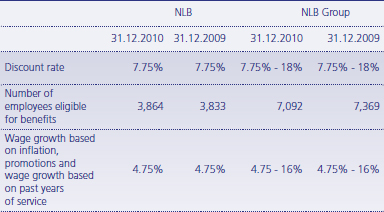
According to legislation, employees retire after 35-40
years of service, when, if they fulfil certain conditions,
they are entitled to a lump-sum severance payment.
Employees are also entitled to a long service bonus for
every ten years of service.
These obligations are measured at the present value of
future cash outflows considering future salary
increases and then apportioned to past and future
employee service based on benefit plan terms and
conditions. All gains and losses arising from changes in
assumptions and experience adjustments are
recognized immediately in the income statement.
The Group pays contributions to the state pension
schemes according to the local legislation. The Bank
contributes 8.85% of gross salaries. Once
contributions have been paid, the Group has no
further obligation. Contributions constitute costs in the
period to which they relate and are disclosed in labor
costs in the income statement.
2.29. Share capital
Dividends on ordinary shares
Dividends on ordinary shares are recognized in equity
in the period in which they are approved by the Bank’s
shareholders.
Treasury shares
If the Bank or other member of the Group purchases
the Bank’s shares, the consideration paid is deducted
from total shareholders’ equity as treasury shares. If
such shares are subsequently sold, any consideration
received is included in equity. If the Bank's shares are
purchased by the Bank itself or other Group entities,
the Bank creates reserves for treasury shares in equity.
Share issue costs
Costs directly attributable to the issue of new shares
are recognized in equity as a reduction in the share
premium account.
2.30. Segment reporting
Operating segments are reported in a manner
consistent with internal reporting to the executive
body, which makes decisions, regarding the allocation
of resources and assesses the performance of a specific
segment.
All transactions between business segments are
conducted on an arm’s length basis. Income and
expenses directly associated with each segment are
included in determining segment’s performance.
In accordance with IFRS 8, the Group has the following
reportable segments: banking Slovenia, banking
abroad, leasing, factoring and forfeiting, asset
management and other segments.
2.31. Critical accounting estimates and judgments in applying accounting policies
The Group's financial statements are influenced by accounting policies, assumptions, estimates and management judgement. The Group makes estimates and assumptions that affect the reported amounts of assets and liabilities within the next financial year. All estimates and assumptions required in conformity with IFRS are best estimates undertaken in accordance with the applicable standard. Estimates and judgements are evaluated on a continuing basis, and are based on part experience and other factors, including expectations with regard to future events.
a) Impairment losses on loans and advances
The Group reviews their loan portfolio to assess
impairment. In determining whether an impairment
loss should be recorded in the income statement,
Group verifies whether there are any data indicating
that there is a measurable decrease in the estimated
future cash flows from the portfolio of loans. This
evidence may include observable data indicating that
the solvency of borrowers has deteriorated or that
economic conditions and circumstances have
deteriorated. Future cash flows in a group of financial
assets are estimated based on past experience and
losses on assets with credit risk characteristics similar
to those assets in the group. Individual estimates are
based on projections of future cash flows taking into
account all relevant information regarding the financial
position and solvency of a borrower. Projected cash
flows are verified by an independent department. Lowvalue
exposures, including the majority of loans to
individuals, are verified collectively. The methodology
and assumptions used to estimate future cash flows
are reviewed regularly to reduce differences between
estimated and actual losses.
The Group uses a sensitivity analysis to assess the
impact of less probable negative events on
impairments and provisions. Results of the simulation
are based on the balance of loans and impairment as
at December 31, 2010 and provide an assessment of
required impairments within one year assuming the
realization of the defined scenario.
Stress test using transition matrices
In the scenario historical transition matrices for
financial institutions and other legal entities were used.
The matrices for legal entities were also used for
individuals. Exposure to the central government was
not subject to the stress test. The methodology used is
an extrapolation based on average transition matrices,
which were calculated for the period in which the
credit portfolio deteriorates. In addition, the transition
matrices were corrected in a manner that excludes the
possibility of client rating.
The scenario assumes that total credit exposure will
not change in the one year period and the rating
structure deterioration reflected through migration
matrices will require additional impairments. As a
result of the stress scenario the Bank will require
additional impairment of EUR 297 million and the
coverage of credit portfolio with impairments will
increase from 7.81% to 10.62%. For the Group the
same stress scenario results in an increase of
impairment by EUR 344 million and increase of the
coverage of credit portfolio with impairments from
8.62% to 10.25%.
b) Fair value of financial instruments
The fair values of financial investments traded on the
active market are based on current bid prices (financial
assets) or offer prices (financial liabilities).
The fair values of financial instruments that are not
traded on the active market are determined by using
valuation models. These include a comparison with
recent transaction prices, the use of a discounted cash
flow model, valuation based on an option pricing
model and other frequently used valuation models.
These valuation models reflect current market
conditions at the measurement date, which may not
be representative of market conditions either before or
after the measurement date. Management reviewed
all applied models as at the reporting date to ensure
they appropriately reflect current market conditions,
including the relative liquidity of the market and
applied credit spread. Changes in assumptions
regarding these factors could affect the reported fair
values of financial instruments held for trading and
available for sale financial assets.
The fair values of derivative financial instruments are
determined on the basis of market data (mark-tomarket),
in accordance with the methodology for the
valuation of derivative financial instruments. The
market exchange rates, interest rates, yield and
volatility curves used in valuation are based on the
market snapshot principle. Market data is saved daily
at 4 p.m. and later used for the calculation of the fair
values (market value, NPV) of financial instruments.
The Group applies market yield curves for valuation.
c) Available for sale equity instruments
Available for sale equity instruments are impaired, if
there has been a significant or prolonged decline in
fair value below historical cost. The determination of
what is significant or prolonged is based on
assessments. In making these assessments, the Group
takes into account several factors, including share price
volatility. Impairment may also be indicated by
evidence regarding deterioration in the financial
position of the instrument issuer, deterioration in
sector performance, changes in technology, and a
decline in cash flows from operating and financing
activities.
Had all the declines in fair value below cost been
considered significant or prolonged, the Bank would
have incurred additional impairment losses of EUR 85
thousand (2009: EUR 18,728 thousand), while the
Group would have incurred additional impairment
losses of EUR 256 thousand (2009: EUR 19,144
thousand) from the reclassification from the statement
of comprehensive income to the income statement for
the current year.
d) Held to maturity instruments
The Group classifies non-derivative financial assets with fixed or determinable payments and a fixed maturity as held to maturity investments. Before making this classification, the Group assesses its intention and ability to hold such investments to maturity. If the Group is unable to hold these investments until maturity, it must reclassify the entire group to as available for sale financial assets. The investments would therefore be measured at fair value, resulting in an increase in the value of investments of EUR 7,937 thousand (December 31, 2009: increase by EUR 18,927 thousand) and a corresponding increase in other comprehensive income.
e) Impairment of investment in subsidiaries, associates and joint ventures
The process of identifying and assessing the impairment of goodwill and other intangible assets is inherently uncertain, as the forecasting of cash flows requires the significant use of estimates, which themselves are sensitive to the assumptions used. The review of impairment represents management's best estimate of the factors such as:
- Future cash flows from individual investments depend on estimated cash flow for those periods for which formal plans are available and on assumptions regarding sustainability of and growth in cash flows in the future. The cash flows used represent management's assessment of future performance at the time of testing.
- The discount rate derived from the capital asset pricing model and used to discount future cash flows is based on the cost of equity allocated to an individual investment. The discount rate reflects the impact of range of financial and economic variables, including the risk-free rate and risk premium. The value of variables used is subject to fluctuations outside management's control.
If recoverable amount is value in use, the discounted
cash flow method is used. When the recoverable
amount is fair value less costs to sell, the value was
determined based on binding offers and the estimated
liquidation value.
If the discount rates in the discounted cash flows
model differ by +/- 1%, the estimated value in use of
the equity investments would be lower in case of
increased discount rate by a maximum of EUR 6.5
million and in case of decreased discount rate the
value in use of equity investments would be higher by
a maximum of EUR 8.3 million.
f) Goodwill and other intangible assets
In the consolidated financial statements, goodwill and
other intangible assets are allocated to cash-generating
units (hereinafter: CGUs), which represent the lowest
level within the Group at which these assets are
monitored by management. Each Group entity
presents a separate CGU. The recoverable amount of
each CGU was determined based on value-in-use
calculations. The calculation of value in use is based on
cash flow projections in the three-year financial plans
approved by management. The Group performed a
test for impairment of goodwill and other intangible
assets at the end of the year for all subsidiaries.
Additional information regarding impairment testing of
goodwill and other intangible assets is disclosed in
note 6.13.
The goodwill for NLB Prishtina, Priština, represents
individually significant amount of goodwill in the
Group and amounts to EUR 9,738 thousand. When
testing for possible impairment, the following
assumptions were used: discount rate of 13%, growth
rate for residual value 3.5% p.a. and target capital
ratio of 17%. According to the test goodwill was not
impaired. If the discount rate increases by 1
percentage point, the recoverable amount of the
goodwill would be lower by EUR 2,803 thousand.
g) Taxes
The Group operates in countries governed by different laws. The deferred tax assets recognized at December 31, 2010 are based on profit forecasts for the next five-year period and take into account expected manner of recovery of the assets, that is, whether the value will be recovered through use, sale or liquidation. Changes in the assumptions as to the likely manner of recovery of assets could lead to the recognition of currently unrecognized deferred tax assets or to the derecognition of previously created deferred tax assets. Failure to meet profit forecasts could impact previously created deferred tax assets. The Group believes that this effect would be immaterial since the majority of deferred tax assets relates to tax losses which, in accordance with the Slovenian Corporate Income Tax Act, can be carried forward indefinitely.
2.32. Implementation of new and revised International Financial Reporting Standards
During the current year, the Group adopted all new
and revised standards and interpretations issued by the
International Accounting Standards Board (hereinafter:
the IASB) and the International Financial Reporting
Interpretations Committee (hereinafter: the IFRIC) that
are effective for accounting periods beginning on
January 1, 2010.
The following new standards and amendments to
existing standards were adopted early
- IAS 24 (amendment) - Related Party Disclosures (effective for annual periods beginning on or after January 1, 2011 with earlier application permitted). The revised standard simplifies the definition of a related party and provides a partial exemption from the disclosure requirements for government-related entities. If the exemption is applied, the entity shall disclose the nature and amount of each individually significant transaction. The amendment impacts presentation.
Accounting standards and amendments to existing standards effective for annual periods beginning on or after January 1, 2010 that were endorsed by EU and adopted by us
- IFRS 2 (amendment) - Group Cash-settled Sharebased Payment Transactions, Share-based Payment (effective for annual periods beginning on or after January 1, 2010). The amendments provide a clear basis to determine the classification of share-based payment awards in both consolidated and separate financial statements. The amendments incorporate into the standard the guidance in IFRIC 8 and IFRIC 11, which are withdrawn. The amendments expand on the guidance given in IFRIC 11 to address plans that were previously not considered in the interpretation. The amendments also clarify the defined terms in the Appendix to the standard. The amendment does not affect the Group’s financial statements.
- IAS 39 (amendment) – Financial instruments: Recognition and measurement – Eligible hedged items (effective for annual periods beginning on or after July 1, 2009 with earlier application permitted). The amendment provides guidance for two situations. With the designation of a one sided risk in a hedged item, IAS 39 concludes that a purchased option designated in its entirety as the hedging instrument of a one sided risk will not be perfectly effective. The designation of inflation as a hedged risk or portion is not permitted except in particular situations. The amendment does not significantly affect the Group’s financial statements.
- IFRIC 17 – Distributions of non-cash assets to owners (effective for annual periods beginning on or after July 1, 2009 with earlier application permitted). This addresses how the non-cash dividends distributed to shareholders should be measured. A dividend obligation is recognized when the dividend was authorized by the appropriate entity and is no longer at the discretion of the entity. This dividend obligation should be recognized at the fair value of the net assets to be distributed. The difference between the dividend paid and the amount carried forward of the net assets distributed should be recognized in profit and loss. The interpretation does not affect the Group’s financial statements.
- IFRIC 18 - Transfer of assets from customers (effective for annual periods beginning on or after July 1, 2009 with earlier application permitted). This clarifies how to account for transfer of items of property, plant and equipment by entities that receive such transfers from their customers. The interpretation also applies to agreements in which an entity receives cash from a customer when that amount of cash must be used only to construct or acquire an item of property, plant and equipment, and the entity must than use that item to provide the customer with ongoing access to supply of goods and or services. The interpretation does not affect the Group’s financial statements.
- IFRS 1 (amendment) - First-time Adoption of International Financial Reporting Standards (effective for the first IFRS financial statements for a period beginning on or after July 1, 2009). The revised IFRS 1 retains the substance of its previous version but within a changed structure in order to make it easier for the reader to understand and to better accommodate future changes. The amendment does not affect the Group’s financial statements.
- IFRS 1 (amendment) - Additional Exemptions for First-time Adopters, First-time Adoption of IFRS (effective for annual periods beginning on or after January 1, 2010). The amendments exempt entities using the full cost method from retrospective application of IFRSs for oil and gas assets and also exempt entities with existing leasing contracts from reassessing the classification of those contracts in accordance with IFRIC 4, 'Determining Whether an Arrangement Contains a Lease' when the application of their national accounting requirements produced the same result. The amendment does not affect the Group’s financial statements.
- Annual improvements to the IFRS 2009. The improvements consist of a mixture of substantive changes and clarifications. Amendments to IFRS 2, IAS 38, IFRIC 9 and IFRIC 16 are effective for annual periods beginning on or after July 1, 2009. Amendment in IFRS 2 clarifies, that contribution of business in common control transactions and formation of joint ventures are not within the scope of IFRS 2. IAS 38 is supplemented for measuring the fair value of an intangible asset, acquired in a business combination. Amendment in IFRIC 9 excludes embedded derivatives in contracts acquired in common control transaction and joint ventures from its scope. Amended IFRIC 16 removes the restriction that hedging instrument may not be hold by the foreign operation, that itself is being hedge. Amendments that are affective for annual periods beginning on or after January 1, 2010, with earlier application permitted are amendments to IFRS 5, IFRS 8, IAS 1, IAS 7, IAS 17, IAS 18, IAS 36 and IAS 39. IFRS 5 sets disclosure requirements for non-current assets or disposal groups classified as held for sale or discontinued operations. IAS 7 is amended, such that only expenditure which results in a recognized asset is eligible for classification as investing activities. IAS 17 permits the classification of certain long-term land leases as finance leases even without transfer of ownership of the land at the end of the lease. IAS 18 provides additional guidance for determining whether an entity acts as a principal or an agent. IAS 36 clarifies that a cash generating unit shall not be larger than an operating segment before aggregation. Amended IAS 39 includes in its scope option contracts that could result in business combinations, clarifies the period of reclassifying gains or losses on cash flow hedging instruments (if a hedged instrument is a forecast transaction) from other comprehensive income to profit or loss for the year and states that a prepayment option is closely related to the host contract if upon exercise the borrower reimburses economic loss of the lender. The amendments do not significantly affect the Group’s financial statements.
Accounting standards and amendments to existing standards effective for annual periods after January 1, 2010 that were endorsed by EU but not early adopted by us
- IAS 32 (amendment) - Classification of Rights Issues (effective for annual periods beginning on or after February 1, 2010). The amendment exempts certain rights issues of shares with proceeds denominated in foreign currencies from classification as financial derivatives. The amendment does not affect the Group’s financial statements.
- IFRIC 19 - Extinguishing Financial Liabilities with Equity Instruments (effective for annual periods beginning on or after July 1, 2010). This IFRIC clarifies the accounting when an entity renegotiates the terms of its debt with the result that the liability is extinguished through the debtor issuing its own equity instruments to the creditor. A gain or loss is recognized in profit or loss based on the fair value of the equity instruments compared to the carrying amount of the debt. The amendment does not affect the Group’s financial statements.
- IFRIC 14 (amendment) - Prepayments of a Minimum Funding Requirement (effective for annual periods beginning on or after January 1, 2011). This amendment will have a limited impact as it applies only to entities that are required to make minimum funding contributions to a defined benefit pension plan. It removes an unintended consequence of IFRIC 14 related to voluntary pension prepayments when there is a minimum funding requirement. The amendment does not affect the Group’s financial statements.
- IFRS 1 (amendment) - Limited Exemption from Comparative IFRS 7 Disclosures for First-time Adopters (effective for annual periods beginning on or after July 1, 2010). Existing IFRS preparers were exempt from presenting comparative information for the new disclosures required by the March 2009 amendments to IFRS 7, Financial Instruments: Disclosures. This amendment to IFRS 1 provides first-time adopters with the same transitional provisions as included in the amendment to IFRS 7. The amendment does not affect the presentation aspects.
- Annual improvements to IFRS 2010. The improvements consist of a mixture of substantive changes and clarifications and are affective for annual periods beginning on or after January 1, 2011, with earlier application permitted. IFRS 1 First-time Adoption of the IFRS and IFRIC 13 Customer Loyalty Programmes do not affect the Group’s financial statements. IAS 27 clarifies the transition rules for amendments to IAS 21, 28 and 31 made by the revised IAS 27 (as amended in January 2008). Amendments in IAS 34 refer to interim financial reporting and affect the presentation of the Group’s interim financial statement. Disclosure requirements in IFRS 7 emphasize the link between quantitative and qualitative disclosures regarding the nature and extent of financial risk and eliminates disclosures for renegotiated loans that would otherwise be past due or impaired, while disclosures regarding the fair value of collateral is replaced with a more general requirement, i.e. clarification of effect of collateral on mitigating the credit risk. Amendments to IFRS 3 require measurement of non-controlling interests at fair value, in certain cases provides guidance on an acquirer’s sharebased payment arrangements that were not replaced or were voluntarily replaced as a result of a business combination, and requires that the contingent considerations from business combinations that occurred before the effective date of revised IFRS 3 are calculated using the previous IFRS 3. The amendment in IAS 1 clarifies the requirements for the presentation and content of the statement of changes in equity. Reconciliation between the carrying amount at the beginning and the end of the period for each component of equity must be presented in the statement of changes in equity, but its content is simplified by allowing an analysis of other comprehensive income by item for each component of equity to be presented in the notes. The amendments do not significantly affect the Group’s financial statements.
Accounting standards and amendments to existing standards issued but not endorsed by EU:
- IFRS 9 - Financial Instruments IFRS 9 issued in
November 2009 replaces those parts of IAS 39
relating to the classification and measurement of
financial assets. IFRS 9 was further amended in
October 2010 to address the classification and
measurement of financial liabilities. Key features of
the standard are as follows:
- Financial assets are required to be classified into two measurement categories: those to be measured subsequently at fair value, and those to be measured subsequently at amortized cost. The decision is to be made at initial recognition. The classification depends on the entity’s business model for managing its financial instruments and the contractual cash flow characteristics of the instrument.
- An instrument is subsequently measured at amortized cost only if it is a debt instrument and both (i) the objective of the entity’s business model is to hold the asset to collect the contractual cash flows, and (ii) the asset’s contractual cash flows represent only payments of principal and interest (i.e. it bears only “basic loan features”). All other debt instruments are to be measured at fair value through profit or loss.
- All equity instruments are to be measured subsequently at fair value. Equity instruments that are held for trading will be measured at fair value through profit or loss. For all other equity investments, an irrevocable election can be made at initial recognition, to recognize unrealized and realized fair value gains and losses through other comprehensive income rather than profit or loss. There is to be no recycling of fair value gains and losses to profit or loss. This election may be made on an instrument-byinstrument basis. Dividends are to be presented in profit or loss, as long as they represent a return on investment.
- Most of the requirements in IAS 39 for classification and measurement of financial liabilities were carried forward unchanged to IFRS 9. The key change is that an entity will be required to present the effects of changes in own credit risk of financial liabilities designated as at fair value through profit or loss in other comprehensive income.
- Adoption of IFRS 9 is mandatory from January 1, 2013, while earlier adoption is permitted, but the EU has not yet endorsed it. The Group is considering the implications of the standard, the impact on the Group and the timing of its adoption.
- IFRS 7 (amendment) - Disclosures, Transfers of Financial Assets (effective for annual periods beginning on or after July 1, 2011). The amendment requires additional disclosures in respect of risk exposures arising from transferred financial assets. The amendment includes a requirement to disclose by class of asset the nature, carrying amount and a description of the risks and rewards of financial assets that have been transferred to another party yet remain on the entity's statement of financial position. Disclosures are also required to enable a user to understand the amount of any associated liabilities, and the relationship between the financial assets and associated liabilities. Where financial assets have been derecognized but the entity is still exposed to certain risks and rewards associated with the transferred asset, additional disclosure is required to enable the effects of those risks to be understood. The Group is currently assessing the impact of the amended standard on disclosures in its financial statements.
- IAS 12 (amendment) – Deferred Tax: Recovery of Underlying assets – (effective for annual period beginning on or after January 1, 2012). The amendment relates to investment property measured at fair value. The investment will be recovered with the continuing use if the presumption of recovery through sale will be overcome. The deferred tax assets are calculated based on the tax rate that is consistent with the expected manner of recovery or settlement. The amendments replace Interpretation SIC 21 Income Taxes - Recovery of revalued Non-Depreciable differences. The amendment does not affect on the Group’s financial statements.
- IFRS 1 (amendment) - First time adoption of International Financial Reporting Standards – Severe Hyperinflation and Removal of Fixed Dates for First-time Adopters (effective July 1, 2011). The amendment does not affect the Groups financial statements.
3. CHANGES IN SUBSIDIARY HOLDINGS
Changes in 2010
a) Acquisitions of additional interests in existing subsidiaries
NLB increased its ownership interest in Plan, Banja Luka from 32.31% to 39.14%, consideration given amounted to EUR 90 thousand; consequently Group increased its ownership interest from 81.31% to 88.14%.
b) Mergers of Group entities
- In May 2010 LHB Finance, Ljubljana merged with NLB. Financial statements of the LHB Finance were included in Bank's financial statements with January 1, 2010;
- NLB Leasing, Ljubljana sold its 100% ownership interest in NLB Real Estate, Beograd to NLB Srbija, Beograd. In June 2010 NLB Real Estate, Beograd merged with NLB Srbija, Beograd.
c) Other changes
- The increase of share capital was registered in FINDO, Domžale, LHB Internationale Handelsbank, Frankfurt, NLB Montenegrobank, Podgorica, NLB Bank Sofia, Sofija, NLB Srbija, Beograd, NLB bank, Beograd and NLB Leasing, Ljubljana;
- NLB Leasing, Ljubljana sold its 100% ownership interest in NLB Leasing, Beograd to NLB;
- NLB Tuzlanska banka, Tuzla sold its 40% ownership interest in CBS Invest, Sarajevo to NLB;
- LHB Immobilien, Frankfurt sold its 60% ownership interest in CBS Invest, Sarajevo to NLB;
- NLB bank, Beograd sold its 24.61% ownership interest in Tekig Invest, Beograd.
Changes in 2009
a) Acquisitions of additional interests in existing bank subsidiaries
NLB increased its ownership interest in following bank subsidiaries:
- NLB Razvojna banka, Banja Luka from 81.50% to 99.85%, consideration given amounted to EUR 20,170 thousand;
- LHB Internationale Handelsbank, Frankfurt from 98.95% to 100%, consideration given amounted to EUR 810 thousand;
- NLB banka, Beograd from 92.54% to 99.98%, consideration given amounted to EUR 6,844 thousand (including purchase of 0.5% treasury shares).
b) Other changes
- NLB Leasing, Ljubljana sold its 75.10% ownership interest in OL Nekretnine, Zagreb to NLB Leasing Koper, Koper;
- LHB Internationale Handelsbank, Frankfurt sold its 100% ownership interest in LHB Finance, Ljubljana to NLB;
- LHB Internationale Handelsbank, Frankfurt sold its 16.86% ownership interest in NLB banka, Beograd to NLB;
- LHB Trade, Zagreb sold its 32.31% ownership interest in Plan, Banja Luka to NLB;
- The increase of share capital was registered in NLB Nova Penzija, Beograd, NLB Montenegrobanka, Podgorica, NLB Banka Sofia, Sofija, LHB Finance, Ljubljana, NLB banka, Beograd, NLB Tuzlanska Banka, Tuzla and LHB Internationale Handelsbank, Frankfurt;
- LHB Consult, Beograd was liquidated;
- Nov penziski fond, Skopje was renamed to NLB Nov penziski fond, Skopje;
- NLB West-East Bank, Sofija was renamed to NLB Banka Sofia, Sofija.
4. EVENTS AFTER REPORTING DATE
In accordance with the adopted strategy of the NLB
Group for the 2010-2015 period, the Bank initiated a
process of increase in the Bank’s capital in the amount
of maximum of EUR 250 million. For these purposes it
published the prospectus as at March 7, 2011 and
started the public offering process. The increase in
capital should, together with other elements of the
strategy, enable the fulfillment of regulatory
requirements and faster achievement of strategic goals
in the field of capital. In accordance with Slovene
legislation, existing shareholders will have the priority
right to subscribe new shares (until March 21, 2011) in
the proportion to their stakes in the Bank's share
capital, the rest of the shares will be offered to the
public (until March 30, 2011) if the current
shareholders do not subscribe for all the shares.
Capital increase was authorized by The European
Commission under EU state aid rules. The Commission
found the recapitalization plan to be well-targeted,
limited to the minimum necessary and proportional.
Therefore, the Commission temporarily authorized the
measure as emergency aid until it will have reached a
final decision on NLB's restructuring plan, which must
be submitted by the Slovenian authorities within six
months.
5. NOTES TO THE INCOME STATEMENT
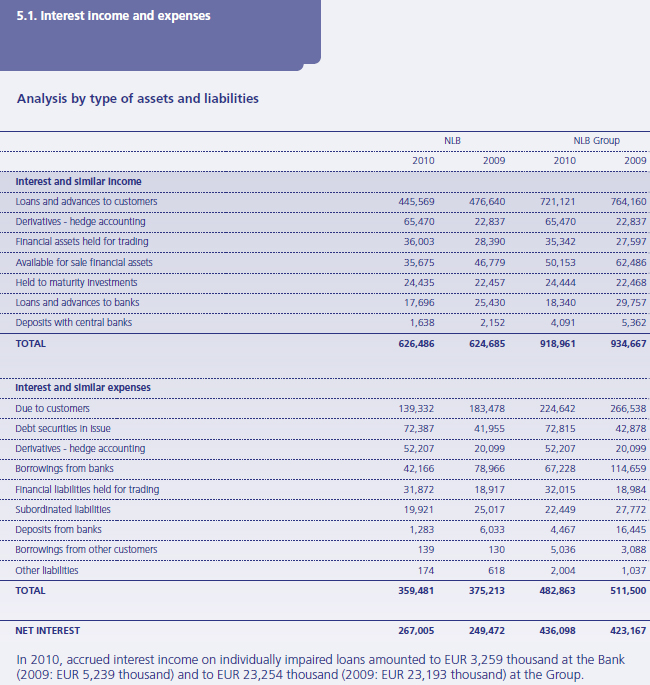
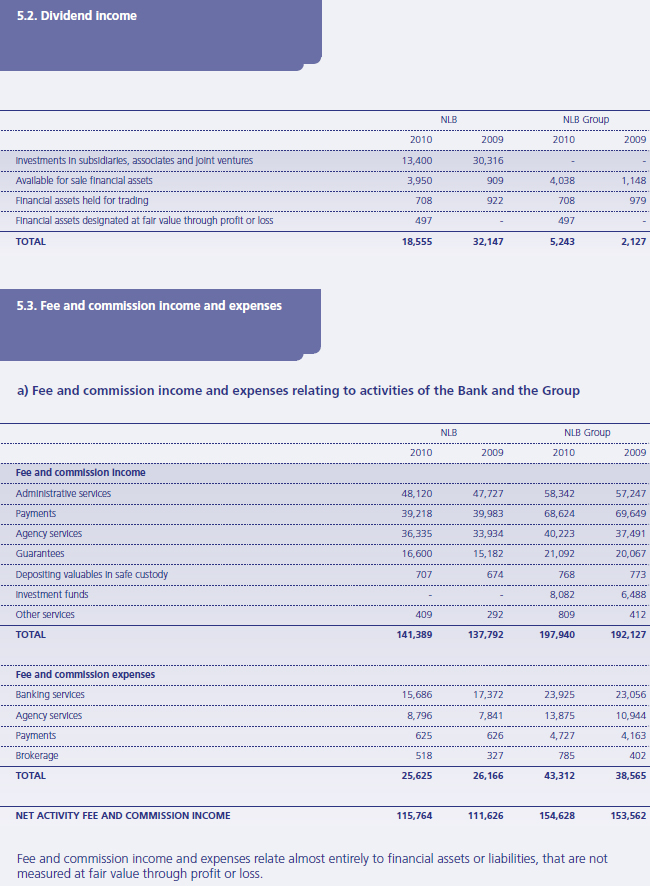
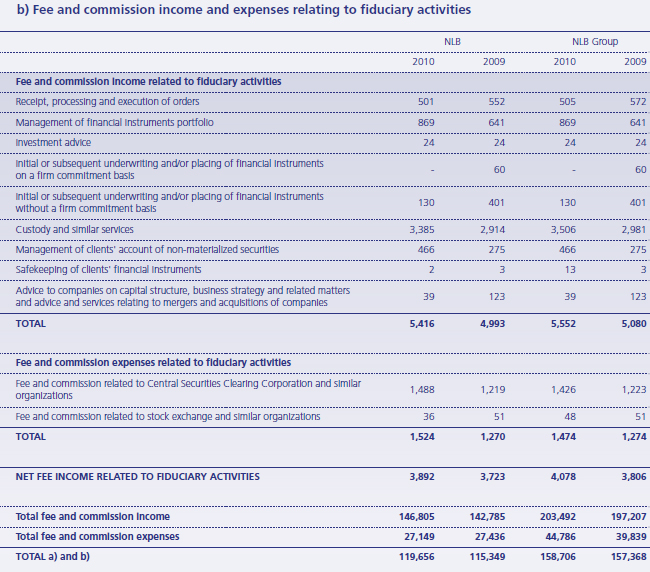

Gains less losses from available for sale financial assets of NLB Group include gain on sale of previously impaired
debt instruments in amount of EUR 1,525 thousand (2009: EUR 0).
Net foreign exchange translation gains on financial assets and liabilities not classified as at fair value through profit
or loss amounted to EUR 35,641 thousand at the Bank in 2010 (2009: net losses EUR 5,142 thousand) and to EUR
32,505 thousand in the Group (2009: net losses EUR 5,984 thousand).
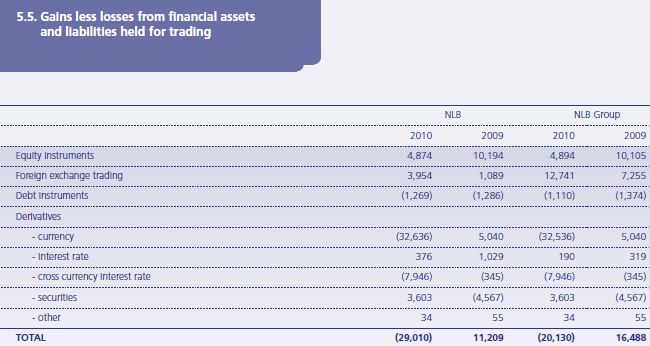
The Group uses currency derivatives to hedge its currency exposure. Therefore, their effects need to be considered in relation to foreign exchange differences in the income statement. From a business perspective, these derivatives represent effective hedging instruments that are not accounted for using hedge accounting principles. They are accounted for in the Group’s financial statements as financial instruments held for trading.
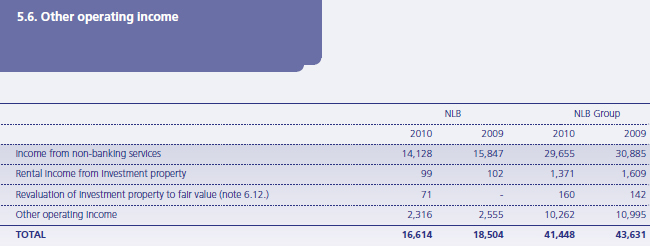
Income from non-banking services includes income from IT services, income from operating leases of movable property and income from the disposal of repossessed leased assets.
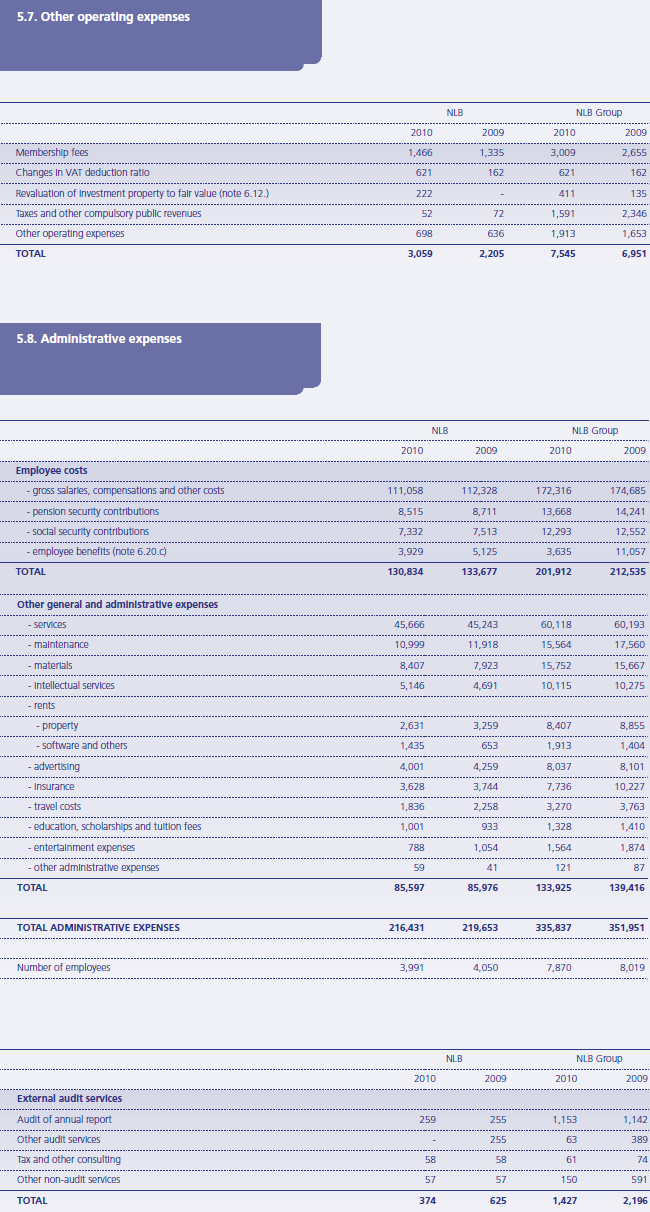
External audit services include payments to the Bank’s statutory auditor in the amount of EUR 291 thousand (2009: EUR 500 thousand), while the Group made payments to the auditor in the amount of EUR 1,099 thousand (2009: EUR 1,890 thousand).
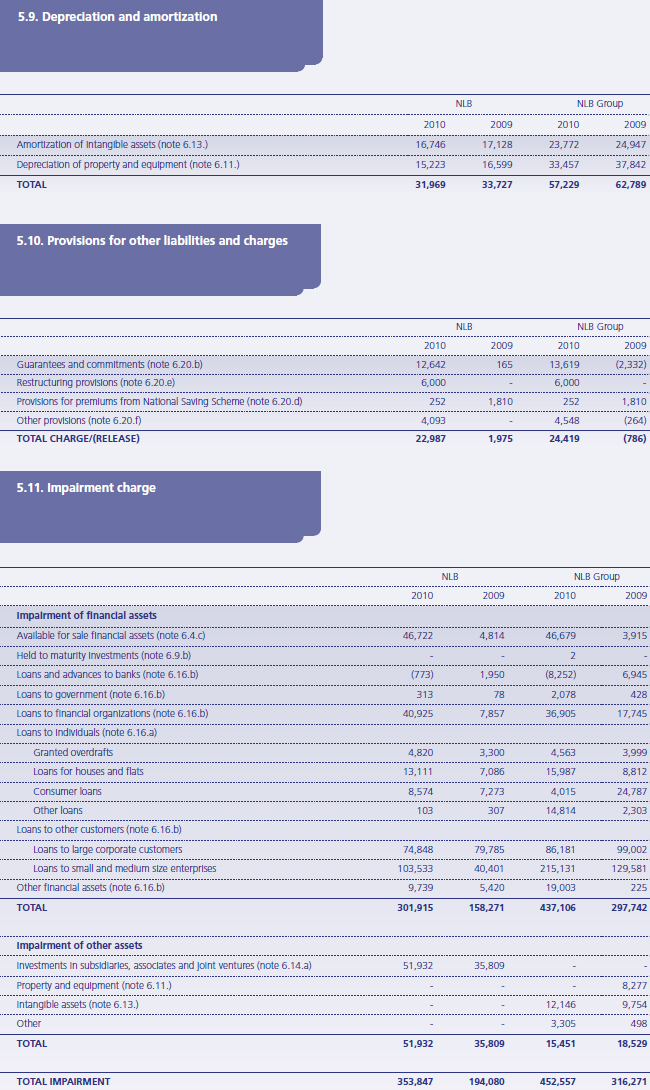
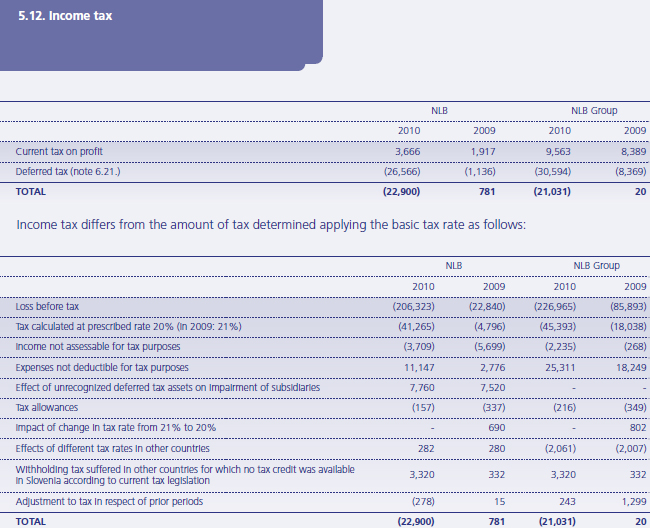
Income tax rates within the Group range from 9% to 30%.
The majority of income not recognized for tax purposes relates to dividend income, which can be deducted from
the taxable profit, provided that all conditions prescribed by tax legislation are met.
Deferred tax assets were not recognized on temporary differences arising on impairment of investments in
subsidiaries amounting to EUR 74.61 million as of December 31, 2010 (December 31, 2009: EUR 35.81 million).
The Group has no intention of disposing of these subsidiaries in foreseeable future.
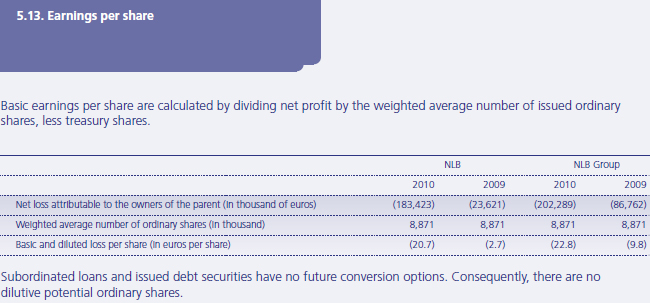
6. NOTES TO THE STATEMENT OF FINANCIAL POSITION

Slovenian banks are required to maintain an obligatory reserve with the Bank of Slovenia, relative to the volume
and structure of its customer deposits. Other banks in the Group maintain an obligatory reserve in accordance
with local legislations.
The Bank of Slovenia’s current requirement regarding the calculation of the obligatory reserve amount is 2% of all
time deposits with a maturity up to two years.
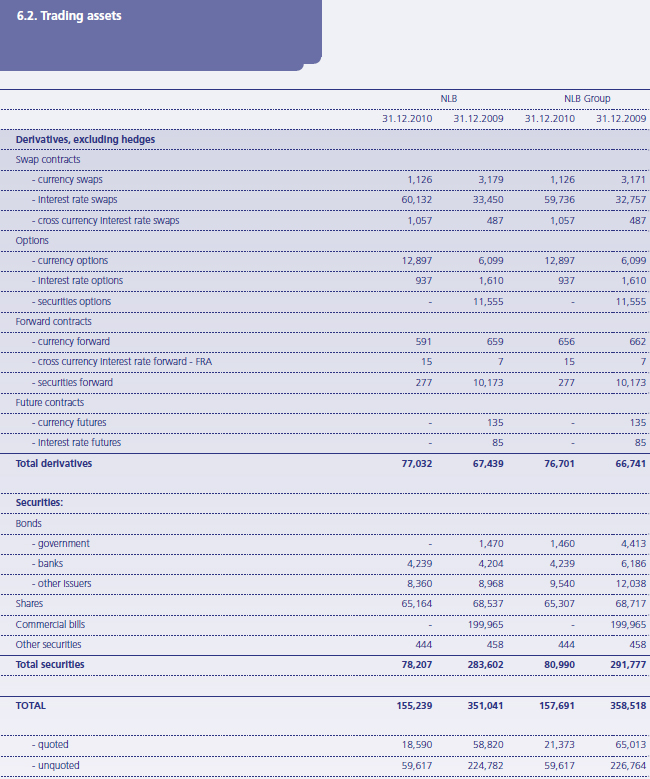
The Bank had no trading assets as at December 31, 2010 and December 31, 2009 with original maturity of up to
three months. The Group disclosed trading assets with an original maturity up to three months in the amount of
EUR 334 thousand (December 31, 2009: EUR 2,187 thousand), which are included in cash equivalents.
The notional amounts of derivative financial instruments are disclosed in note 6.28.d).
During the year 2009 the Bank and the Group reclassified certain bonds from trading category to loans and
receivables group. The Bank and the Group reclassified high quality corporate bonds that are not traded in the
market and for which it has a positive intent and ability to hold for the foreseeable future or until maturity rather
than trade in the short term.
The following table illustrates the carrying values and fair values of the assets reclassified:

The effective interest rates, determined on the day the bonds were reclassified, range from 4.15% - 4.23%.
Interest income in 2010 amounted to EUR 4,471 thousand (2009: EUR 2,836 thousand).
If the financial instruments had not been reclassified, the fair value gain that would have been recognized in 2010
amounts to EUR 1,698 thousand (2009: loss EUR 6,575 thousand).
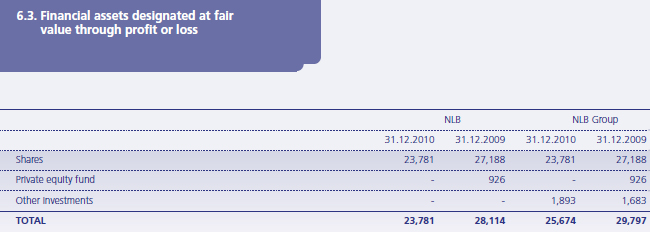
Among financial assets designated at fair value through profit or loss the Group disclosed mainly shares for which it has entered into derivative contracts. Designation as at fair value through profit or loss significantly reduces a measurement inconsistency that would otherwise arise. Gains less losses from financial assets designated at fair value through profit or loss almost entirely relate to valuation of shares.
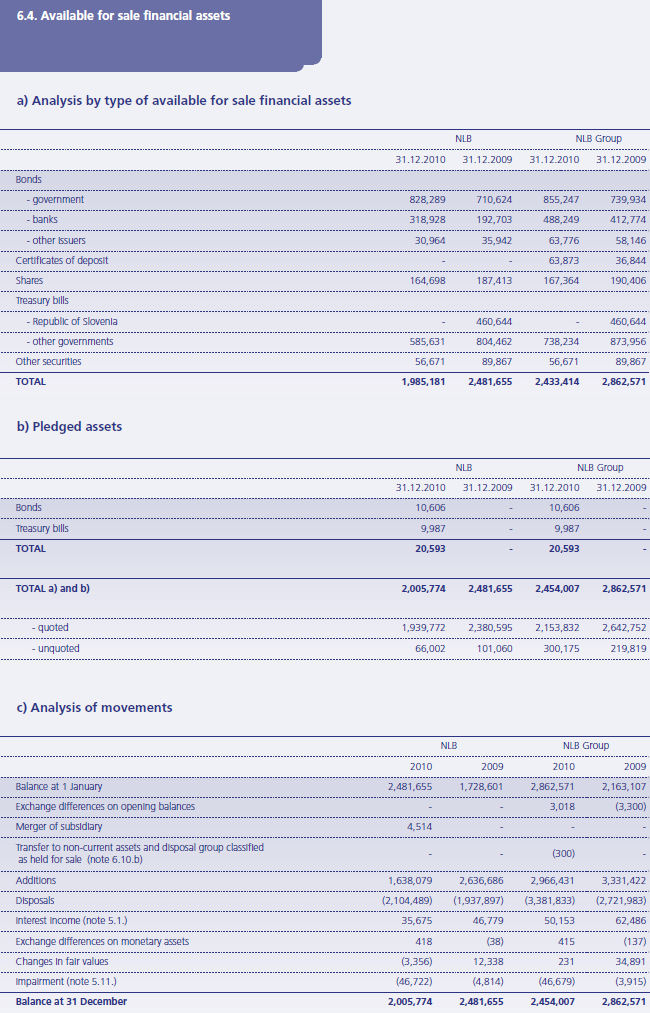
The Bank had no available for sale financial assets with an original maturity of up to three months as at December
31, 2010 and as at December 31, 2009. As at December 31, 2010, the Group has available for sale financial
assets with an original maturity of up to three months in the amount of EUR 83,390 thousand, which are included
in cash equivalents (December 31, 2009: EUR 57,583 thousand).
The value of equity instruments that the NLB and the Group obtained by taking possession of collateral held as
security and recognized them in the statement of financial position is EUR 139,551 thousand (December 31,
2009: EUR 156,756 thousand).
Due to a decline in fair values, the Bank created impairments relating to equity securities in the amount of EUR
45,924 thousand (2009: EUR 4,814 thousand), while the Group created impairments in the amount of EUR
45,701 thousand (2009: EUR 4,820 thousand).
As at December 31, 2010 the Group includes financial investments with more than 20% interest in equity in
amount of EUR 35,418 thousand, that are not consolidated using the equity method, due to the fact, that the
Group does not have significant influence.
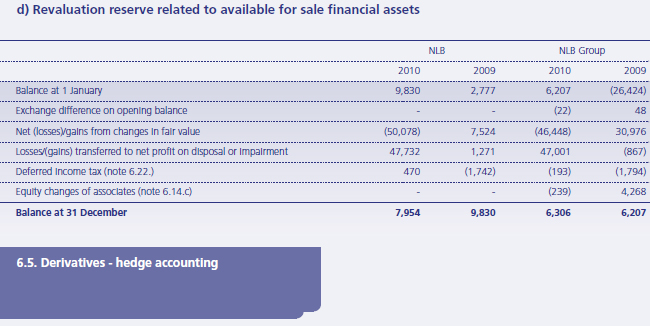
The Group manages interest rate risk in two ways: fair value micro hedge and cash flow micro hedge. The Group
measures hedge effectiveness by using the dollar-offset method.
The Group hedges its interest rate exposure by using different financial instruments (e.g. IRS, FRA, OIS, IR futures).
However, only interest rate swaps were used for purpose of hedge accounting (i.e. fair value and cash flow
hedging).
The Group measures its interest rate exposure by using a repricing gap analysis and by calculating the sensitivity of
statement of financial position and off-balance sheet items in terms of the economic value of equity. For a
portfolio of banking book securities a duration limit is set.
The Group uses various derivatives to hedge open positions in individual time buckets. Long positions are currently
more common, meaning more fair value hedges on the assets side, i.e. the swapping of a fixed interest rate for a
variable interest rate. The Group also hedges cash flows, primarily on the liability side, where variable interest rates
are swapped for fixed interest rates.
The Group rarely hedges the fair value of liabilities. Nevertheless, some fixed rate securities were hedged in this
manner, swapping the fixed interest rate of issued bonds with a variable rate.
The cash flows of hedging instruments (derivatives) match the cash flows of the hedged item (principal terms
match) in all hedging relationships.
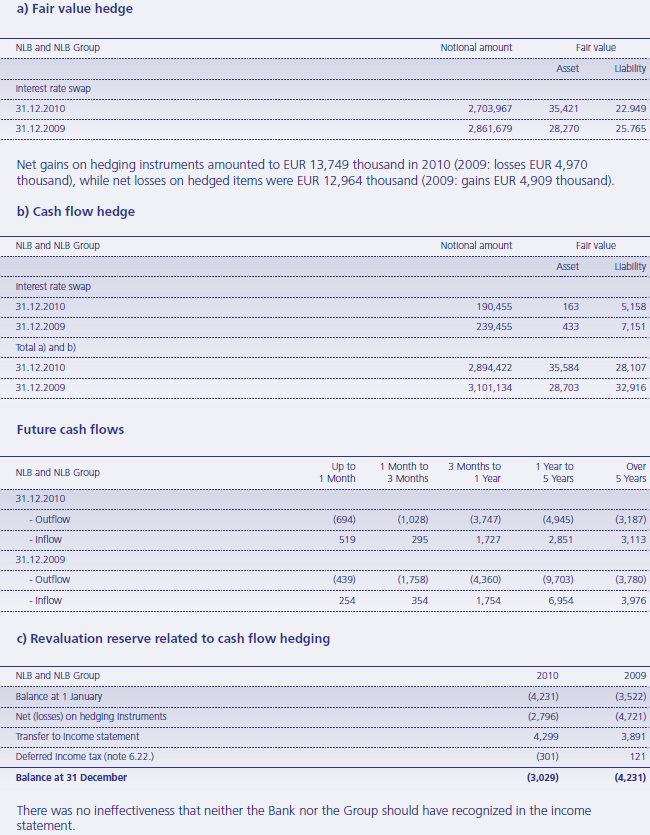

IFRS 7 specifies a fair value hierarchy with a respect to the inputs and assumptions used to measure financial instruments at fair value. Observable inputs reflect market data obtained from independent sources, while unobservable inputs reflect the assumption of the Bank and the Group. The fair value hierarchy comprises the following levels:
- Level 1 – Quoted prices (unadjusted) on active markets. This level includes listed equity securities, debt instruments, financial derivatives and points of investment funds.
- Level 2 – Inputs other than the quoted prices included in Level 1 that are observable for an instrument, either directly (i.e. prices) or indirectly (i.e. derived from prices). The source of input parameters, such as yield curves and counterparty credit ratings, is Reuters.
- Level 3 – Inputs for an instrument that are not based on observable market data. This level includes non-tradable shares and bonds and derivatives associated with these investments.
This hierarchy requires the use of observable market data when available. The Group considers relevant and observable market prices in its valuations where possible.
a) Financial instruments, measured at fair value in the financial statements
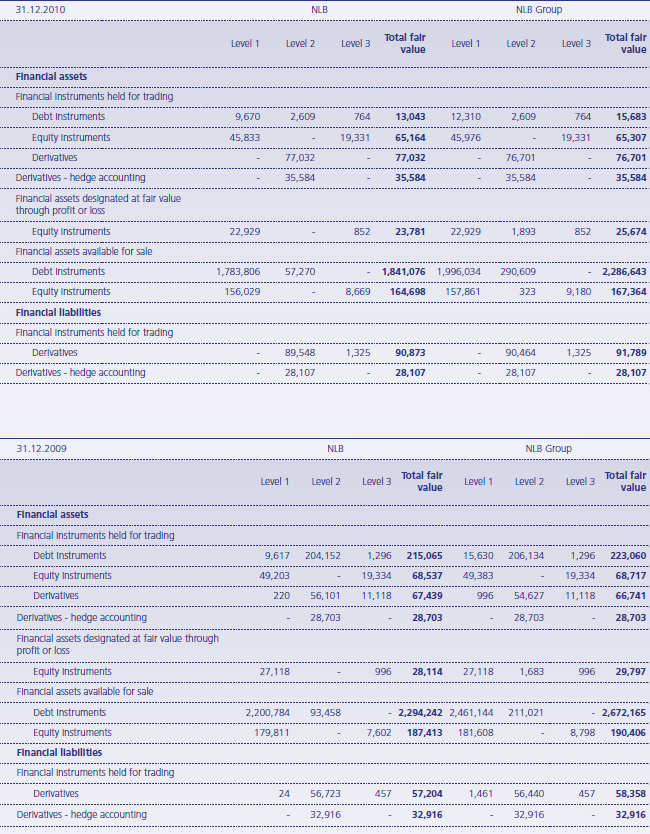
b) Transfer of financial instruments between levels of valuation
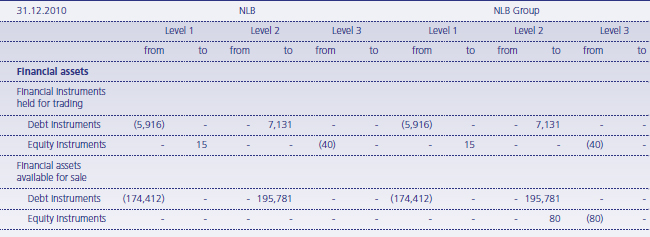
According to the fair value hierarchy, the Group reclassified financial assets from Level 1 to Level 2, due to a significant lower turnover with these securities on active markets. Instead of unadjusted quoted prices, fair value of these securities is measured according to the SWAP curves. The amounts reclassified present carrying values as at December 31, 2009 (“from”) and December 31, 2010 (“to”).
c) Financial instruments in 3rd level
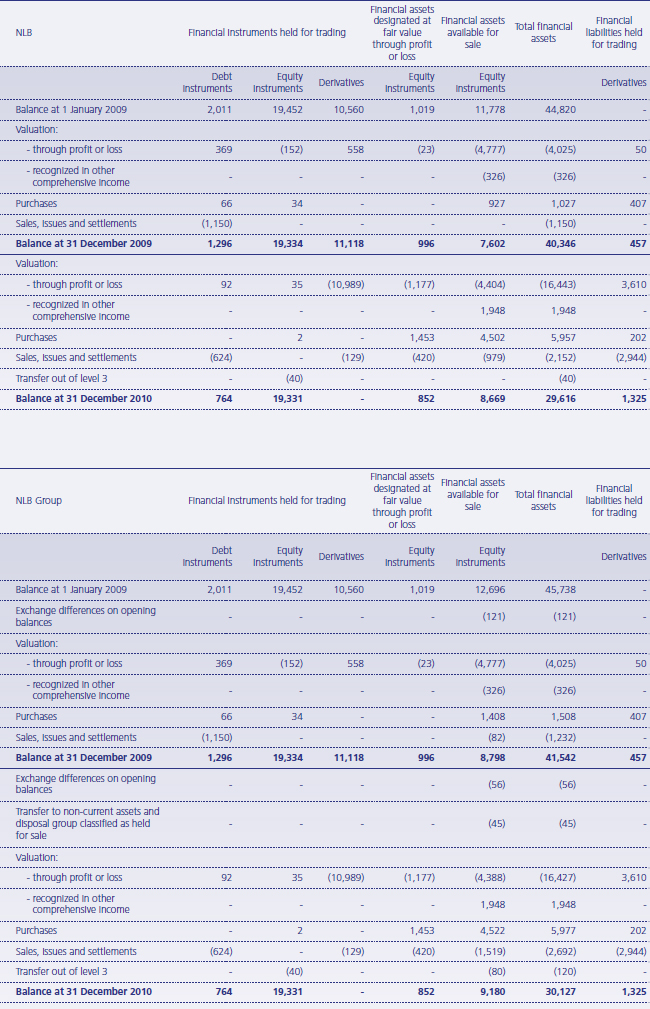
For financial instruments that are as at December 31, 2010 in Level 3, the Group recognized the following effects:
- for financial instruments measured at fair value through profit or loss, a valuation loss in the amount of EUR 1,092 thousand, recognised in income statement; and
- for available for sale financial instrument, a valuation loss in the amount of EUR 3,957 thousand and positive valuation in the amount of EUR 1,948 thousand recognised in other comprehensive income.
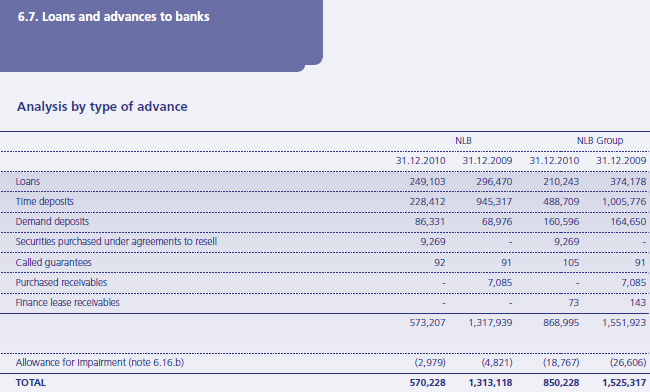
The Bank disclosed loans and advances to banks with an original maturity of up to three months, which are included in cash equivalents in the amount of EUR 236,649 thousand (December 31, 2009: EUR 569,757 thousand), while in the Group disclosed similar loans and advances in the amount of EUR 580,737 thousand (December 31, 2009: EUR 892,882 thousand).
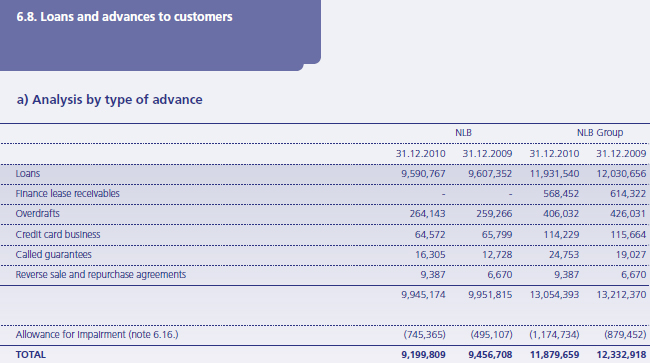
The Group records securities received under repurchase agreements as a collateral in off-balance sheet (i.e. it becomes the legal owner of said securities), while the borrower is entitled to associated coupon interest and dividends. The Group did not sell or pledge any of the securities it received as collateral during the financial years presented.
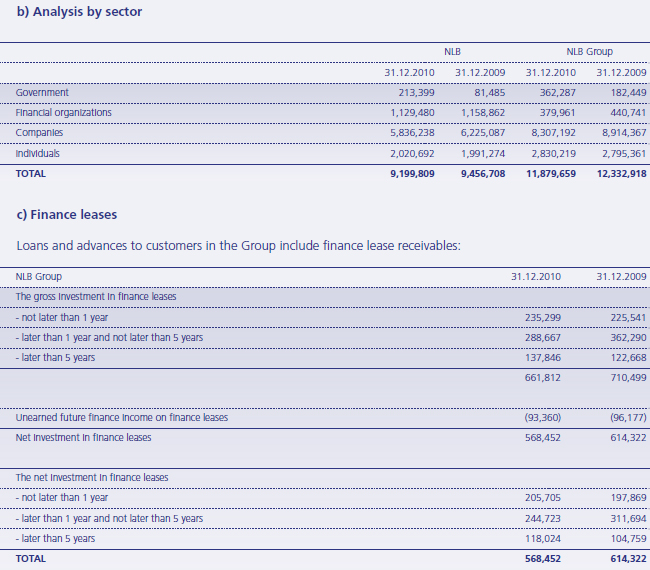
The Bank does not perform finance lease transactions.
The allowance for unrecoverable finance lease receivables included in the provision for loan losses amounted to
EUR 60,317 thousand (December 31, 2009: EUR 38,645 thousand).
Finance and operating lease transactions are carried out by the Group through specialized subsidiaries that offer a
wide range of financing such as car leasing, real estate leasing, leasing of commercial and production equipment
etc.
The majority of the lease agreements entered into by Group as lessor contracts are finance lease agreements
(operating leases account for less than 10% of all lease agreements). The majority of agreements are concluded
for a non-cancellable period of between 48 and 60 months, with an unguaranteed residual value representing a
purchase option typically between 1.6% and 2% of the gross investment.
Finance and operating leases of entity vehicles and operating leases of business premises represent the majority of
agreements in which the Group act as lessee.
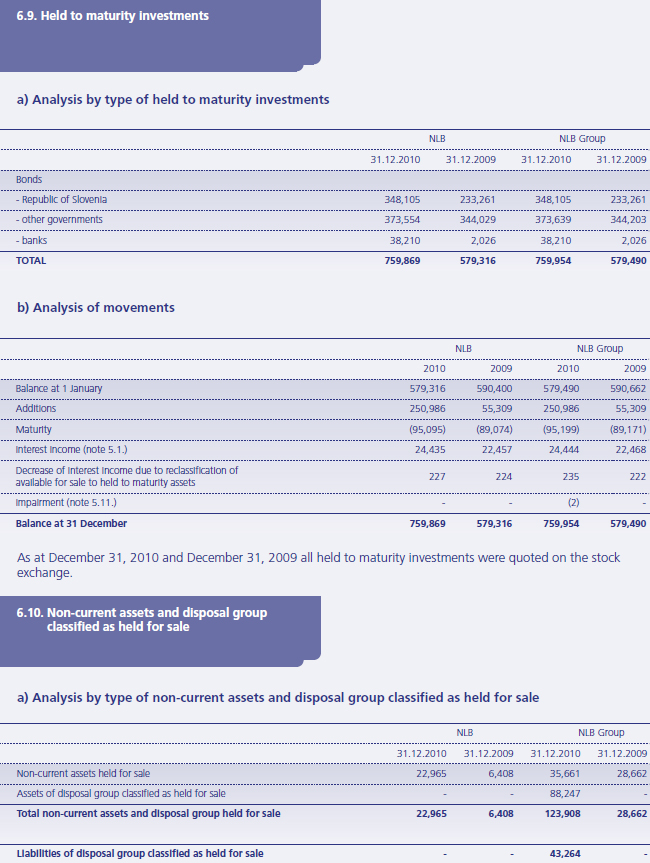
Non-current assets held for sale include business premises, apartments and assets received as collateral that are in
the process of sale. In addition, the Bank also includes capital investment in NLB Bank Sofia, Sofia.
The Bank disclosed real estate received by taking possession of collateral in the amount of EUR 1,292 thousand
(December 31, 2009: EUR 1,287 thousand), while the Group disclosed EUR 27,572 thousand (December 31,
2009: EUR 23,140 thousand) arising from the same source.
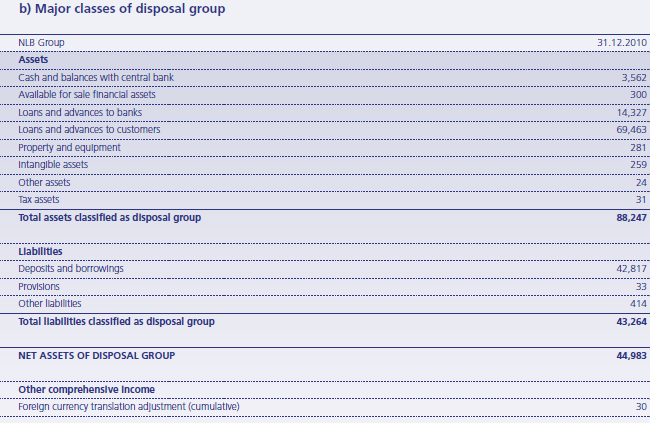
The disposal group comprises a subsidiary NLB Banka Sofia, Sofia domiciled in Bulgaria. The transaction is
expected to be completed in the first half of 2011.
The Bank impaired capital investment in NLB Banka Sofia, Sofia prior to reclassification as held for sale at fair value
less costs to sell.
The total amount of loans and advances to banks has original maturity up to three months and is included within
cash equivalents.
Notes 7.1. include also the data of NLB Bank Sofia, Sofia.
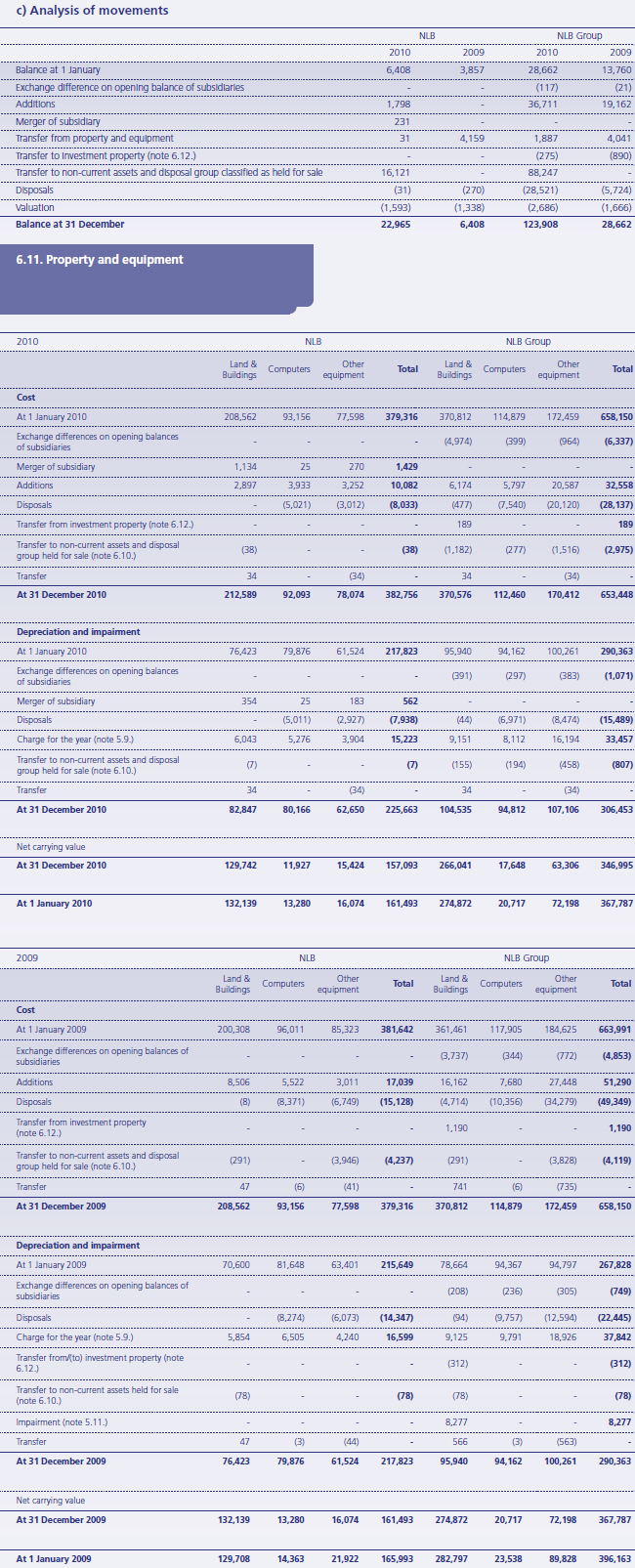
Due to the decline in market real estate prices, the Group impaired in 2009 the building in Frankfurt to its market
price, which represents the asset’s recoverable amount.
Assets leased under finance leases in the Group as at December 31, 2010 amounted to EUR 121 thousand for
motor vehicles (December 31, 2009: EUR 245 thousand), EUR 1,179 thousand for land (December 31, 2009: EUR
1,192 thousand) and EUR 17 thousand for other equipment (December 31, 2009: EUR 36 thousand). The Bank
has no assets held under finance leases as at December 31, 2010.
The value of assets received by taking possession of collateral and included in property and equipment by the
Bank and Group amounted to EUR 7 thousand (December 31, 2009: EUR 7 thousand).
The net carrying value of assets leased out by the Group under operating leases was EUR 28,471 thousand as at
December 31, 2010 (December 31, 2009: EUR 33,835 thousand). Majority of assets (82%) leased out relates to
motor vehicles.
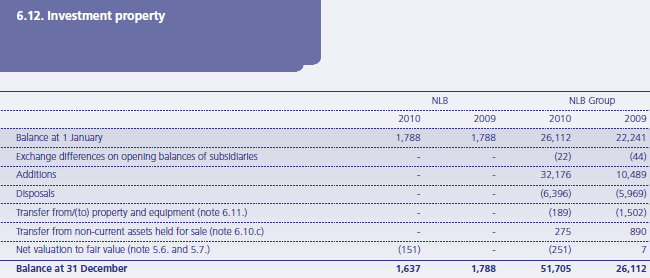
The Group has no interests in properties held under operating leases that should be classified and accounted for
as investment property. The Group disclosed operating expenses arising from investment properties leased to
others in amount of EUR 78 thousand in its 2010 income statement (2009: EUR 103 thousand).
The value of Bank’s investment property received by taking possession of collateral was EUR 219 thousand
(December 31, 2009: EUR 219 thousand) while the Group disclosed EUR 1,225 thousand (December 31, 2009:
EUR 890 thousand) arising from the same source.
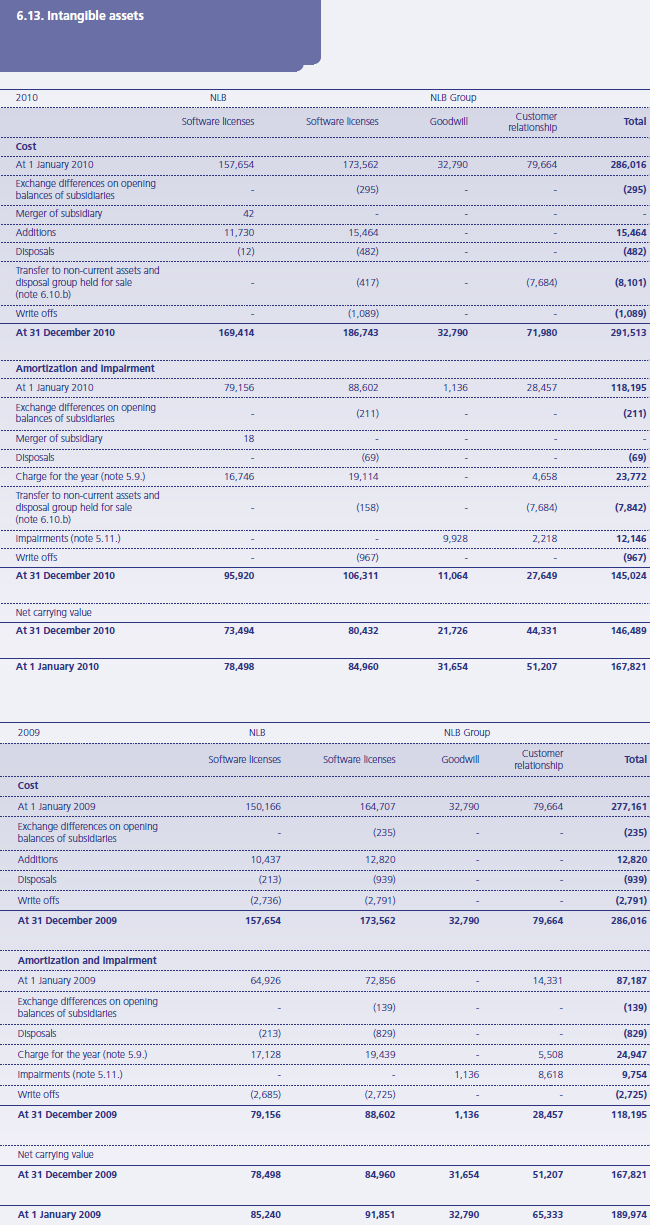
In 2010, the Group recorded impairment of goodwill in the amount of EUR 9,928 thousand (in 2009: EUR 1,136
thousand). In the 2010 the Group also impaired additionally identified intangible assets (e.g. customer
relationship). Impairments in the amount of EUR 2,218 thousand (in 2009: EUR 8,618 thousand) were recorded.
Impairments are primarily the consequence of lower recoverable amounts of investments, as well as lower
profitability of identified customer relationships.
The recoverable amount of the cash-generating unit, which includes the impaired goodwill, was based on a value
in use calculation, including the following assumptions that represent the past experience:
- a three-year financial plan approved by the Management and Supervisory Boards;
- the extrapolation of confirmed plans for a five-year period taking into account an established growth rate;
- growth in cash flows for residual period in the amount of 3.5%;
- a discount rate of between 13% and 17%; and
- target capital adequacy ratios of an individual bank of between 14% to 17%.
The financial plans of individual companies are based on past experiences and an assessment of future economic conditions that will impact an individual bank’s operations and the quality of its credit portfolio. The discount rates used are based on an assessment of the general and specific risks to which an individual bank’s operations are exposed. The discount rates are calculated on the basis of the CAPM model.
Majority of impact relates to effects derived from financial crisis, larger impairment provisions, higher interest rates on deposits, large decline in GDP for Balkans region, change in capital regulation which requires additional capital increases or results in smaller dividend payment.
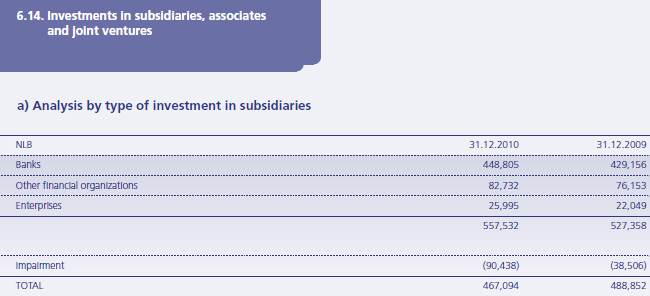
The Bank tested individual investments in subsidiaries for impairments as at December 31, 2010 owing to the
adverse economic conditions. Pursuant to the requirements of the IFRS and its internal methodology, the Bank
calculated the recoverable amount of each investment. The calculation is based on the assumptions stated in note
6.13.
In 2010 the Bank recognized an impairment loss in the amount of EUR 51,932 thousand for investments in NLB
Leasing Maribor, Maribor, NLB Leasing, Ljubljana, NLB Nova penzija, Beograd, CBS Invest, Sarajevo, NLB Factoring,
Ostrava, NLB Factor Bratislava, NLB Banka Sofia, Sofija and NLB banka, Beograd.
In the year 2009 the Bank recognized an impairment loss in the amount of EUR 35,809 thousand for investments
in LHB Internationale Handelsbank AG, Frankfurt/Main, NLB Tuzlanska banka d.d., Tuzla and NLB Razvojna banka
A.D., Banja Luka.
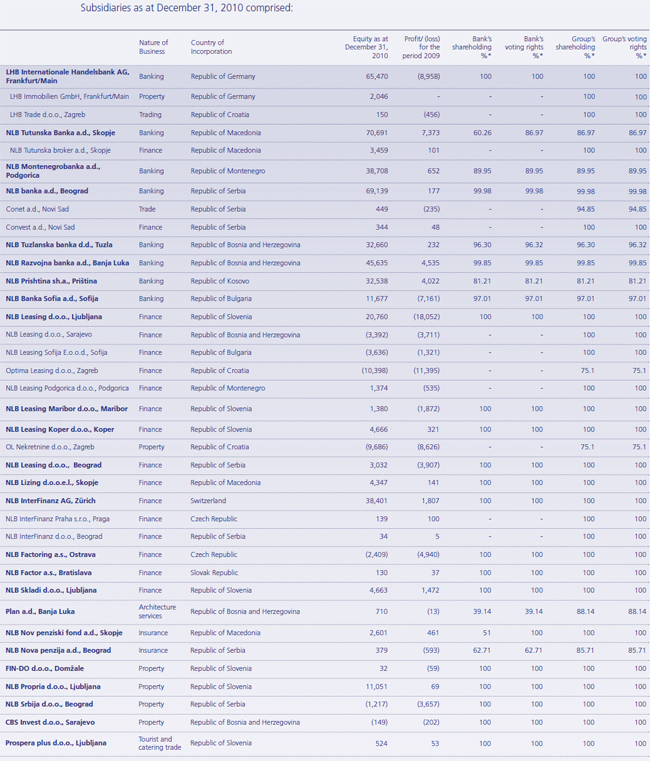
Click on image to enlarge
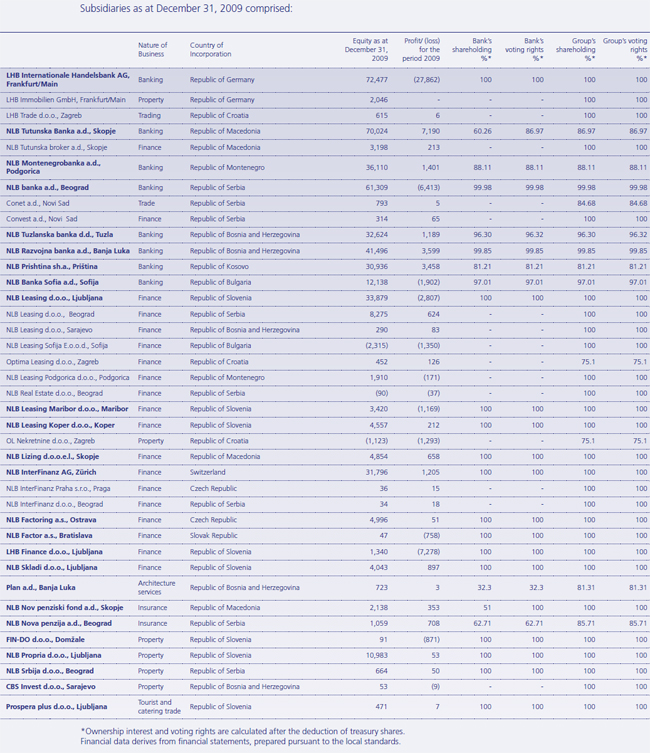
Click on image to enlarge
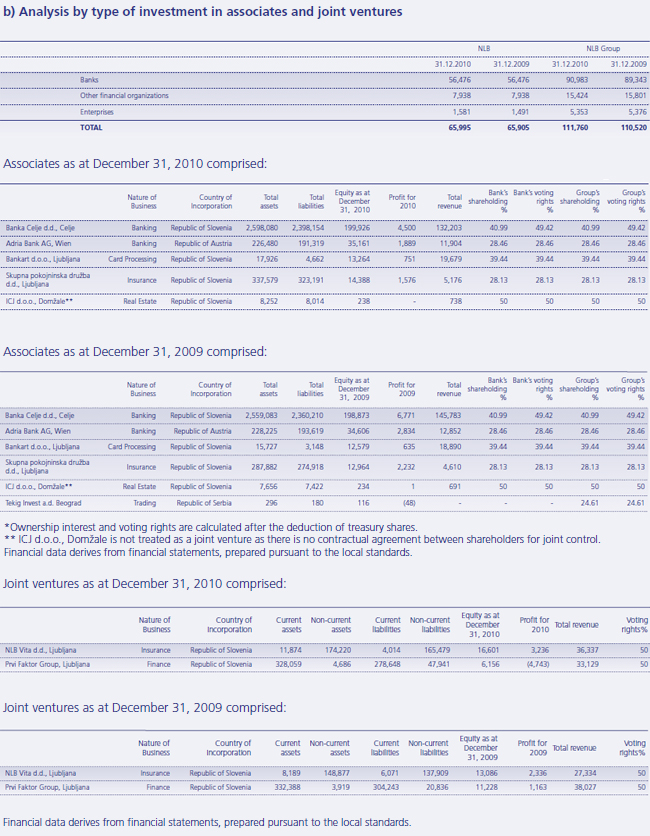
Click on image to enlarge
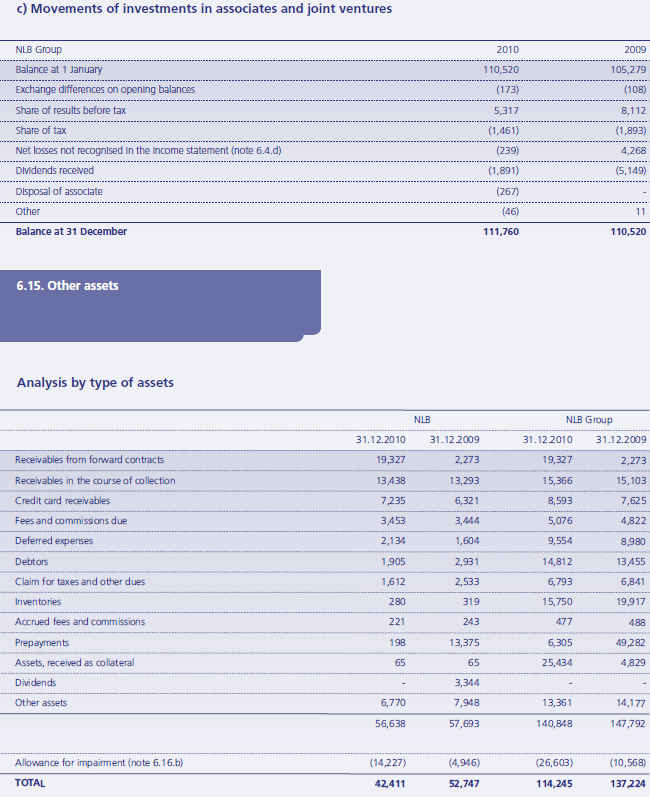
All other assets, except for inventories, assets received as collateral and claims for taxes and other dues, are
financial assets, measured at amortized cost.
Receivables in the course of collection are temporary balances which, owing to the functionality of the
information support system, are transferred to the appropriate item in the days following their occurrence.
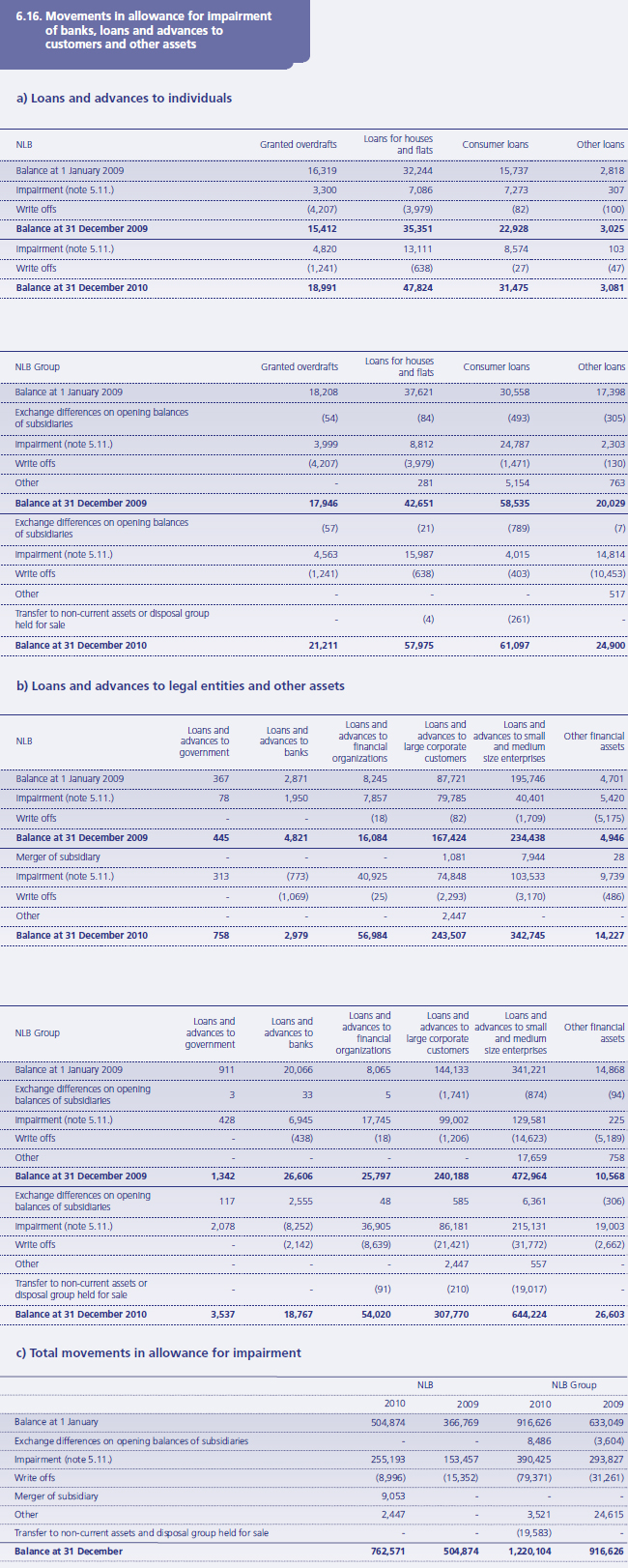
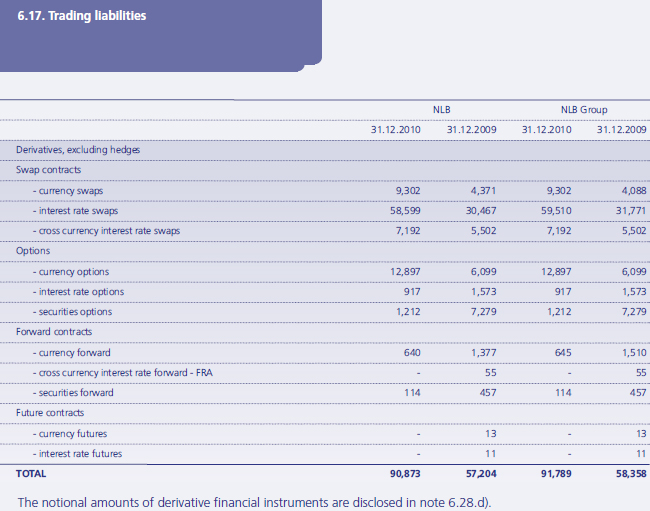
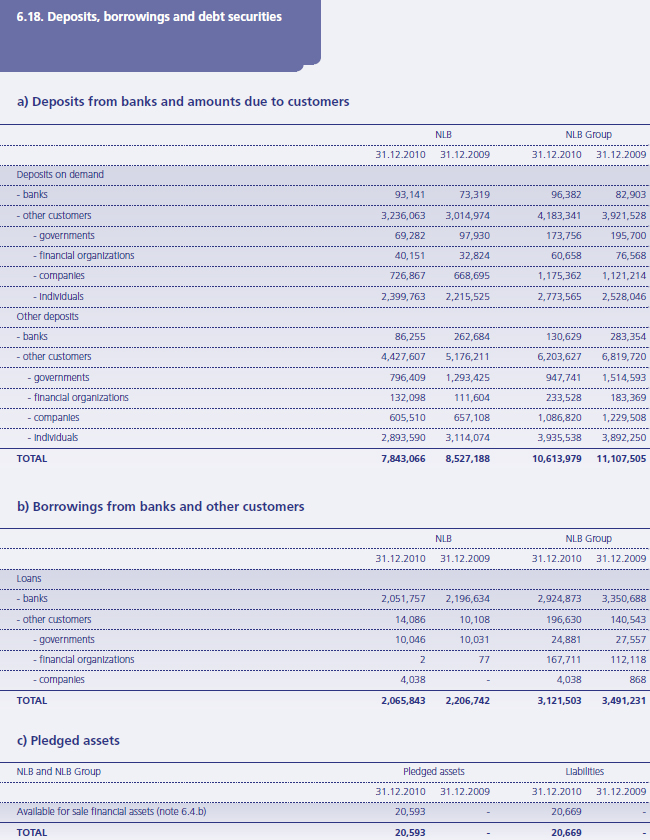
The Group has sold some available for sale financial assets under sale and repurchase agreements (repos). Although the Group is no longer legal owner of these securities it has retained its economic ownership. The Group is entitled to all coupon interest and potential dividends. Therefore these securities are still included in Group’s financial statements and the counterparty liabilities are presented as financial liabilities associated with the transferred assets.
d) Debt securities in issue
In July 2009 the Group successfully issued Slovenian government-guaranteed bonds on the international financial
markets. The bonds were issued in the amount of EUR 1.5 billion with a coupon rate of 3.25% p.a. As at December
31, 2010 the carrying amount of those bonds amount to EUR 1,496,830 thousand (December 31, 2009: EUR
1,481,697 thousand) and presents 83% of all issued securities.
Debt securities issued by the Bank relate to issued bonds and are denominated in EUR. Of these, 94.09% bear a fixed
interest rates (December 31, 2009: 94.01%), while 5.91% bear a floating interest rates (December 31, 2009: 5.99%).
All issued bonds with a carrying amount of EUR 1,793,520 thousand (December 31, 2009: EUR 1,757,310 thousand)
were traded on active markets as at December 31, 2010.
Debt securities issued by the Group relate to issued bonds and are all denominated in EUR. Of these, 93.56% bear a
fixed interest rates (December 31, 2009: 93.50%), while 6.44% bear a floating interest rates (December 31, 2009:
6.50%). Issued securities with a carrying amount of EUR 1,791,329 thousand were traded on active markets as at
December 31, 2010 (December 31, 2009: EUR 1,766,708 thousand). Issued securities with a carrying amount of EUR
12,633 thousand are not traded on active markets (December 31, 2009: EUR 13,339 thousand).
During the years presented there were no defaults on the securities in issue.
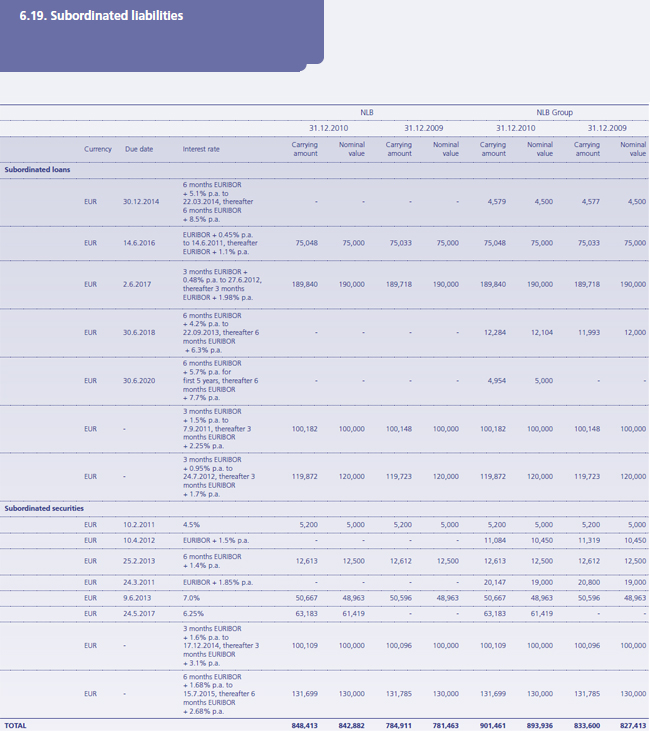
Click on image to enlarge
In accordance with the Regulation on capital adequacy of banks and savings banks, subordinated long-term loans
and issued subordinated securities are included in the Group’s Tier II capital as at December 31, 2010. The issued
subordinated securities do not contain any provisions on conversion to capital or any other liabilities.
In June 2010 Group successfully issued subordinated bonds EUR 60.8 million which are added to the Bank’s
capital.
The bond’s maturity is 7 years and it offers a 6.25% annual percentage return. The offering of bonds was
intended mainly for individuals and legal persons in Slovenia. Subordinated bonds meet the criteria for inclusion in
Tier II capital.
Subordinated loans in the amount of EUR 120 millions and EUR 100 millions are hybrid instruments in accordance
with the definition in the Regulation on capital adequacy of banks and savings banks. The instruments have an
undefined maturity. Withdrawal or redemption is possible after a minimum of five years and one day after issue,
and with the prior approval of the Bank of Slovenia. Subordinated securities in the amount of EUR 130 million are
quoted on the Luxemburg stock exchange and have the nature of an innovative instrument. Their main
characteristics are:
- the instrument is a “bearer” type (i.e. entitles the holder);
- the instrument is perpetual and the Group has no obligation to repay the principal amount. The Group has the right to redeem bonds on each interest payment day 10 years following the issue day, and in exceptional cases after 5 years, but in both cases only with prior approval of the Bank of Slovenia;
- interest is paid semi-annual in arrears;
- payments from this instrument are non cumulative;
- they are able to absorb losses on a going-concern basis;
- they are subordinated to depositors, general creditors and subordinated debt instruments, which means that in case of the Bank's bankruptcy these instruments rank just above non-cumulative preference shares and ordinary shares;
- they are neither secured nor covered by a guarantee of the issuing bank or related entity or any other form of arrangement that legally or economically enhances the seniority of the claim;
- the withdrawal or redemption of the instruments by the issuing bank or the acceptance of the instrument as collateral for a claim is initially possible only after a minimum of five years after issue and with the prior approval of the Bank of Slovenia. The condition for approval is that the Group will replace the instruments with another form of capital of the same or better quality, unless the Bank of Slovenia determines that even without the innovative instruments, capital is more than adequate with respect to the risk assumed by the Group and its commercial strategy. From the day it is withdrawn, redeemed or accepted as collateral an innovative instrument no longer meets the conditions for inclusion in the calculation of own funds.
- proceeds must be immediately and unconditionally available to the Group;
- in the event that the Group has no distributable profit, the Group must have the discretion of not paying out interest on innovative instruments and the Group must have full access to waived payments; and
- distributions can only be paid out of distributable items. Where the distributions are preset, they may not be reset based on the credit rating of the issuing bank.
During the years presented there were no defaults on subordinated liabilities.
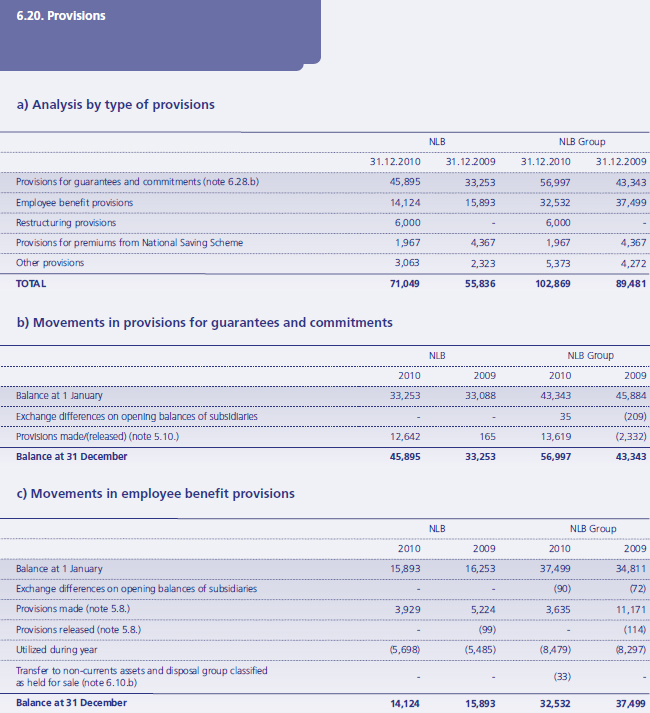
Employee benefit provisions include the Group’s obligations such as jubilee long-service benefits, severance pay at retirement, unused annual leave and termination benefits which are provided as a result of offer to employees in order to encourage retirements before the normal retirement date.

According to the covenants of the National Housing Saving Scheme, the Housing Fund of the Republic of Slovenia was required in past years to contribute one monthly premium per year to all depositors included in the scheme. The Bank is required to refund the invested premiums to the Housing Fund for all depositors that decide not to raise a loan after the conclusion of the scheme. The Bank thus created provisions for the expected amount of such premiums.

The Bank made EUR 6,000 thousand of provisions for the reorganization. Actual outflows are expected in 2011.

Other provisions in amount of EUR 2,833 thousand (December 31, 2009: EUR 2,323 thousand) relate to claims for additional interest relating to retail savings and deposits. Provisions made and utilized in 2010 relate mostly to fees and interests that the Bank paid to those clients who collected their money on the third banks cash machines.
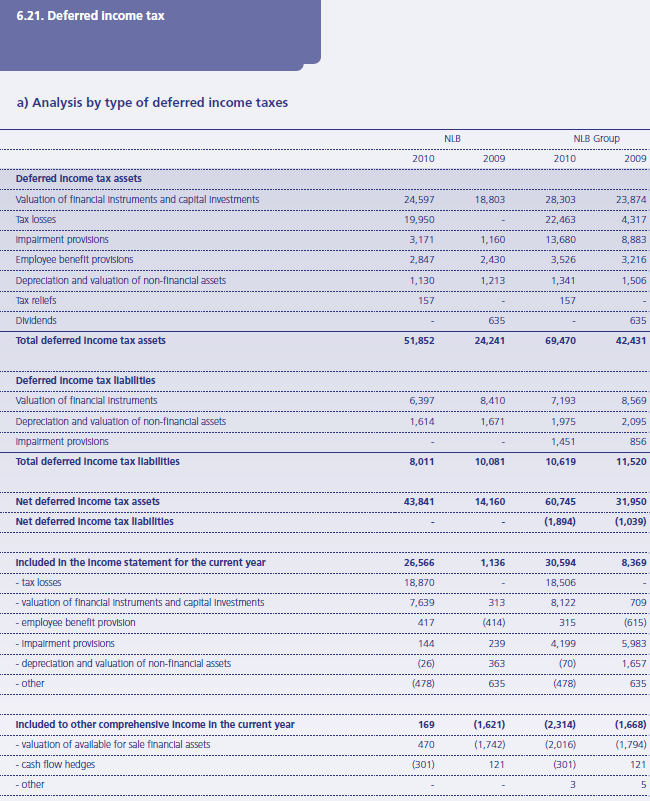
Effects for adjustment of deferred tax assets to lower tax rate in 2009 amounted to EUR 758 thousand. In 2010 there were no adjustments for deferred tax assets, as the tax rate stabilized at 20%.
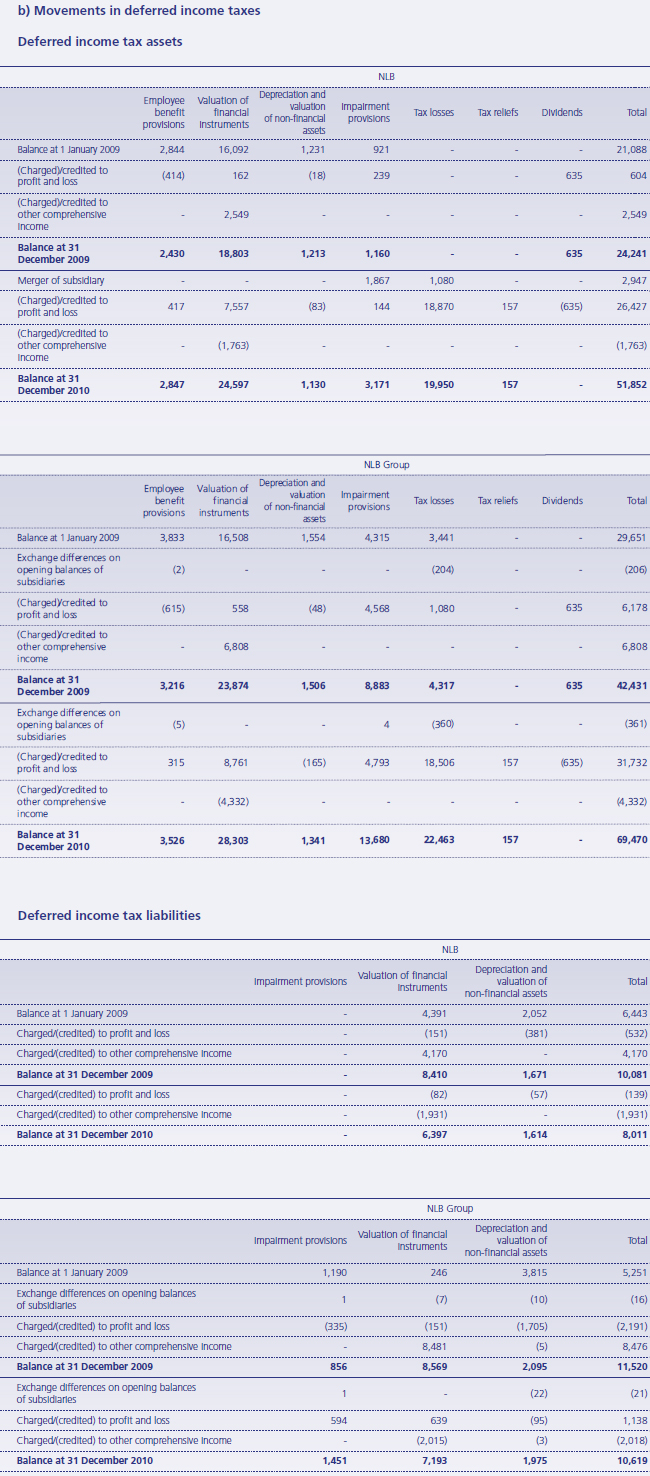
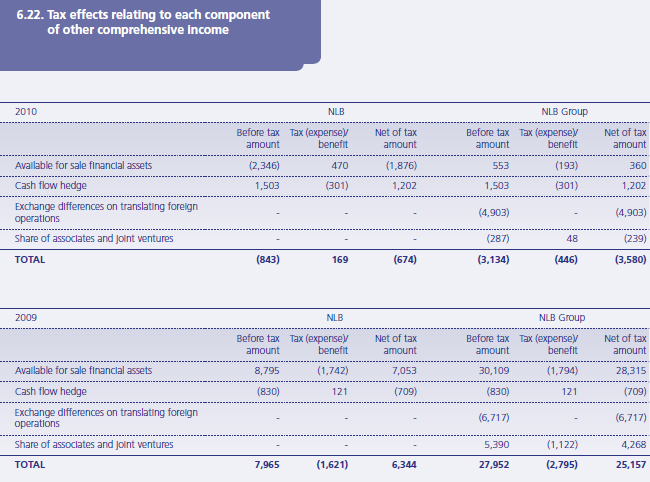
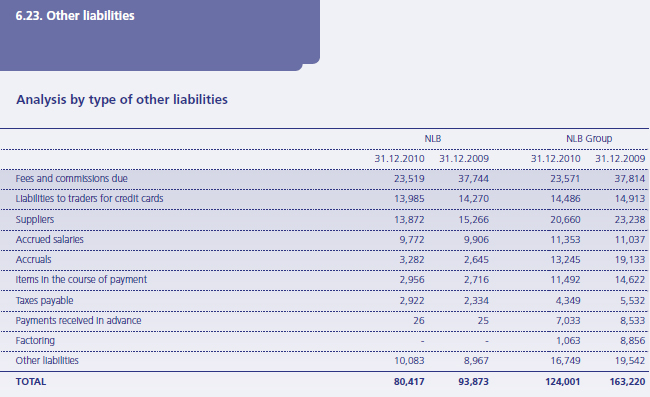
All other liabilities, except for taxes payable, accrued salaries and liabilities for advances received are financial liabilities and are measured at amortized cost.

The Bank’s share capital is EUR 74,328 thousand as at December 31, 2010, and is divided into 8,905,952 ordinary
shares. There were no movements in number of outstanding shares in 2010 and 2009.
All shares are ordinary, freely transferable no-par value shares, with voting rights, issued in non-material form and
registered in the accounts of shareholders at the Central Securities Clearing Corporation. All shares are of the
same class and subscribed. Shareholders have the right to participate in the governance of the Bank, to receive
dividends, and they are entitled to an appropriate portion of assets in the event of the winding-up of the Bank, as
determined by law. All shares are paid-up in full.
As at December 31, 2010 there were 2,002 shareholders (December 31, 2009: 1,998) of which 279 are legal
entities, 1,702 are individuals and 21 are non–residents. Compared to year-end 2009 the number of shareholders
has increased by 4. One share is held by the Bank’s subsidiary (December 31, 2009: 1 share). The Bank has 34,924
treasury shares, for which it has created reserves in the amount of EUR 2,048 thousand.
Pursuant to the decision of the annual General Meeting, the Bank did not pay a dividend for 2009 during 2010
(2009: EUR 2,927 thousand).

The share premium comprises paid-up premiums in the amount of EUR 446,390 thousand (December 31, 2009:
EUR 446,390 thousand) and the revaluation of share capital from previous years in the amount of EUR 49,205
thousand (December 31, 2009: EUR 49,205 thousand). The share premium is not distributable.
Profit reserves in the amount of EUR 413,448 thousand (December 31, 2009: EUR 604,148 thousand) comprise
retained earnings that were transferred to reserves in accordance with the decision of the Bank’s Annual General
Meeting and cannot be distributed in the form of dividends.
The Bank recorded a net loss in the amount of EUR 183,423 thousand (2009: net loss 23,621 thousand), and thus
no distributable profit is available for 2010.
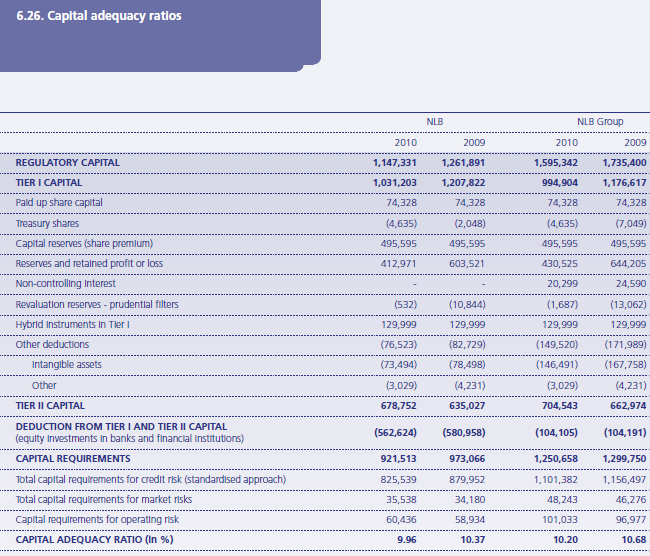
Capital adequacy and capital are monitored in conformity with the guidelines developed by the Basel Committee
and European Community Directives, as implemented by the Bank of Slovenia. The required information on
capital adequacy is filed with the Bank of Slovenia on a quarterly basis. The Bank of Slovenia requires each bank
and banking group to maintain capital adequacy ratio at or above 8%. In the year 2010, the Bank and the Group
complied with all of the requirements of capital adequacy regulation.
Capital adequacy calculations for the Group are based upon the consolidated financial reports, prepared in line
with the Regulation on the supervision of banks and savings banks on a consolidated basis, which differs from the
consolidation made in line with IFRS. According to IFRS, all the group’s subsidiaries, associates and joint ventures
are included in consolidation: subsidiaries using the full consolidation method whereas associates and joint
ventures using the equity method.
According to the Regulation on the supervision on a consolidated basis, insurance companies and pension funds
are completely excluded from the consolidated financial reports (in case of NLB Group, these companies are: NLB
Nov penziski fond, Skopje, NLB Nova penzija, Beograd, Skupna pokojninska družba, Ljubljana and NLB Vita,
Ljubljana. Furthermore, joint ventures (in case of NLB Group: Prvi Faktor Group, Ljubljana) are included in
consolidated reports using the proportional method of consolidation.
Characteristics of each capital component are described in the Regulation on the calculation of own funds of
banks and savings banks (Ur.l.RS 85/2010 in 97/2010). Tier II capital includes hybrid instruments (Tier I eligible
instruments that exceed the limitation for inclusion in Tier I capital, as well as Tier II eligible instruments),
subordinated debt and revaluation reserve from available for sale securities and from investment property. The
extent of subordinated debt included in Tier II capital is gradually decreasing with 20% cumulative discount in the
last five years before maturity.
On December 31, 2010, new Regulation on the calculation of own funds of banks and savings banks came into
force, introducing more restrictive policy regarding inclusion of hybrid (innovative) instruments in Tier I capital.
Existing innovative instrument issued by NLB does not fulfil new demands for inclusion in Tier I and was classified
as “grandfathered hybrid instrument”. Therefore, the instrument can be further included in Tier I capital: up to
15% of Tier I capital until year 2030 (same treatment as under previous regulation) and up to 10% of Tier I capital
until year 2040; after year 2040 inclusion is no longer allowed.
In the first half of the year 2010, NLB issued subordinated debt security NLB 26, which caused the increase in Tier
II capital in the amount of Euro 60.8 million.

The Bank has a branch in Trieste with total assets amounting to EUR 155,180 thousand as at December 31, 2010 (December 31, 2009: EUR 189,259 thousand) and net profit for 2010 of EUR 124 thousand (2009: EUR 441 thousand).

a) Contingent liabilities and commitments
Documentary (and standby) letters of credit constitute a written and irrevocable commitment of the issuing (opening) bank, on behalf of the issuer (importer) to pay the beneficiary (exporter) the value set out in the documents by a defined deadline:
- if the letter of credit is payable on sight; and
- if the letter of credit provides for deferred payment – to be paid at maturity, provided that the beneficiary (importer) presents the Bank documents that are in line with the conditions and deadlines set out in the letter of credit.
A commitment may also take the form of a letter of credit confirmation, which is usually done at the request or authorization of the issuing (opening) bank and constitutes a firm commitment by the confirming bank, in addition to that of the issuing bank, which independently assumes a commitment to the beneficiary under certain conditions.
b) Contractual amounts of off-balance sheet financial instruments
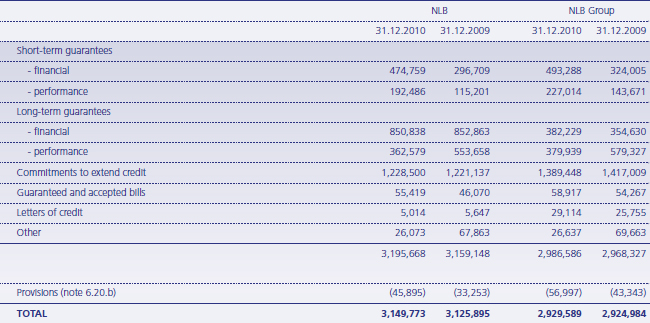
Commitments to extend loans can be realized within one year. The Group has no financial guarantees, for which the first possible payment date would be later than within one year.
c) Movement of called performance guarantees

Fee income from all issued performance guarantees amounted to EUR 8,010 thousand (2009: EUR 6,536 thousand) at the Bank, and to EUR 8,938 thousand (2009: EUR 7,405 thousand) at the Group.
d) Analysis of derivative financial instruments by notional amounts
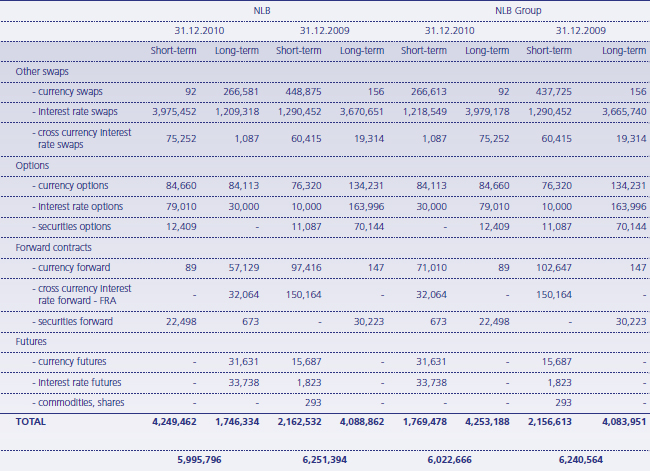
The notional amounts of derivative financial instruments that qualify for hedge accounting at the Bank and Group
amount to EUR 2,894,422 thousand (December 31, 2009: EUR 3,101,134 thousand). Derivatives that qualify for
hedge accounting are used to hedge interest rate risk.
The fair values of derivative financial instruments are disclosed in notes 6.2., 6.5. and 6.17.
e) Operating lease commitments
The future minimum lease payments under non-cancellable property operating leases are as follows:

f) Operating lease income
Future minimum lease income:

g) Capital commitments
As at December 31, 2010 the Bank had capital commitments for the purchase of intangible assets (software and
licenses) in the amount of EUR 662 thousand in respect of implementation of a new information technology
system (December 31, 2009: EUR 1,162 thousand).
As at December 31, 2010 the Group had no capital commitments for the purchase of property and equipment
(December 31, 2009: EUR 2,471 thousand), commitments in the amount of EUR 734 thousand (December 31,
2009: EUR 1,896 thousand) in respect of intangible assets (software and licenses).

Funds managed on behalf of third parties are accounted for separately from the Group’s funds. Income and expenses arising with respect to these funds are charged to the respective fund, and no liability falls on the Group in connection with these transactions. The Group charges fees for its services.
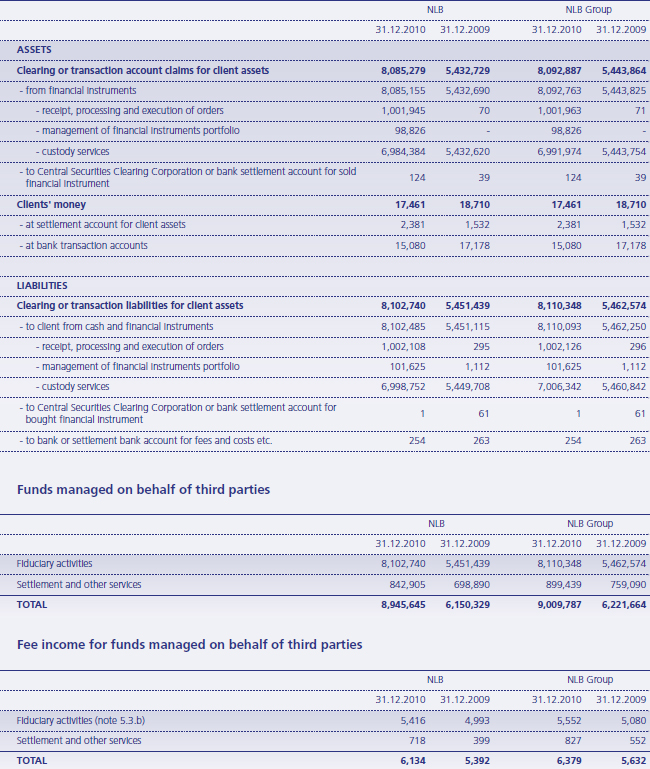
7. RISK MANAGEMENT
The Group’s risk management includes a clear organizational structure, effective risk management procedures and
an appropriate system of internal controls. The aim of risk management in the Group is to achieve planned results
with minimal risk taking and to optimize the use of regulatory and internal capital of the Group.
In managing risks, NLB takes into account rules and regulations prescribed by the Bank of Slovenia and related
internal acts of the Bank. The basic strategy and internal acts, which are regularly updated, discussed by the
Supervisory Board and approved by the Management Board, define the objectives, procedures and methodologies
for monitoring, measuring and managing different risks.
The financial crisis continued to deepen in 2010 in the Group’s markets, which was reflected in the lending activity
of the Group, deterioration in the quality of its credit portfolio and deterioration in the liquidity position of some
important clients. Entities frequently face a substantial decrease in demand and sales’ income.
In order to avoid losses, the Group continues with its relatively conservative policy of managing credit risk. The
latter encompasses the careful monitoring of clients, the approval of new investments only after obtaining quality
collateral, and the acquisition of additional collateral for existing transactions.
The Group also continues to maintain a relatively conservative policy with regard to other market risks. The
Group’s exposure to these risks is relatively low. With regard to structural liquidity, the Group has compiled an
adequate level of liquidity reserves in the form of first rate debt securities, which facilitate for “repo” transactions
with the ECB or on the inter-bank market.
NLB regularly monitors and analyses exposure to risks at the Group level, and takes the appropriate measures, as needed.

In their own credit risk management, Group entities take into account documents drafted by NLB that define the
credit process, customer and advances classification and the impairment of investments or creation of provisions
in addition to local legislation and standards.
Group entities report quarterly to the Bank the amount of credit exposure (by customers and rating system) and
the amount of provisions created.
The Group’s credit portfolio includes statement of financial position claims (loans, securities, interest, fees and commissions,
etc.) and off-balance sheet liabilities (guarantees, letters of credit, commitments and contingencies, derivatives, etc.) against
corporate customers, banks, financial institutions, the public sector, entrepreneurs, retail customers and other customers.
When entering into any of the above-mentioned transactions, the Group exposes itself to credit risk, which is the risk that
the counterparty will cause a financial loss for the Group by failing to discharge an obligation.
Prior to credit approval or entering into a contract, which exposes the Group to credit risk, every customer receives
a rating and individual limit. The rating of a customer depends on its financial position, business performance and
relationship with the Group to date and its ability to provide cash flows to meet future obligations. Country risk is
also taken into account for non-resident clients.
The risk associated with the credit portfolio is monitored by analyzing trends in the movements, risks and concentrations
of the credit portfolio as a whole, and separately by different segments of customers and loans or advances.
Impairment losses and provisions for commitments are created in accordance with the IFRS as adopted by the EU
and the standard methodology for the NLB Group, according to the risk associated with an individual transaction
and the existence of objective evidence of impairment. The amount of impairment loss is also affected by
collateral, if it represents an effective means of repayment in the event of a customer’s default. Individually
significant claims are assessed for impairment on an individual basis, while the remainder of credit portfolio is
assessed collectively.
a) Derivatives
The Group maintains relatively strict control limits on net open derivative positions, i.e. the difference between purchase and sale contracts, both by amount and term. The Group enters mostly into currency, interest rate and equity derivative contracts. Exposure from derivatives is mainly associated with the Bank, other members of the Group conclude derivative contracts only in order to hedge their own open positions or for their clients’ purposes (back to back transactions). The amount subject to a credit risk is limited to the credit replacement value of the instrument that is determined in accordance with the regulations (based on the sum of current and potential exposure). Exposure to credit risk from derivatives is managed in the scope of overall lending limits.
b) Credit related commitments
The primary purpose of these instruments is to ensure that funds are available to customers when required. Guarantees and standby letters of credit, which represent irrevocable assurance that the Group will make payments if a customer cannot meet its obligations to third parties, carry the same credit risk as loans. Documentary and commercial letters of credit are written undertakings by the Group on behalf of a customer authorizing a third party to draw drafts on the Group up to a stipulated amount under specific terms and conditions, are collateralized by the underlying shipments of goods to which they relate and therefore carry less risk than direct borrowing. Commitments to extend credit represent unused portions of authorizations to extend credit in the form of loans, guarantees or letters of credit. With respect to credit risk on commitments to extend credit, the Group is potentially exposed to loss in an amount equal to the total unused commitments. However, the likely amount of losses is less than total unused commitments, since most commitments to extend credit are contingent upon customers maintaining specific credit rating. The Group monitors the term to maturity of credit commitments, as longer-term commitments generally have a greater degree of credit risk than shorter-term commitments.
c) Internal rating system

A credit rating reflects the credit quality of a customer, whose exposure derives from a financial instrument. An “A” credit rating is given to first-class customers, who are not expected to encounter difficulties in repaying their obligations. A credit rating of “B” indicates customers with a slightly worse financial position, which is temporary in nature and does not indicate difficulties in repaying obligations. A credit rating of “C” indicates customers who are undercapitalized and highly indebted, or those customers that generally do not generate sufficient cash flows to repay their obligations, and so thus may pay their obligations in arrears. Credit ratings of “D” and “E” indicate customers with evident financial difficulties, or those who are in the process of compulsory settlement or bankruptcy. It is expected that these clients will not be able to repay most or even any of their obligations from their operating cash-flow. Customers with a “C” credit rating or worse must provide additional collateral to cover their exposure in the amount of credit replacement value.
d) Maximum exposure to credit risk before collateral held or other credit enhancements
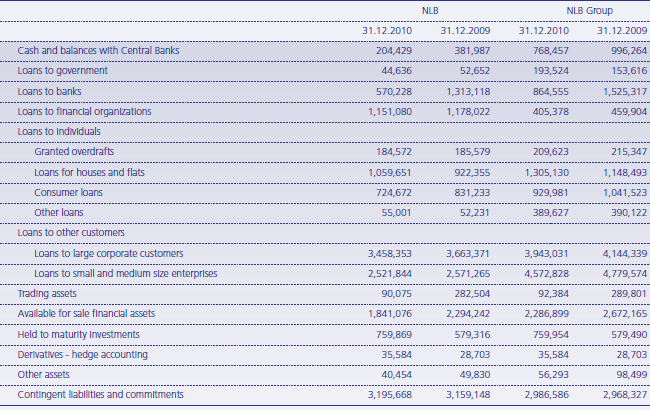
Maximum exposure to credit risk represents the worst case scenario relating to credit risk exposure, which is the
Group’s maximum possible, excluding the effects of collateral. For assets, the exposures set out above are based
on net carrying amounts as reported in the statement of financial position, while off-balance sheet items amounts
are based on nominal values.
According to internal methodology for loan impairment, all individually significant customers are individually
assessed for impairment. This represents on Bank level 66.4% (2009: 66.5%) and on Group level 64.0% (2009:
68.7%). Bank has 13.35% (2009: 24.5%) loans and advances neither past due nor impaired and 0.87% (2009:
0.9%) loans and advances past due but not impaired.
In-depth analyses of customers and diligent risk management in the past have ensured a high-quality credit
portfolio. In 2009, and again in 2010, the quality of the credit portfolio deteriorated due to the financial crisis.
This resulted in an increase in impairment and provisions for credit loss for customers who were collectively
assessed (an increase in incurred but not reported losses) and for customers who were individually assessed, as the
result of lower expected repayments.
For this reason the coverage of the portfolio by allowances for impairment has been steadily increasing (2009:
increasing) to stand at the end of the year 2010 at 6.02% (2009: 3.82%). 80% (2009: 88%) of the portfolio is
considered to be a quality portfolio. The coverage of the portfolio by allowances for impairment at the Group level
the coverage has also risen and stood at 7.61% (December 31, 2009: 5.55%) at the end of 2010 76.1%
(December 31, 2009: 82.1%) of the portfolio is considered as quality portfolio (A and B ratings).
e) Loans and advances neither past due nor impaired
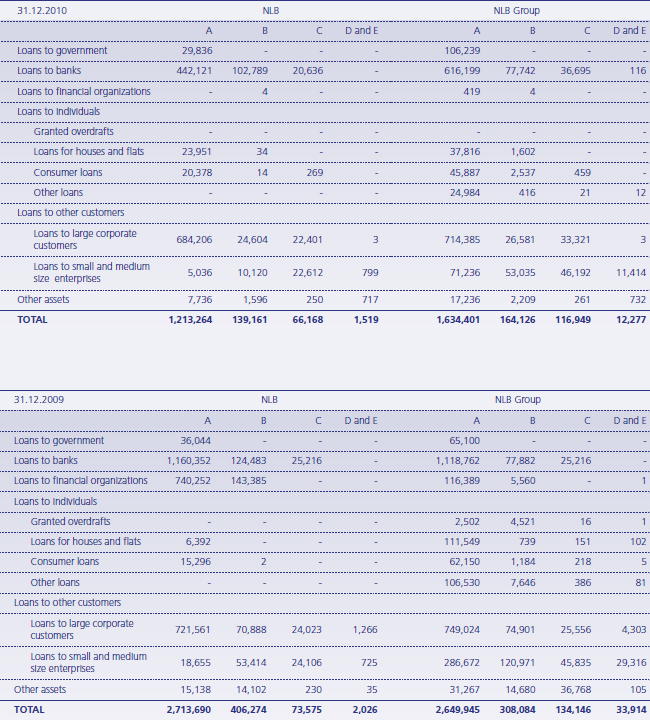
f) Loans and advances past due but not impaired

Click on image to enlarge
The Group accepts different types of collateral to mitigate credit risk. The decision regarding the type and value of
collateral depends on an analysis customer data. The Group strives to obtain high-quality collateral, which
facilitates the more rational use of the Group’s capital and results in lower impairments and provisions for financial
assets and commitments.
Long-term loans, in particular are collateralized, primarily with real estate collateral. The Group regularly monitors
the value of collateral over the entire loan repayment period and requires that the customer provide additional
collateral if the value of collateral decreases.
g) Impaired loans and advances
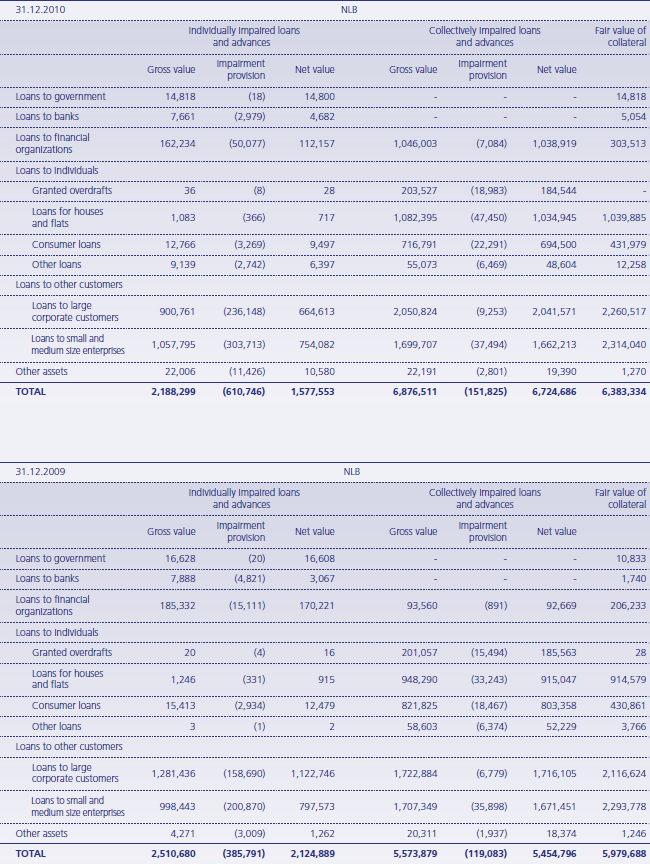
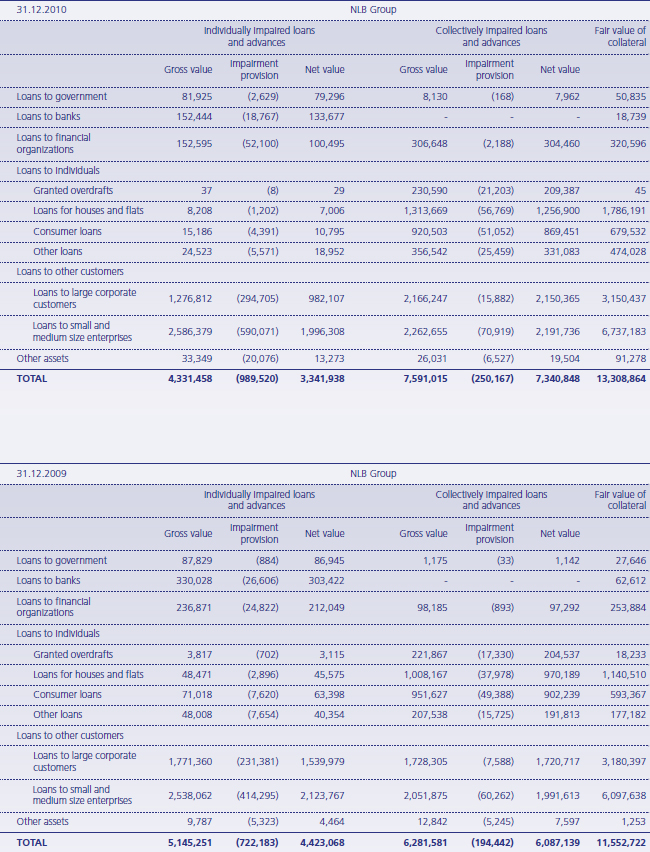
h) Loans and advances analysis
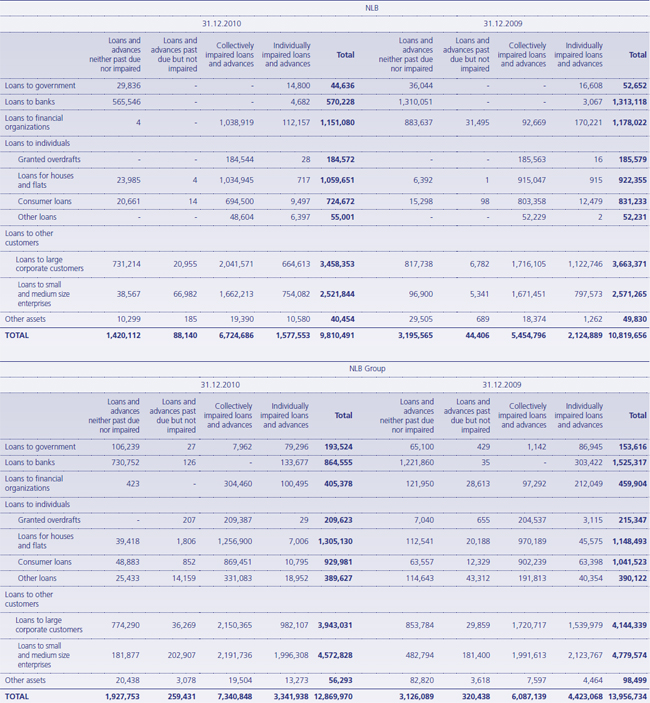
Click on image to enlarge
i) Renegotiated loans and advances
Restructuring activities include extended payment terms, the approval of external management plans, and the
deferral of payments. Following restructuring, a previously overdue loan is treated as not overdue and managed
together with other similar loans. Restructuring policies and practices are based on indicators or criteria which, in
the judgment of management, indicate that payment will most likely continue.
Loans, which were renegotiated in 2010 and would otherwise be past due or impaired, amounted to EUR
692,537 thousand as at December 31, 2010 (December 31, 2009: EUR 332,801 thousand) at the Bank, and to
EUR 1,081,904 thousand (December 31, 2009: EUR 731,888 thousand) at the Group.
j) Repossessed assets
The Bank and the Group received the following assets by taking possession of collateral held as security and recognized them in its financial statements:
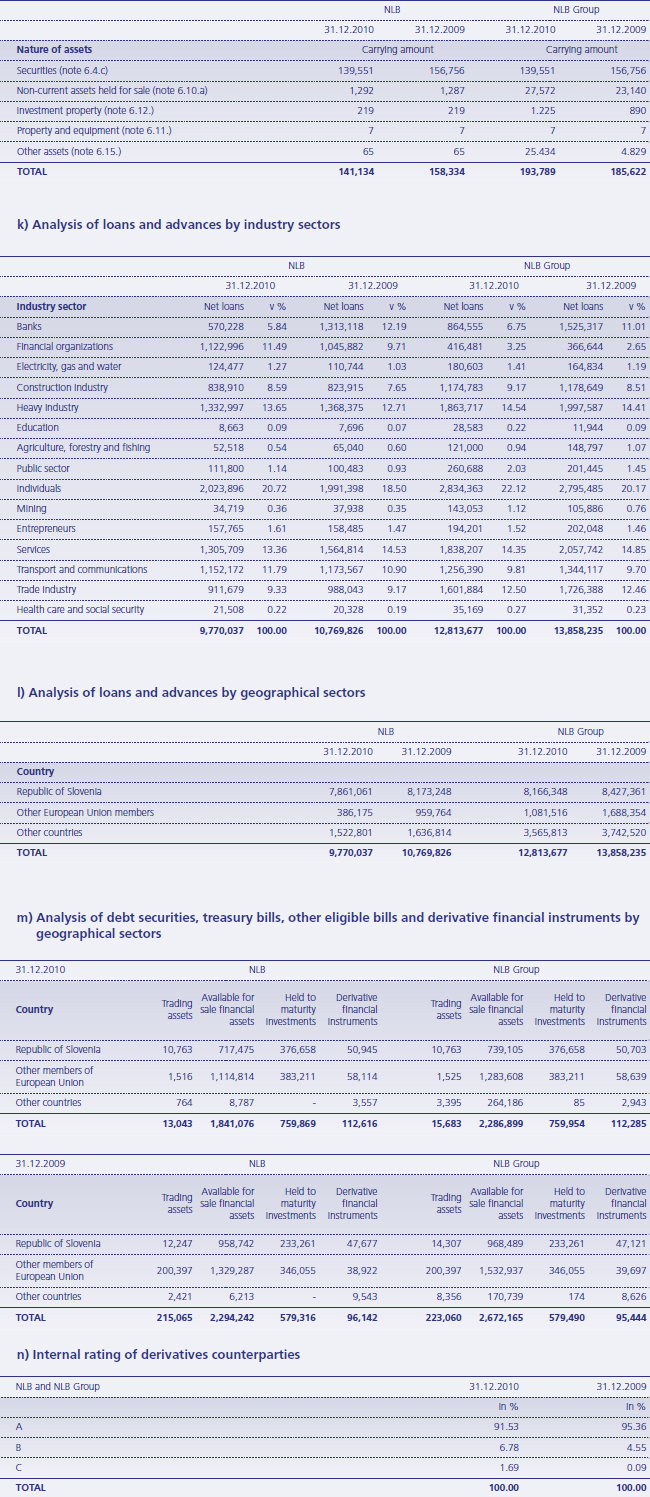
No derivatives in the banking book are entered into with counterparties with an external rating less than “AA”. When derivatives are entered into on behalf of customers all such transactions are covered through back-to-back transactions involving third parties with an external rating of “AA” or above.

Securities in the Bank in the amount of EUR 2,409 thousand (December 31, 2009: EUR 2,382 thousand) represent subordinated bonds of domestic issuer with internal rating “A”. Other members of the Group do not have debt securities that represent subordinated liabilities for the issuer.

Market risk is the risk that the market or fair value of financial instruments could fluctuate due to unfavourable changes
in specific market parameters, such as exchange rates, interest rates and securities prices. Market risk management at
the Group is a process comprising the monitoring and measurement of individual risks with the aim of actively managing
the potential negative financial effects that could arise as a result of changes on the financial markets.
In accordance with the provisions of Bank of Slovenia regulations, the Bank is the only bank in the NLB Group that
fulfils the conditions for ensuring the necessary capital for market risks on an individual basis. In accordance with Strategy for trading in Financial Instruments at the NLB Group, active trading in financial instruments by other Group
companies is extremely limited, and primarily aimed at servicing customers and hedging their own positions. Other
banks in the Group monitor exposure to currency and interest-rate risks, which are primarily the result of structural
movements and macroeconomic conditions, in accordance with guidelines on risk management in the Group.
Monitoring and managing the Group's exposure to market risks are not carried out on a consolidated level.
Guidelines and exposure limits for each risk type are set for individual Group companies, who regularly monitor
exposure and report to the Assets and Liabilities Committee of the NLB Group (ALCO of NLB Group).
The supervisory bodies of Group entities adopt their own market risk management policies. In accordance with
these policies, they are obliged to monitor and manage exposures to market risks and report them to the Bank.
The policies of Group entities must take into account local legislation and be in line with the minimum standards
for risk management at the NLB Group. The aforementioned document was approved and adopted by NLB's
Management Board. Methodologies concur with regulatory requirements on an individual and consolidated basis,
while current reporting to the regulator is carried out using a standardized approach.
a) Capital markets summary
Slovenia
Last year's developments on the Ljubljana Stock Exchange were characterized by modest turnover of merely EUR
492.5 million, nearly half of the turnover recorded in 2009. Slovenia's blue chip index, the SBI TOP, lost 13.5% of
its value last year, the fall in stock prices most notable in the first half of the year. The decline in the index stalled
in August, with the index finishing the year at 850.35 points. The fall in Slovenian share prices can be attributed
to sell-oriented domestic investors as, according to data released by the CSCC, the proportion of Slovenian
securities held by foreign investors has increased, while the total number of holders continues to decline.
As usual, the most widely traded stock in 2010 was Krka, whose total traded volume reached EUR 252 million, or
nearly half of the annual total turnover on the Ljubljana Stock Exchange. Krka's share price lost 1.6%, while of all
stocks included in the SBI TOP index, only two, Gorenje and Mercator, finished the year higher. Their shares prices
rose by 8.0% and 2.9% respectively. Taking into account all shares listed on the exchange, Cinkarna Celje
recorded the sharpest, of 17.7%. However, average daily turnover was only EUR 3,000.
The companies included in the SBI TOP recording positive results last year were Krka, Gorenje, Mercator and
Petrol, while the results of other large companies more or less reflected the overall condition of the Slovenian
economy. Investors did not show any particular interest in the shares of the aforementioned companies despite
their good results, the primary problem being the illiquidity of the Ljubljana Stock Exchange, the recovery in the
market capitalization of which lags well behind comparable Eastern European stock exchanges. An important
factor, which has improved the stock exchange's liquidity and the recognition of listed Slovenian companies, was
the inclusion of the Ljubljana Stock Exchange in the Xetra international trading platform. Through the Xetra, the
Slovenian stock exchange has become more interesting to foreign institutional investors, who access Slovenian
securities more easily.
Foreign markets
Following the drop in economic activity in 2009, when the global GDP fell by 0.6% and the GDP of developed
markets by as much as 3.2%, economic conditions improved in 2010 and the outlines of the economic recovery
became clearer. Particularly in the second half of the year, we witnessed increased optimism for economic growth,
while export-oriented countries such as Germany and Japan recorded strong growth in economic activity.
In addition to emerging markets, which were the driving force of the economic upturn last year, a significant
contribution to the growth also came from the expansionary monetary policy of the central banks of developed
markets and increased fiscal spending with the aim of stimulating consumption, which showed weak signs of
recovery last year due to the bleak situation on labor markets. Low inflation rates allowed the central banks of
developed markets to maintain record low interest rates, and stimulate the economy by pumping liquidity into the
banking system. On the other hand, in some emerging markets, in particular in China, the central banks have
already intervened with restrictive measures to curb rising inflationary pressures.
On capital markets, particularly in Europe, last year was strongly influenced by the fiscal crisis of European
countries, with Greece and Ireland accepting external financial assistance. A key step to stem the fears of the
general crisis of public finances in Europe was the adoption of European Financial Stability Facility (EFSF) and the
approval of a EUR 750 billion aid package to assist countries in financial troubles. This was followed by other
regulatory measures, most notably Basel III, which focuses on banks. The U.S. has continued its ultra-expansionary
monetary policy and, in the second half of the year, adopted a second quantitative easing package program worth
USD 600 billion.
As a result of aforementioned fiscal problems of European countries, European bond markets showed a relatively
high volatility, and the ECB was forced to purchase government bonds to prevent a rise in borrowing costs, which
might otherwise cause a further deterioration of the already difficult situation for countries like Greece, Ireland,
Portugal and Spain. As investors frequently fled to safe investments last year, the yield on 10-year German
government bonds reached a record low of close to 2%, while the yields of comparable U.S. Treasury bonds
remained at higher levels due to increased inflation fears.
According to the last published figures, it seems that the enormous measures of central banks over the past
two years have achieved their purpose and succeeded in stabilizing the economy, at least in the short term.
After an extended difficult period, corporate business did not disappoint last year, as for example in the U.S.
more than 90% of companies recorded positive operating results in the first nine months of last year. Major
global stock indices recorded relatively high growth rates in 2010 as a result. Due to the fiscal problems of
European countries, European stock markets showed relatively high volatility in the middle of the year, but later
recorded more sustained growth. The German DAX closed last year up 16.1%, while the British FTSE 100
gained 10.3% in value. A less favorable dynamic was recorded by the French CAC 40 index, which lost 2.2% of
its value, while the broader European stock index DJ EURO STOXX 50 recorded a 9% increase last year. The U.S.
S&P 500 showed a significantly more stable dynamic last year than stock indices in Europe, and rose by 12.8%
in value, while the tech-heavy NASDAQ gained 17.4%. In Asia, the Japanese Nikkei 225, have recorded growth
at the beginning of the year, recorded a negative dynamic over the rest of the year to end 3% lower which, in
particular, reflects the problems of a strong yen that had a negative impact on exporters. The Chinese CSI300
recorded a 12.5% decline in value last year, reflecting investors' caution due to inflation of the real estate
bubble in China.
Equity trading portfolios excluding equity investments hedged using derivative contracts
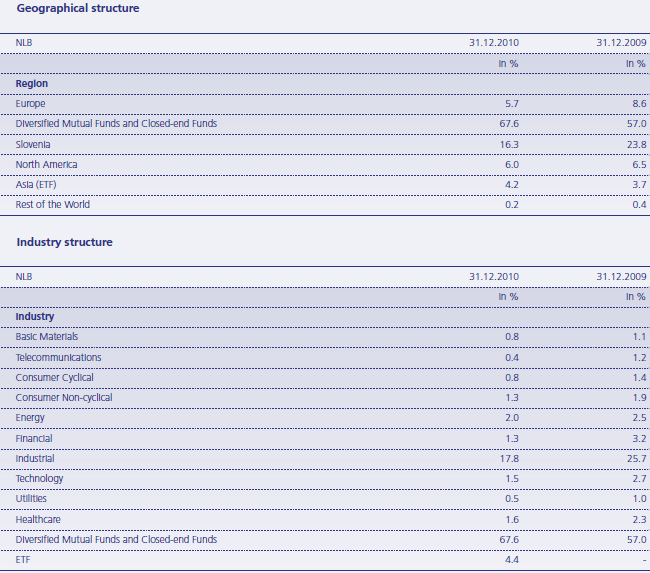
b) Value at Risk methodology
The Bank’s exposure to currency and other market risks in the trading book (interest rate risk and the changing
securities prices) is illustrated using the “Value at Risk” (VAR) methodology.
In the area of interest rate risk in the banking book, an analysis is given of the sensitivity of interest income, which
is estimated on the basis of the net interest income methodology. For equity securities in the banking book,
exposure to risks is expressed using a VAR calculation and sensitivity analysis.
Currency risk
The bank uses an internal »Value at Risk« (VAR) model to calculate currency risk arising from open positions. The calculation of the VAR value is adjusted to Basel standards (99% confidence interval, monitored period of 300 business days, 10-day holding position period), and is based on the historical simulation method. VAR is calculated for currency risk for the whole open bank position (e.g. the position of trading and banking book together) as the Bank’s total open position is managed by the Treasury department.

The majority of currency risk exposure in 2010 is arising from a structural mismatch, as an open position in RSD
(Serbian Dinar). The open RSD position was derived from restructured loans and the related currency conversion.
The net open position in RSD decreased considerably throughout the year due to the formation of additional
impairments. The exchange rate volatility decreased in comparison with 2009. This resulted in a decrease of the
average FX VAR and reflected in a lower average value than in the previous year.
The methodology for measuring currency risk at the NLB Group level is based on the net open foreign exchange
position principle (note 7.2.c) and the monitoring of the nominal limits (for the total open position by currency).
The internal VAR method described above is used for the illustration below of exposure to currency risk, which
derives from the quarterly net open positions of Group entities.

The decline in VAR for currency risk in NLB Group is driven by the lower net open position for individual Group entities and diminishing exchange rate volatility. The latter was the result of an easing of conditions on the financial markets in 2010 compared with 2009, when there were relatively high daily fluctuations in exchange rates, which affected potential loss or the level of VAR.
Other market risks in the trading book
The Bank uses an internal VAR model based on the variance-covariance method for other market risks. The daily
calculation of VAR value is adjusted to Basel standards (99% confidence interval, monitored period of 250
business days, 10-day holding position period).
In 2010, interest rate risks in the trading book amounted to an average of EUR 342 thousand (2009: EUR 453
thousand) and remained on a relatively similar level compared with the previous year. At the end of 2010 the
market value of the debt securities portfolio amounted to EUR 13 million, while the exposure form derivatives
trading derives primarily from Bond future contracts.
The risk of changing securities prices (debt securities portfolio) in the trading book fluctuated between EUR 3.0
and 4.3 million in 2010 (2009: EUR between 3.4 million and 5.8 million). The principal part of the exposure arose
from realizing the received collateral for credit loans in the long-term trading portfolio.

The average, maximum and minimum values in the upper table are calculated on the basis of daily VAR calculations, which are based on daily open positions and movements in market data during the past monitored period (300 or 250 working days). The “average” value represents the arithmetic mean of daily VAR values in 2010, while the “maximum” and “minimum” values represent the highest and lowest values of daily VAR calculations in 2010 respectively.
Interest rate risk in the banking book
The Bank’s exposure to interest rate is monitored and managed by using an interest rate gaps methodology and duration. The same methodology is also used to calculate the Group’s sensitivity of interest income. The analysis interest income sensitivity assumes a move in interest rates by 50 basis points in the short term. The analysis is based on the assumption that the positions used remain unchanged and that the yield curve shift is parallel. The assessment of the impact of a change in interest rates of 50 basis points (+/- 0.5%) on the value of net interest income for the banking book position:
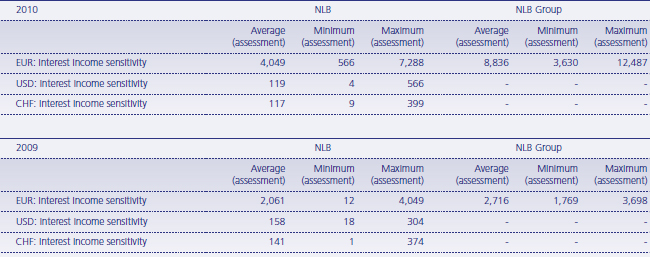
In 2010, the value of interest income sensitivity remained relatively stable, but was slightly more volatile than in
the previous year. Exposure to interest rate risks primarily derives from the portfolio of first-class debt securities
(ECB eligible), which represent a source of secondary liquidity. The exposure arising from classic loan-deposit
transactions was relatively low owing to the active management of these positions. The long-term interest rate
positions of other Group entities, from which the majority of interest rate risk derives, are relatively closed.
The values in the table have been calculated on the basis of monthly calculations of short-term interest rate gaps,
where the applied parallel shift of the yield curve by 50 basis points represents a realistic and practical scenario.
The “average” value represents the arithmetic mean of monthly calculations, while the “maximum” and
“minimum” values represent the highest and lowest values calculated during the period. Due to the expansion of
the data set, the data for 2010 are not directly comparable with 2009.
Risk of a change in prices in the portfolio of equity securities in the banking book
In terms of equity security investments, the Bank has adopted policies for management these investment that
were approved by the Management and the Supervisory Board. The policies relate to permitted investment
structure of the portfolio, its diversification, and the monitoring and measurement of risks. In addition to a
standardised methodology the Bank also uses an internal model, which has been adapted to the requirements of
the Basel standards, for monitoring and measuring the risks related to the equity portfolio.
The value of the equities portfolio in the banking book in the Bank amounted to EUR 188.5 million by the end of
2010 (December 31, 2009: EUR 215.5 million) of this EUR 139.5 million represented realized collateral and the
long-term portfolio represented in amount of EUR 25.2 million as available for sale financial asset and in amount
of EUR 23.8 million as financial asset designated at fair value through profit or loss. The value of VAR for the
equities portfolio in the banking book amounted to EUR 12.4 million by the end of 2010 (2009: EUR 20.1 million).
Assuming a fall in stock market indices or individual securities prices of 15%, the value of the portfolio would
decrease by 28.3 million.
Guidelines were prepared for the effective management of risks in the investment banking sector in the scope of
the NLB Group's financial instruments trading strategy. Trading in equity securities for subsidiaries is not permitted.
Only stock broking services are provided. The majority of the equity securities portfolio in the banking book
derives from the Bank's position, while smaller positions are also disclosed by certain NLB Group entities.
The value of equity portfolio in the Group stood at EUR 193 million at the end of 2010 (December 31, 2009: EUR
220.2 million) of this EUR 139.5 million represented realized collateral and the long-term portfolio represented in
amount of EUR 27.8 million as available for sale financial asset and in amount of EUR 25.7 million as financial
asset designated at fair value through profit or loss. Assuming a fall in stock market indices or individual securities
prices of 15% the value of the portfolio would decrease by EUR 29 million.
c) Currency Risk (FX)
The Group manages currency risks in accordance with the adopted currency risk management policy adopted by
the Bank’s Assets and Liabilities Committee. The positions of all currencies in the NLB’s statement of financial
position for which a daily limit has been set are monitored daily.
Exposure to currency risks is monitored and managed by the Assets and Liabilities Management Department on
the basis of daily data obtained from the Risk Management Department. Assets and Liabilities Management
Department manages exposure to currency risks by currency, so that they are always within the limits.
Exposure to currency risks is discussed at daily liquidity meetings and monthly meetings of the Bank’s Assets and
Liabilities Committee.
The amount of financial instruments denominated in euros and in foreign currency
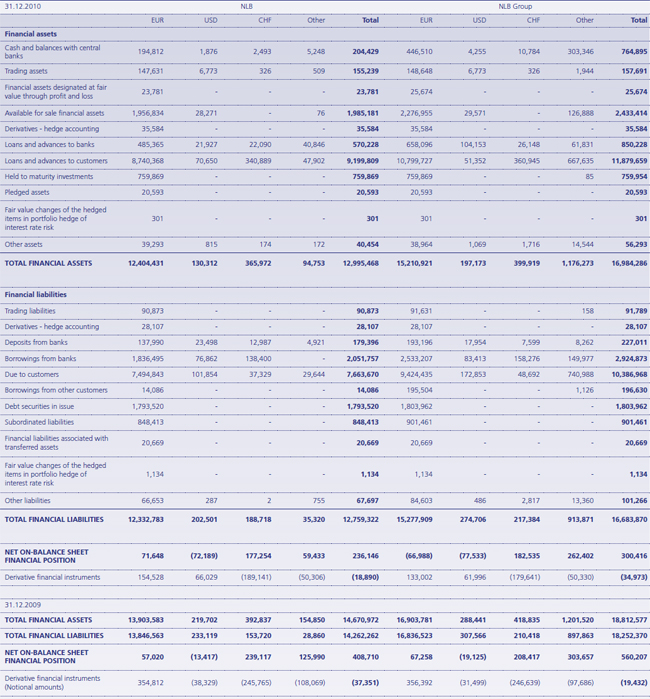
Click on image to enlarge
Sensitivity analysis for currency risk
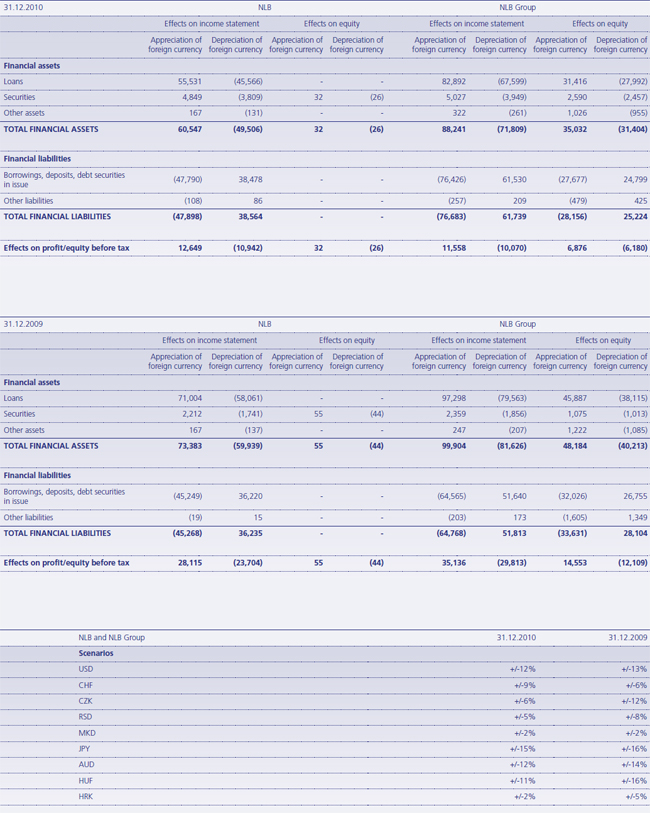
Click on image to enlarge
d) Interest rate risk
The management of interest rate risks in the NLB banking book is separated from the measurement and
monitoring of such risks. In the past, the Bank drafted and implemented an interest rate risk management policy,
which reflects a conservative strategy of assuming interest rate risks and is based on general Basel risk
management standards.
In the banking book, the Bank manages interest rate risks arising from interest-insensitive liability items and
interest-sensitive items without maturity (e.g. available capital and stable sight deposits) separately from all other
banking book transactions. The management of interest rate risks arising from interest-insensitive items and items
without maturity is provided by means of managing the securities portfolio of the banking book and determining
the upper limit of modified duration.
The management of interest rate risks arising from all other banking book transactions is provided by means of
managing the interest maturity of statement of financial position and off-balance sheet items, which the Bank
classifies by maturity buckets. The openness of position in individual maturity buckets in one direction or the
other, is defined in absolute amounts. According to the recommendations of the Basel guidelines, the same
restriction is applied to potential changes in the net present value of all interest-sensitive items.
The basic tool for the managing exposure to interest rate risk in the banking book is the management of the
Bank’s statement of financial position items. The strategies that foresee adequate adjustments to the statement of
financial position items are discussed and adopted at the executive level of the Bank or in the scope of the Bank's
Assets and Liabilities Committee. The Bank primarily uses the following methods for managing its statement of
financial position:
- managing the portfolio of debt securities in the banking book,
- issuing its own securities,
- introducing new banking products and special treatment of the existing products and
- managing the maturity of existing statement of financial position items.
The portfolio of debt securities of the banking book is subject to strict internal regulations defined in the policy of
managing debt securities in the banking book. In terms of interest rate risk management, the main purpose of this
portfolio is to stabilize the interest margin. In addition, the purpose of the securities portfolio of the banking book is to
maintain secondary liquidity reserves. The composition of the portfolio and the accounting classification of securities
are defined on the basis of permissible credit and non-credit risks and target management of the Bank's capital.
The Bank’s Assets and Liabilities Committee regularly discusses and supervises the adaptation of the offered range
and price ratios of banking products in order to limit interest rate risk exposure.
When limiting the exposure to interest rate risks, the Bank also uses the determination of adequate interest
maturity of its assets and liabilities.
More precise management of interest rate risk in the banking book is carried out by concluding transactions in
derivatives, using the following instruments:
- interest rate swaps,
- overnight index swaps,
- cross currency swaps,
- forward rate agreements and
- interest rate futures.
The management of the NLB Group’s interest rate exposure is not performed at the consolidated level. However,
the Bank promptly monitors the risks of individual banks in the Group. Guidelines regarding the limitation and
management of interest risks at individual NLB Group banks are in line with the guidelines of the NLB Group
Management Committee and with the Assets and Liabilities Committees of these banks.
Other members of the Group represent a small proportion, and thus do not have significant impact on the Group
as a whole.
Analysis of financial instruments according to the exposure to interest rate risk
Illustrated below are the carrying amounts of financial instruments, categorized by the earlier of contractual repricing or residual maturity.

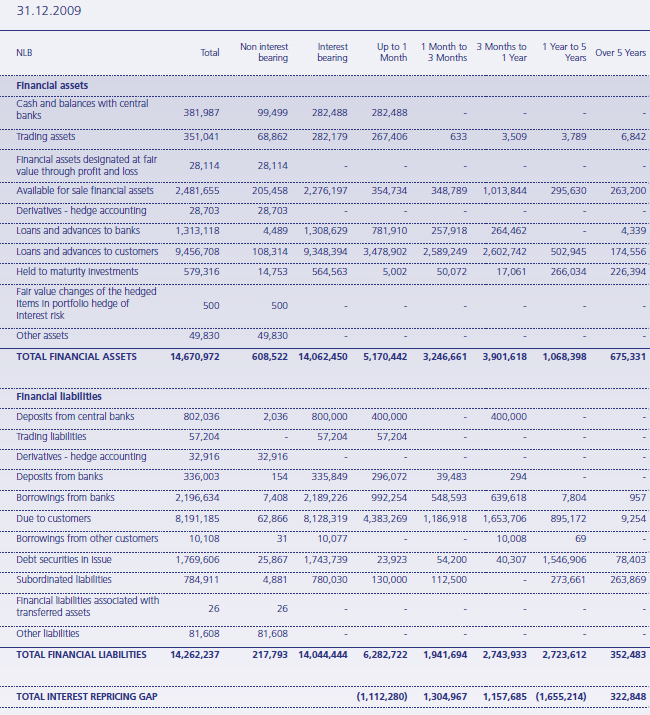
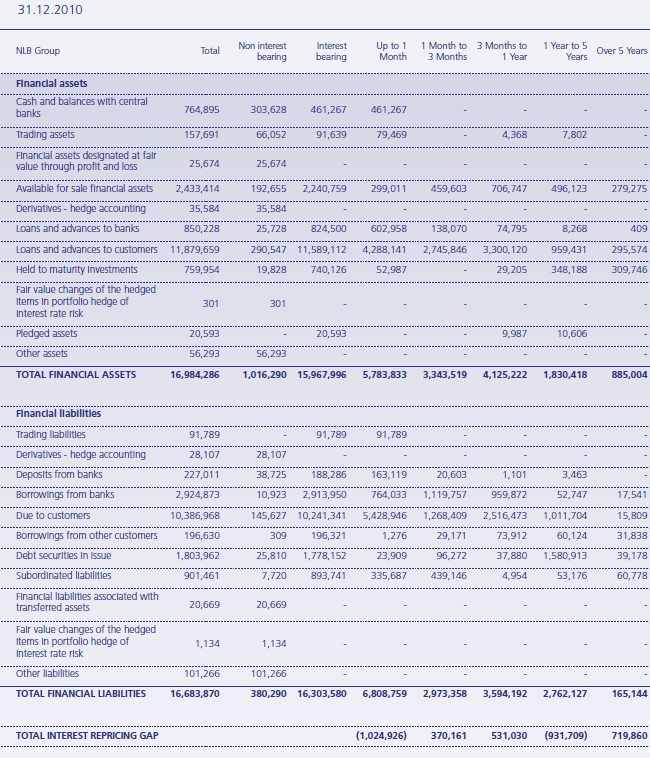
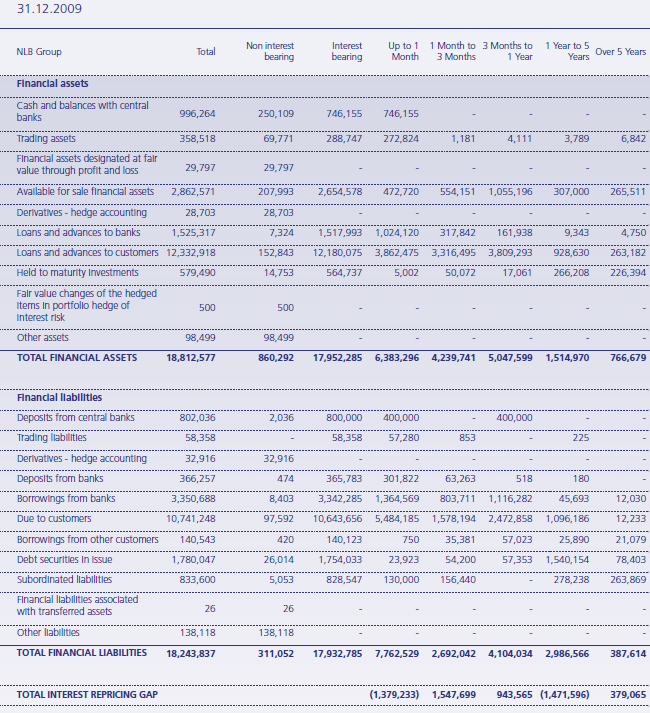
Sensitivity analysis for interest rate risk
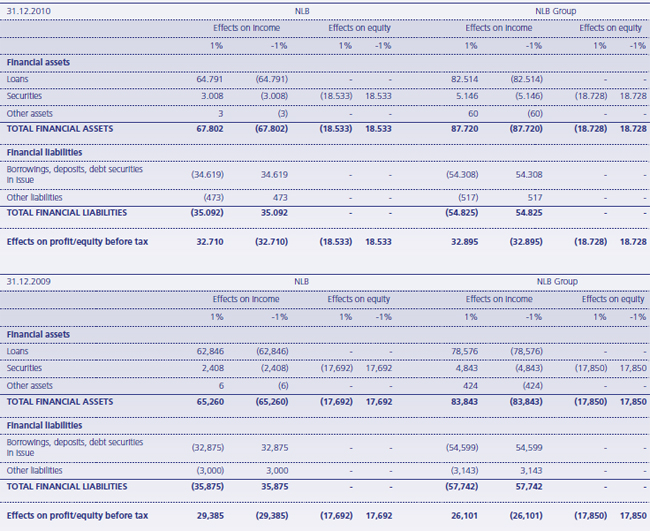
e) Liquidity risk
Liquidity risk management at Bank is based on the following documents:
- Bank’s liquidity risk management policy,
- the Bank's liquidity management plan in exceptional circumstances, and
- scenarios for liquidity management in exceptional circumstances.
The Bank's Assets and Liabilities Committee adopted the aforementioned documents.
Bank's liquidity risk management policy specifically defines the methods of measuring, monitoring and managing the
Bank's liquidity risk, liquidity management criteria and scenarios, and competencies and responsibilities.
The Bank's liquidity management plan in exceptional circumstances defines the guidelines and a plan of activities with
the aim of recognizing problems, searching for solutions and performing activities in exceptional circumstances, as well
as establishing a system for managing liquidity that ensures the Bank's liquidity is maintained and that the business
interests of the Bank's clients and shareholders are protected.
- ensure sufficient liquidity for the settlement of all the Bank’s liabilities, taking into account the criteria of rationality in the determination of the scope of liquidity reserves;
- ensure that the Bank's Assets and Liabilities Committee is regularly informed of the current and potential liquidity needs of the Bank;
- ensure adequate procedures and work methods for monitoring and managing the Bank's liquidity;
- ensure compliance of the policy with other internal documents regarding the Bank’s asset and liability management;
- ensure accurate understanding of the methods and situations in which liquidity reserves are used;
- establish a system of regular reporting to the Assets and Liabilities Committee and other competent bodies;
- ensure the compliance of the policy with the Bank’s liquidity management plan in exceptional circumstances; and
- ensure an adequate system of education and support regarding the Bank’s asset and liability management.
- the criterion of liquid assets or structure of the Bank’s statement of financial position;
- the matching of cash flows, and
- a combined approach, using the elements of both approaches (liquidity scale).
Based on the criterion of liquid assets, the Bank calculates, at least once a month, the structural liquidity indicators defined in the policy.
- daily, for operational purposes, for a period of at least one month,
- monthly – cash flows simulations, taking into account all known and expected cash flows, and
- monthly – plans of liquidity gaps for different time periods, taking into account several scenarios.
- a daily report based on the Bank of Slovenia's Regulation on the Minimum Requirements for Ensuring an Adequate Liquidity Position at Banks and Savings Banks, and
- a simulation of the changes in liquidity ratios for the months to come.
- at the operational level,
- at the structural level, and
- in exceptional circumstances.
- the Bank’s cash flow planning and monitoring,
- the drafting of several scenarios of the Bank’s cash flows,
- monitoring and ensuring compliance with the central bank’s regulations regarding liquidity,
- compiling daily and other regular reports for the management of the business line and the Bank, as well as the decision-making bodies,
- the drafting of liquidity stress test scenarios,
- ensuring adequate technological support for the reliable and efficient monitoring, planning and management of cash flows, and
- the drafting of proposals for improvements and changes in the management of the Bank’s operational liquidity.
- determining structural liquidity indicators and their regular calculation and monitoring,
- defining optimal and/or thresholds of individual selected structural liquidity indicators,
- monitoring of trends in the selected structural liquidity quotients,
- monitoring liquidity gaps according to time intervals (static aspect) and preparing simulations (dynamic aspect), and
- preparing analyses and proposals for changes in the structure of the Bank’s statement of financial position that affect the Bank's liquidity position and liquidity risk.
The goal of liquidity management at the structural level is to achieve a structure of the Bank's statement of financial position that will ensure the Bank’s long-term liquidity based on maturity matching, the forms and concentration of sources of financing, and the realization and rating of assets.
- preparing the Bank's liquidity management plan in exceptional circumstances,
- monitoring the conditions of the Bank’s operations that could affect the methods, possibilities and quality of liquidity risk management at the Bank, and
- implementing activities defined in the Bank's liquidity management plan in exceptional circumstances.
The Bank’s liquidity position is discussed daily at liquidity meetings of the NLB Group's Financial Markets and Treasury
department. As a rule, the Assets and Liabilities Committee discusses the liquidity position and structure of the Bank’s
balance monthly. In the event of exceptional circumstances, these issues are also discussed by the Management Board
and the operational working group for monitoring liquidity in accordance with the provisions of the Bank's liquidity
management plan in exceptional circumstances.
The fundamental bases and principles of liquidity risk management at the NLB Group are defined in the NLB Group's
liquidity risk management strategy.
- the competent and responsible persons/departments,
- the criteria and methods of liquidity management in normal and exceptional circumstances,
- the organizational aspect of liquidity risk management,
- the criteria and levels of liquidity risk management, separately for banking and non-banking Group entities, and
- the method and system of reporting.
- provide sufficient liquid assets for settling all mature obligations of Group entities;
- correctly plan the less predictable future and off-balance-sheet liabilities of Group entities;
- optimize the balance of liquidity reserves, i.e. the ratio between safety and profitability; and
- avoid situations in which the Group is forced to provide the necessary liquid assets at prices that are significantly higher than those on the market.
The NLB Group companies are each fully authorized and responsible for their own liquidity risk management, for ensuring their own liquidity and for complying with the local regulations on liquidity management. NLB is authorized and responsible for establishing a system that facilitates centralized liquidity risk monitoring and measuring, and for managing liquidity risk at the Group level. When managing liquidity risk, NLB Group entities must follow the guidelines issued by the Bank and applying to Group entities.
- planned cash flows by day for the next 30 days,
- an annual liquidity plan by month,
- regular monthly notices of liquidity needs,
- regular quarterly notices of liquidity needs,
- a calculation of liquidity gaps for banking and non-banking members,
- structural liquidity indicators,
- cooperation of members in providing liquidity sources,
- the liquidity reserves of banking members, and
- cash flow matching by the criterion of residual maturity for non-banking members of the NLB Group.
Group companies calculate structural liquidity ratios (concerning assets, liabilities and relationships among them) and their thresholds, which are an indicator of structural imbalances in liquidity management. Limits, which are confirmed by management, are also established.
- daily funding and the regular monitoring of future cash flows to ensure that obligations can be settled. These include the replenishment of funds as they mature or are borrowed by customers. To that end, the Group maintains an active presence on global money markets;
- maintaining a portfolio of highly-liquid securities that can be readily sold in the event of a cash shortfall;
- monitoring liquidity ratios and their comparison against internal and regulatory requirements, and
- managing the maturities of the Group's liabilities.
Monitoring and reporting take the form of cash flow monitoring and projections for the next day, week and month
respectively. The basis for those projections is an analysis of the contractual maturity of financial liabilities and the
expected collection date of financial assets.
The Group also monitors the mismatching of current assets, the level and type of undrawn lending commitments, the
usage of overdraft facilities and the impact of contingent liabilities such as letters of credit and guarantees.
Non-derivative cash flows
The tables below illustrate the cash flows from non-derivative financial instruments by residual maturities at the end of the year. The amounts disclosed in the table are the undiscounted contractual cash flows, determined on the basis of spot rates at the end of the reporting period.
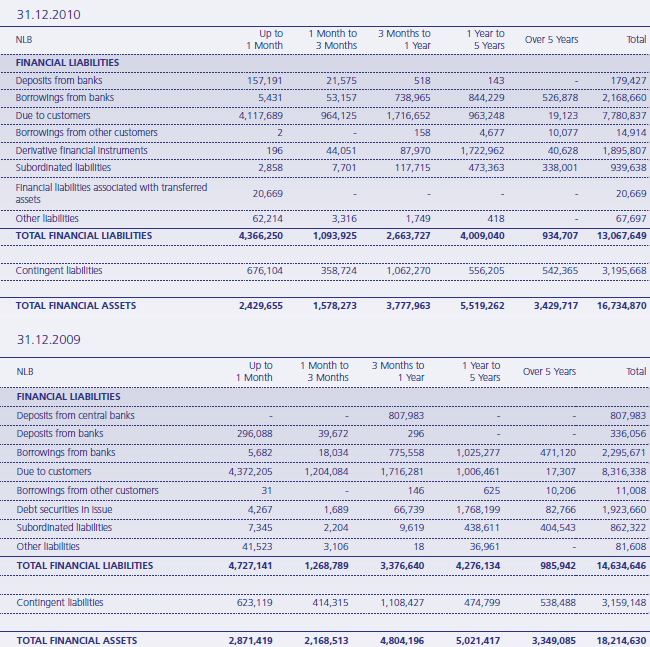
When determining the gap between the financial liabilities and financial assets in the maturity bucket of up to 1 month, it is necessary to take into account the fact that financial liabilities include total demand deposits, and that the Bank may apply a stability weight of 50% to demand deposits when ensuring compliance with the central bank regulations concerning the calculation of the liquidity position. To ensure the Bank’s and Group’s liquidity and based on its conservative approach to risk, the Group compiled in previous years a substantial amount of high-quality liquid investments, mostly government securities and selected loans, which are accepted as adequate financial assets by the ECB.
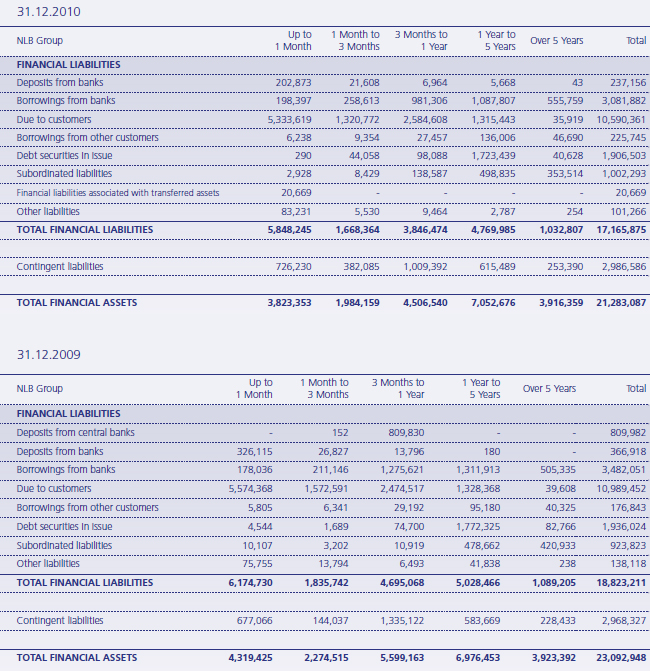
Subordinated liabilities with no contractual maturity are included in maturity buckets based on when the Group
may exercise call options in accordance with the conditions described in note 6.19.
An analysis of the statement of financial position by residual maturity based on discounted cash flows is presented
in table below.
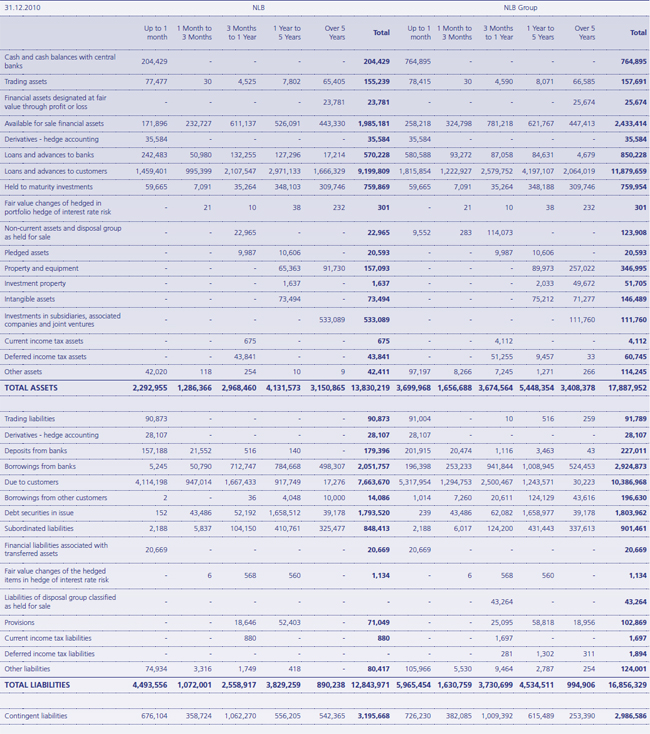
Click on image to enlarge
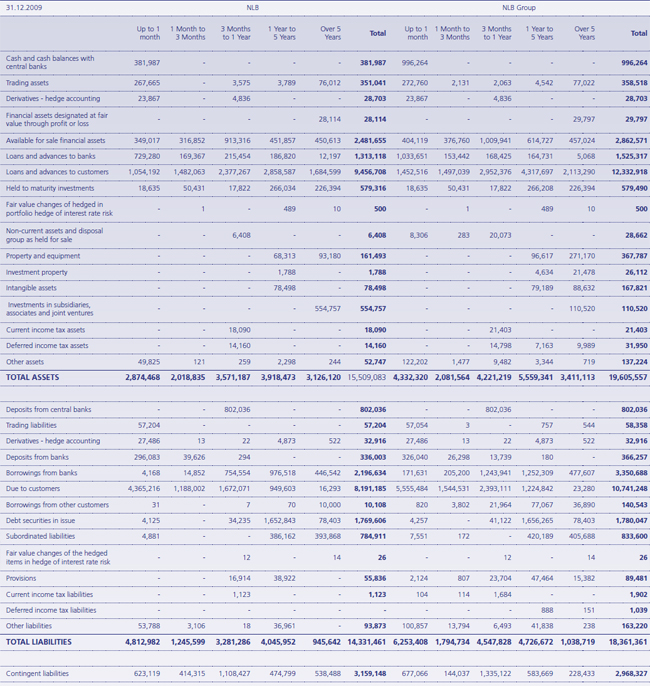
Click on image to enlarge
Derivative cash flows
The Group’s derivatives are settled on a gross basis, except for certain interest rate swaps. The table below illustrates cash flows from derivatives, broken down into the relevant maturity buckets based on residual maturities. The amounts disclosed in the table are the contractual undiscounted cash flows, prepared on the basis of spot rates on the reporting date.
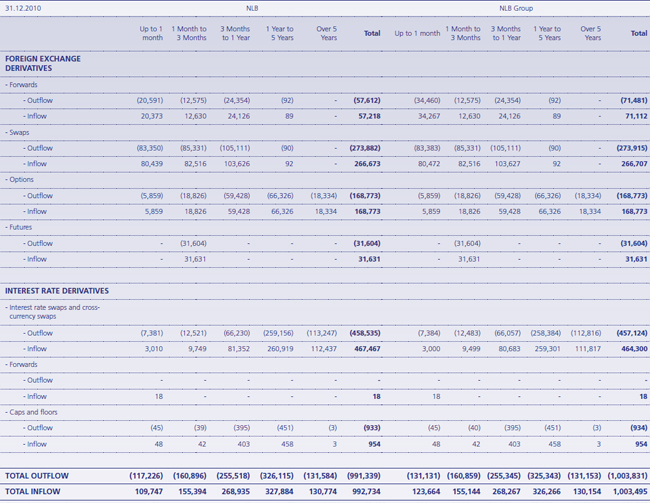
Click on image to enlarge
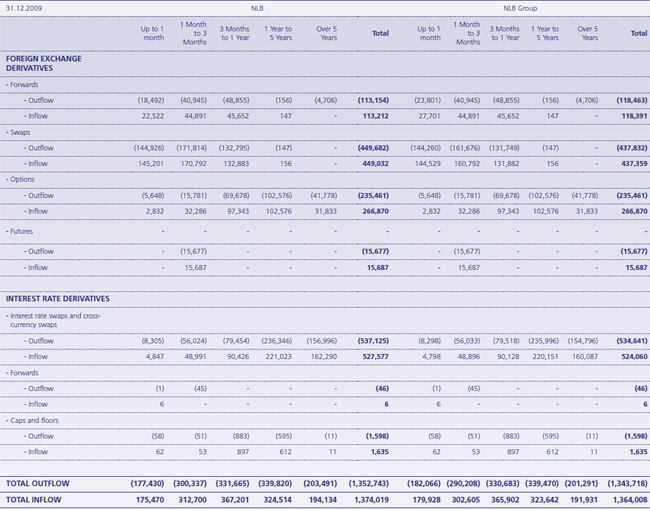
Click on image to enlarge
Managing the Bank’s secondary liquidity reserves
The Bank considers high-quality securities and ECB-eligible loans, on the basis of which it is possible to raise liquid
assets on the market or at the central bank, as secondary liquidity reserves. The extent of secondary liquidity
reserves depends on the liquidity needs of NLB and the NLB Group.
At the end of 2010, the balance of ECB-eligible loans amounted to EUR 785 million an increase of EUR 87 million
on the end of 2009. The total balance of secondary liquidity reserves as at December 31, 2010 amounted to EUR
3,413 million (December 31, 2009: EUR 3,545 million). ECB eligible loans include government-guaranteed loans
and loans to government agencies.
Debt securities are classified into the trading or banking book depending on the purpose of their acquisition and
on the intended manner of disposal. Securities that the Group acquires principally for generating profits as the
difference between purchase price and selling price are classified in the trading book. Securities in the trading
book are always classified in the financial statements as financial assets held for trading.
The debt securities portfolio of the banking book is also used simultaneously for providing secondary liquidity,
stabilizing the interest margin and managing the Bank’s interest rate risk. Securities in the banking book are
classified as “available for sale” or “held to maturity”. When managing the portfolio, the Bank uses conservative
principles, particularly with respect to the structure of the portfolio in terms of issuers’ ratings and the maturity of
portfolio. The framework for managing the securities of the banking book is the policy for managing debt
securities in the banking book, which clearly defines the objectives and characteristics of the associated portfolio.
- the securities with a fixed interest rate must account for at least 75% of the total portfolio in order to stabilize the Bank’s interest margin;
- the majority of the securities must comprise securities that can be pledged with the ECB, i.e. are on the list of eligible financial assets at the ECB; a maximum of EUR 250 million in securities can be outside aforementioned list;
- modified portfolio duration is calculated semi annually and may not exceed 3 years;
- a maximum of 40% of the total value of the portfolio can be classified as “held to maturity”;
- there may be no more than EUR 600 million of bank, corporate or structured securities; and
- there may be no more than EUR 100 million of structured securities.
As at December 31, 2010, the balance of securities in the banking book was EUR 2,601 million or EUR 272 million
less than at the end of 2009. Of these, 80.4% were government securities, 12.6% were government-guaranteed
bank bonds, 0.7% multilateral institution bonds and 6.3% bank and corporate securities. There are no structured
securities in the banking book. The majority of securities were invested in Slovenian government securities
(31.2%), followed by French (11.8%), Belgian (10.3%), Dutch (10.3%), Austrian (6.2%) and German (3.8%)
government securities, and non-government securities guaranteed by the Republic of Slovenia (10.8%). Securities
issued by Portugal, Ireland, Italy, Greece and Spain represent 6% of the banking book securities portfolio. Around
60% of these securities will mature in 2011. In 2010 debt securities in the banking book were neither past due
nor impaired.
EUR 1,841 million (71%) of securities were classified as available for sale and EUR 760 million (29%) as held to
maturity. Taking into account hedging of the portfolio of securities via interest rate derivatives, the modified
maturity of the banking book portfolio increased from 1.4 years in 2009 to 1.96 years in 2010.

The portfolio of debt securities in the banking book is intended to provide secondary liquidity and manage the
Group’s interest rate risk. When managing the portfolio, the Group uses conservative principles, particularly with
respect to issuers’ ratings and the maturity of the portfolio.
Structure of the banking book according to Fitch ratings:
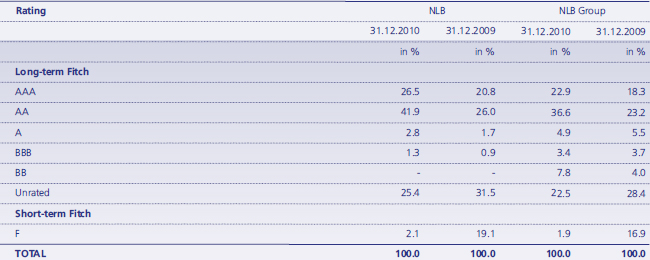
Most of securities with no external rating are high quality treasury bills (Germany, Netherland, France, Belgium
and other European countries) and Slovenian securities with the guarantee of the Republic of Slovenia. Relatively
small part presents bank and corporate securities.
The value of bonds in the Bank's trading book amounted to EUR 13 million as at December 31, 2010 (December
31, 2009: EUR 15 million), while in the Group amounted to EUR 15 million (December 31, 2009: EUR 23 million).
The Bank also holds certificates of deposits from domestic banks that as at December 31, 2010 amounted to EUR
0.4 million, the same last year. As at December 31, 2009 the Bank held commercial bills which amounted to EUR
200 million, mainly rated with »AA« and »A«. As at December 31, 2010 the bank did not hold these instruments
and consequently the structure according to ratings has changed.
Structure of the trading book according to internal ratings:
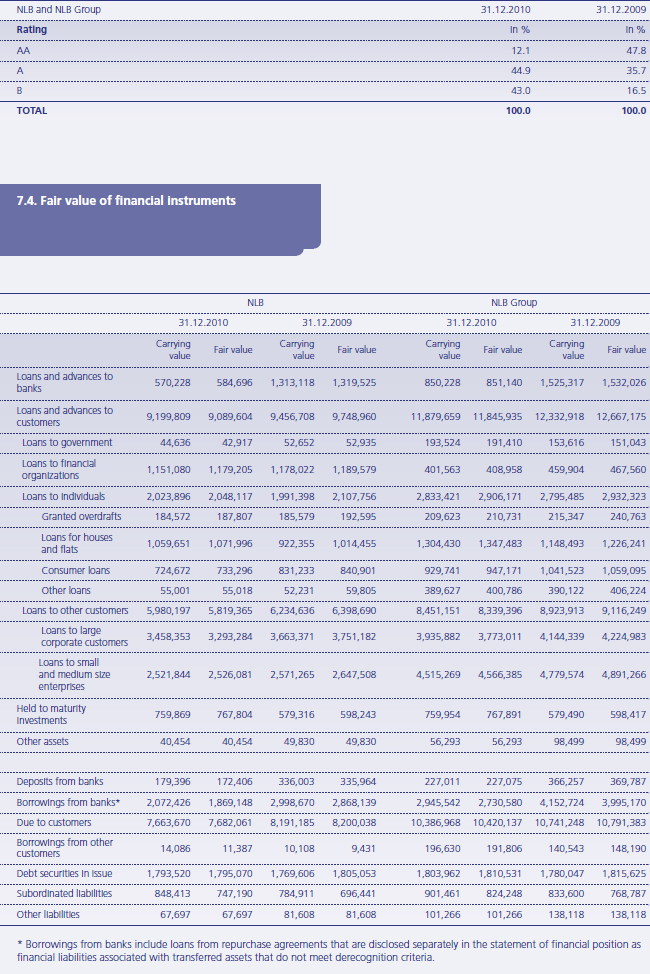
Loans and advances to banks
The estimated fair value of deposits is based on discounted cash flows using prevailing money market interest
rates for debts with similar credit risk and residual maturities. The fair value of overnight deposits equals their
carrying value.
Loans and advances to customers
Loans and advances are net of the allowance for impairment. The estimated fair value of loans and advances
represents the discounted amount of estimated future cash flows expected to be received. Expected cash flows
are discounted at current market rates to determine their fair value.
Deposits and borrowings
The fair value of sight deposits and overnight deposits is equal to their carrying value. However, their actual value
for the Group depends on timing and amounts of cash flows, current market rates and the credit risk of the
depository institution itself. A portion of sight deposits is stable, similar to term deposits. Therefore, their
economic value for the Group differs from the carrying amount.
The estimated fair value of other deposits is based on discounted cash flows using interest rates for new deposits
with similar residual maturities.
Held to maturity investments and issued debt securities
The fair value of held to maturity investments and issued debt securities is based on their quoted market price or
value calculated by using a discounted cash flow method and prevailing money market interest rates.
Loan commitments
For credit facilities that are drawn soon after the Group grants the loans (drawn at market rates) and loan
commitments to those clients that are not impaired, the fair value is close to zero. For loan commitments to
clients, that are impaired, the fair value represents the amount of the provisions built.
Other financial assets and liabilities
The carrying amount of other financial assets and liabilities is a reasonable approximation of their fair value, as
they relate mainly to short-term receivable and payables.
8. OTHER DISCLOSURES
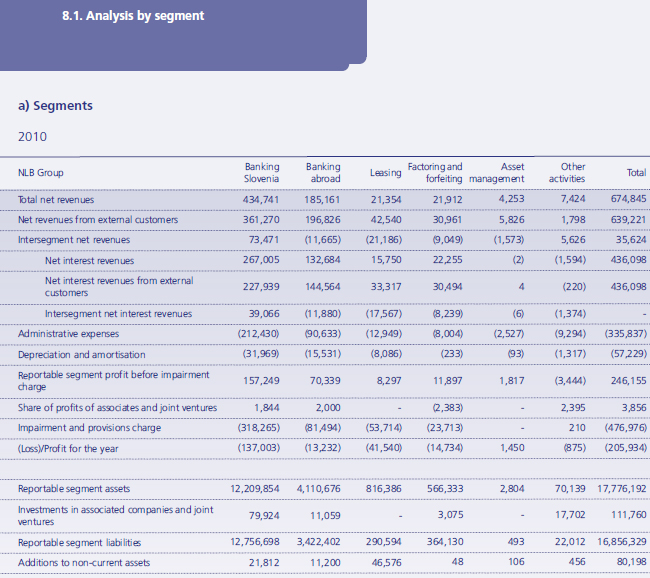
For the purpose of management reporting, the Group's operations are divided into five main segments:
- banking in Slovenia,
- banking abroad,
- factoring and forfeiting,
- leasing,
- asset management.
Entities in NLB Group are classified into segments on the basis of their business activity, so that the contribution of
each entity is allocated to one segment only.
Due to differences in the level of development in national bank systems, banking is split into two segments:
Slovenia and other markets. Segmentation is based on the location of each bank’s headquarters, regardless of
their actual business activities. Slovenian banking segment consists of parent bank NLB and the associate Banka
Celje (the contribution of the latter to the Group’s results is based on the equity method of accounting). All the
other banks in the NLB Group are included in the segment banking abroad.
The segment of other activities includes insurance and other supporting operations (e.g. provision of services
related to the processing of cards, ATM machines and POS terminals, property management, maintenance,
catering and tourism services).
Since NLB Group is primarily a financial group and interest income represents the majority of the Group’s income,
the main indicators of a segment’s efficiency are net profit before provisions and impairments and net profit.
The results of the Banking abroad segment for 2010 include the impairment of goodwill and customer
relationship in the amount of EUR 12,146 thousand (detailed explanation in note 6.13.).
Since each individual entity is included as a whole in a single segment and is not divided in to several segments,
actual inter-company transactions between Group entities are considered transactions between segments. The
amount of net income arising from transactions between segments is disclosed in the item “Intersegment net
revenues”. Net revenues from external customers correspond to the consolidated net revenues of the Group.
There were no revenues from transactions with a single external customer that amounted to 10% or more of the
Group’s revenues.
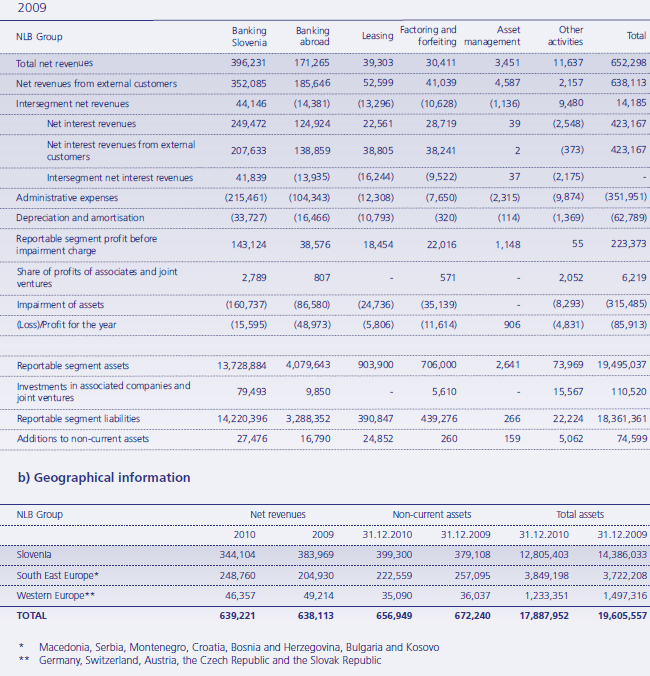
Geographical analysis includes a breakdown by geographical segments with respect to the country in which individual Group entities are located.

A number of banking transactions are entered into with related parties in the normal course of business. The volume of related-party transactions and the outstanding balances at year-end are as follows.
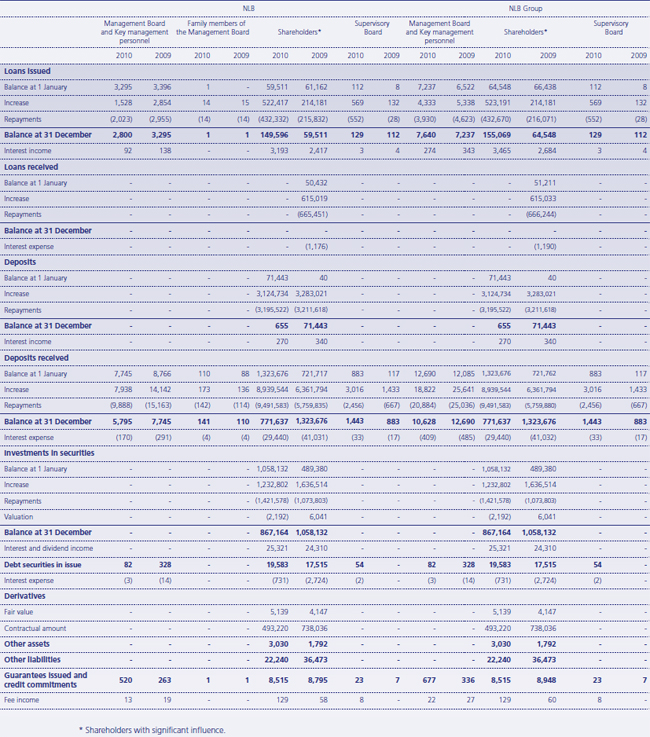
Click on image to enlarge
In year 2010 the Bank entered into transactions with the government related entities under usual terms and market prices. Individually significant transactions with government related entities present long-term loans and borrowings and interest rate swaps. As at December 31, 2010 the total amount of individually significant transactions for longterm loans (6 transactions) in the amount of EUR 627,138 thousand, long-term borrowing (7 transactions) in the amount of EUR 419,299 thousand and interest rate swaps (4 transactions) in the amount of EUR 213,155 thousand. For long-term loans, the Bank recognized interest income in the amount of EUR 13,901 thousand, for long-term borrowing interest expense in the amount of EUR 8,511 thousand and for interest rate swaps net interest income in the amount of EUR 568 thousand and net losses in the amount of EUR 15,000 thousand from valuation.
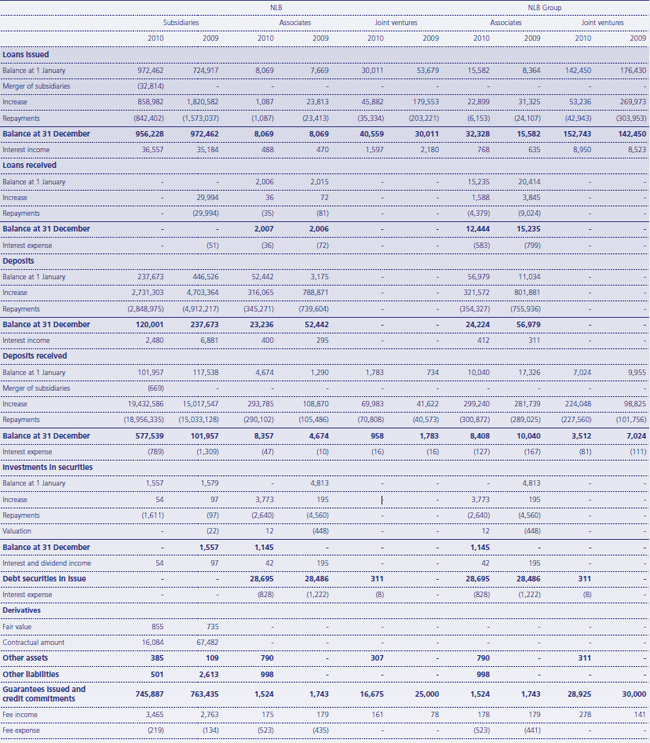
Click on image to enlarge
Key management compensation
The basis for the collective remuneration of members of the Management Board is several quantitative indicators that compare:
- the operations of NLB and the NLB Group with respect to the plan;
- the operations of NLB and the NLB Group with respect to the previous year;
- the operations of NLB with respect to banks in Slovenia during the same year; and
- the operations of the NLB Group with respect to comparable banking groups during the same year.
The basis for the individual remuneration of members of the Management Board (qualitative part) is individual assignments from the work program for individual year.

Click on image to enlarge
Short-term benefits include:
- monetary benefits (gross wages, supplementary insurance, holiday bonus, other bonuses); and
- non-monetary benefits (company cars, health care, apartments, etc.).
The reimbursement of cost comprises food allowance and travel expenses.
Post-employment benefits include additional pension insurance and annuity savings.
Accrued earnings of individual members of the Management Board
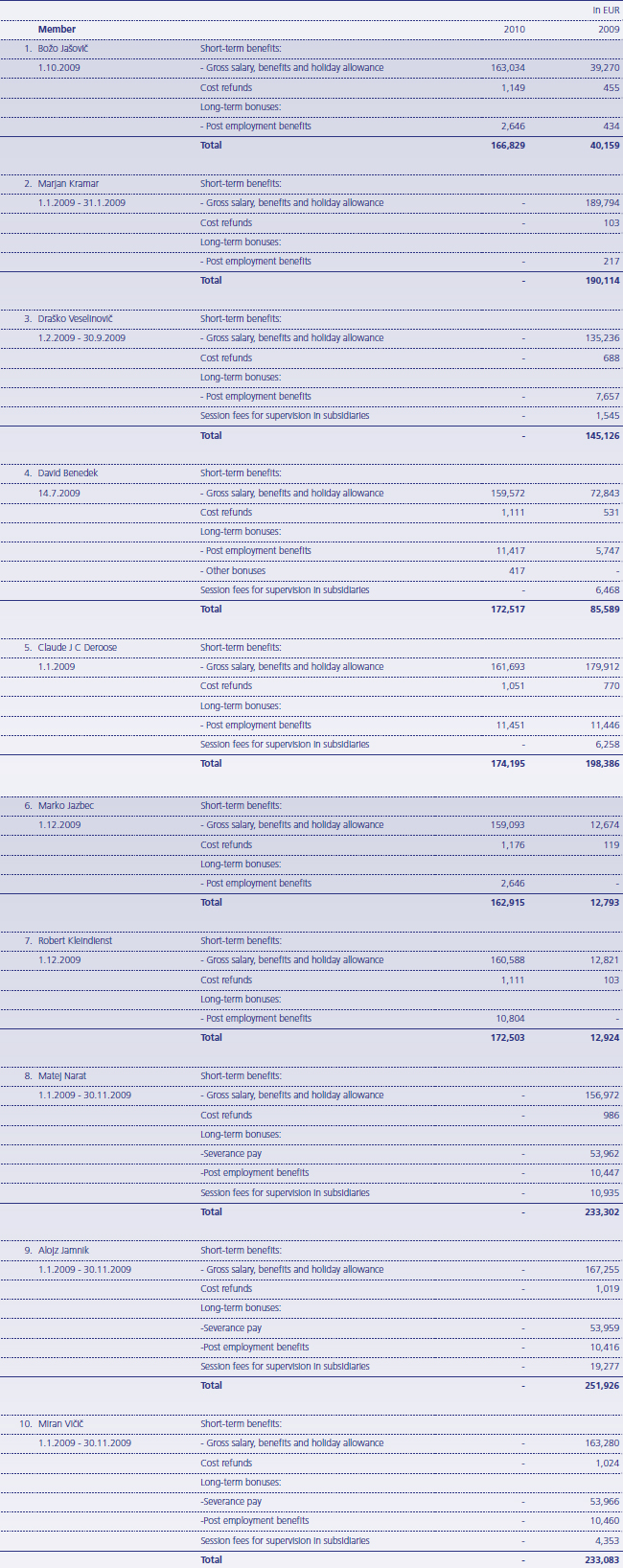
Accrued earnings of individual members of the Supervisory Board
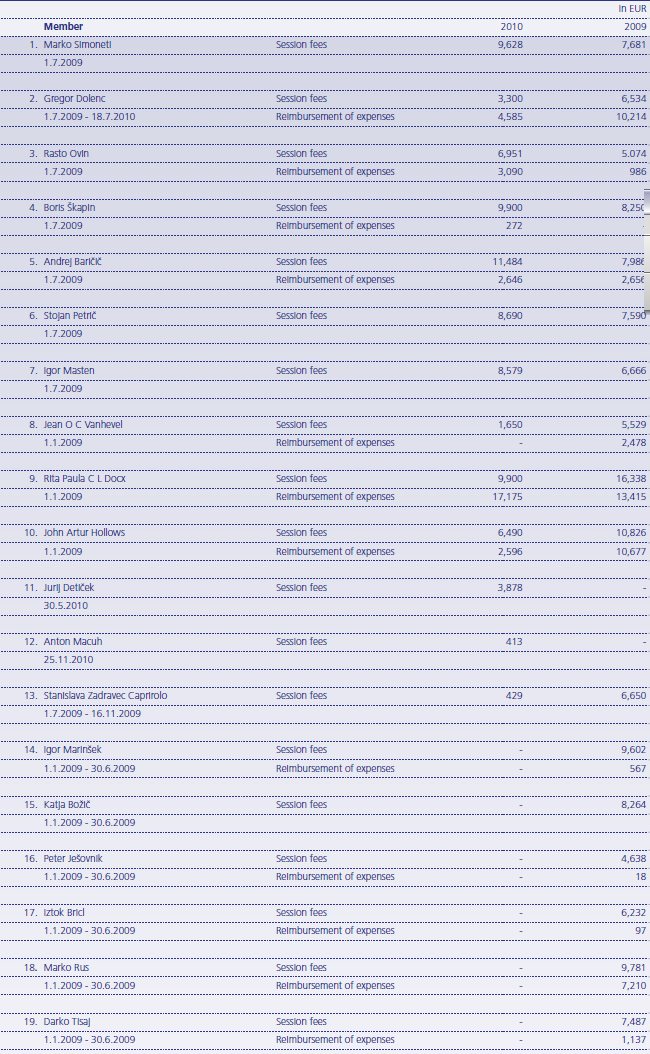
Annual Report 2010